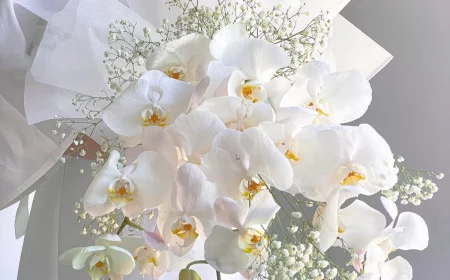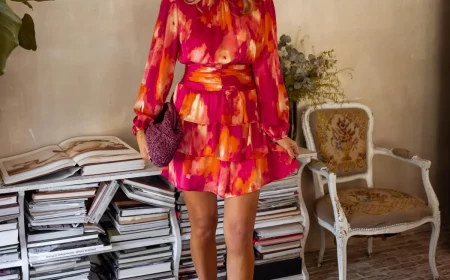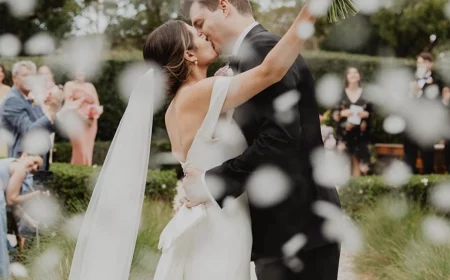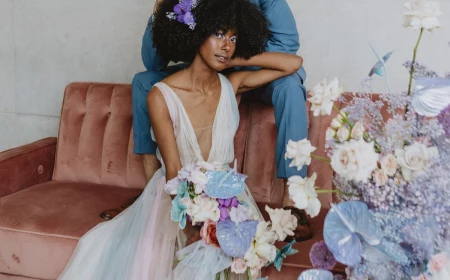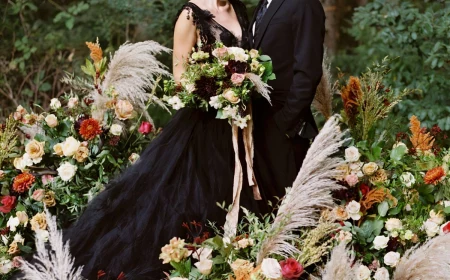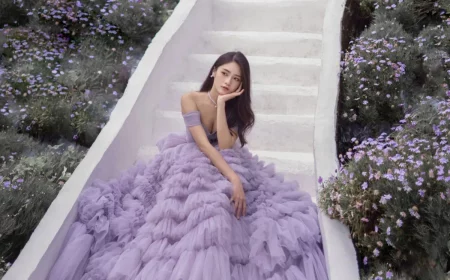The Real Talk on Gold Bridesmaid Dresses (and How to Not Get It Wrong)
I’ve been in the wedding world for a long, long time, and I’ve seen trends go from “must-have” to “what were we thinking?” in a flash. But gold? Gold is different. It has this incredible warmth and richness that just sticks around. When it’s done right, it’s pure magic.
In this article
But honestly, I’ve seen it go spectacularly wrong, too. I’m talking about beautiful bridesmaids looking totally washed out, or stunning wedding photos ruined by the glare of cheap, shiny fabric. Choosing gold isn’t as simple as picking a color off a chart; it’s a technical game of fabric, light, and skin tones.
So, this isn’t about what’s trendy right now. This is the practical, no-fluff advice I give my own clients. It’s about making a smart choice so your entire bridal party looks cohesive and elegant, and—most importantly—so every single person feels genuinely comfortable and confident. We’re going to cover everything from how different fabrics catch the light to the nitty-gritty of ordering and alterations. Let’s get you ready to choose gold dresses that look incredible in person, in your venue, and in your photos for years to come.
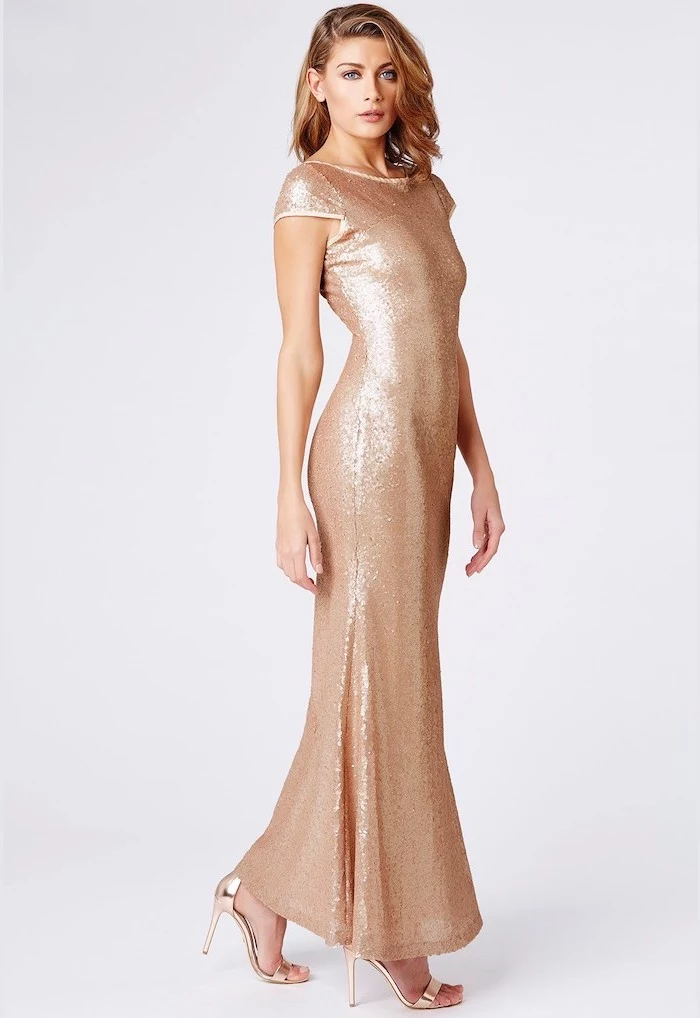
First Things First: “Gold” Isn’t a Single Color
Okay, let’s clear this up right away. The number one mistake people make is thinking “gold” is just one color. It’s a whole spectrum, and picking the right tone is the absolute foundation of your look. This decision should hinge on your wedding’s color palette, the lighting at your venue, and, of course, your bridesmaids’ skin tones.
A quick tip before we even start: Always, and I mean ALWAYS, look at large fabric swatches in natural daylight. The harsh fluorescent lighting in a shop can be so misleading.
- Yellow Gold: This is that classic, sunny, bright gold. It’s bold, it’s celebratory, and it’s perfect for a more formal, black-tie kind of wedding. Heads up, though: it can be a bit much on very fair or cool-toned skin. It really sings on bridesmaids with warmer, olive, or deeper skin tones.
- Rose Gold: Everyone loves rose gold for a reason. It has a soft pink or coppery undertone that makes it incredibly versatile. To be frank, it flatters the widest range of skin tones out there, from the palest to the deepest. The pinkish hue gives it a romantic, modern vibe.
- Antique Gold: This is my personal favorite for a sophisticated look. It’s a deeper, more muted gold, often with hints of bronze or brown. It feels less like a shiny metal and more like a rich, aged heirloom. It’s a knockout choice for rustic, vintage-inspired, or autumn weddings because it’s less likely to clash with an ivory or cream bridal gown.
- Champagne: This is the lightest, most subtle option. Think of it as gold’s elegant, understated cousin, with pale yellow and beige undertones. Champagne is a safe bet that works almost like a neutral. It complements nearly every skin tone and is perfect if you want a touch of warmth without going full-on metallic.
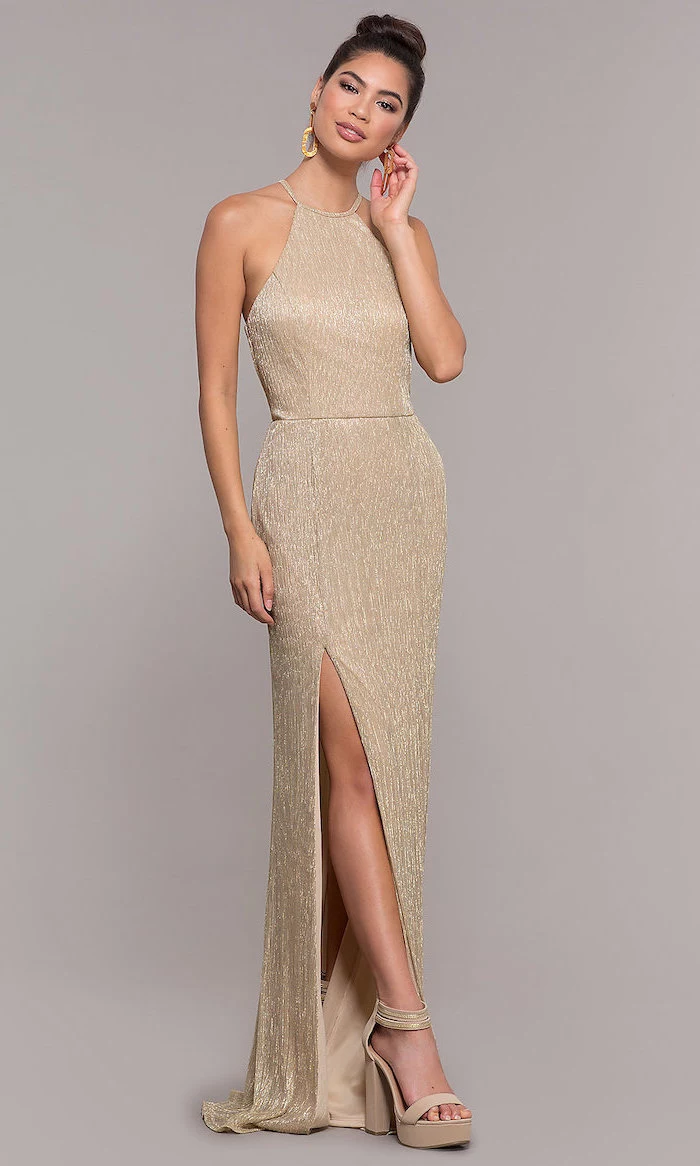
Why Fabric Changes Everything
Here’s a secret not many people realize: the same “yellow gold” dye will look completely different on five different fabrics. It all comes down to texture and finish. When someone tells me they want gold, my first question is always, “What kind of feel are you picturing?” The fabric really dictates the mood.
Satin and Charmeuse: These give you that high-shine, liquid metal effect. Light bounces right off, which can be stunning but also very unforgiving. A cheap polyester satin is often the culprit behind that harsh, brassy glare in photos. If you go this route, look for a heavier-weight duchess satin for a more luxe, subtle luster. Oh yeah, and undergarments? You’ll need seamless ones, because satin shows everything.
Sequins: The ultimate statement! Sequin dresses can be incredible, but quality is key. The size of the sequin changes the look—big ones are bold and disco-ball-esque, while tiny micro-sequins offer a more refined, all-over shimmer. A word of warning from experience: a common issue with cheaper sequin dresses is unlined armholes. This causes what we call “sequin rash,” and it’s painfully real. A good quality dress from a store like BHLDN or Revelry will have a soft lining or chiffon panel in the underarm. This is a non-negotiable for comfort!
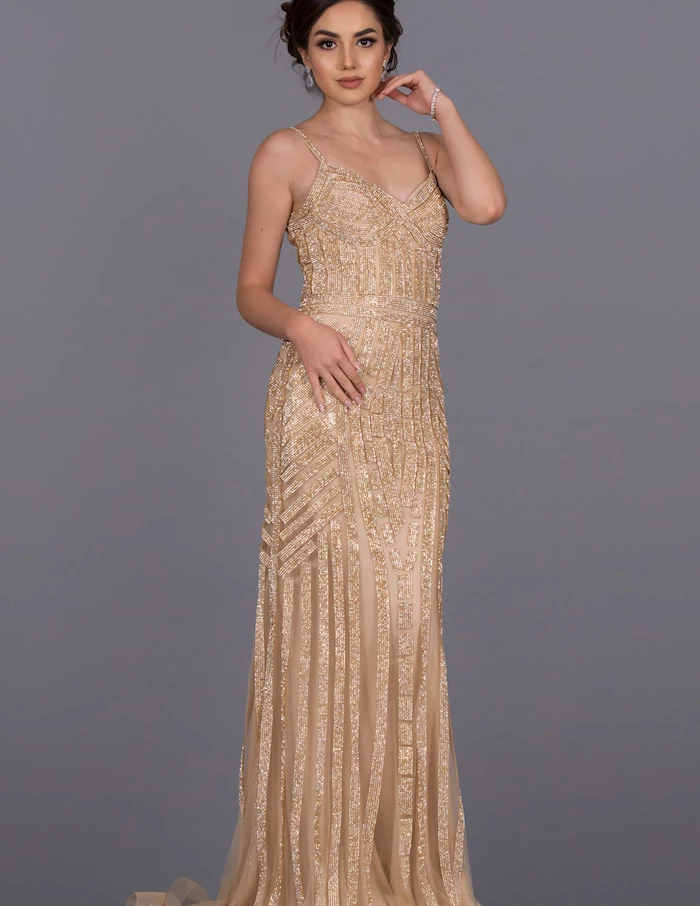
Chiffon and Georgette: These lightweight fabrics give you a soft, matte color instead of a metallic shine. A “gold” chiffon dress will really be a beautiful marigold or ochre hue. They’re comfortable, breathable, and super flattering, which makes them a great choice for warm-weather weddings. They’re also pretty forgiving, so undergarment choice is a bit easier.
Metallic Knit or Lurex: This is such a clever option. Lurex is a metallic thread that’s woven right into a soft, stretchy fabric. You get a subtle, all-over glimmer without the weight of sequins. It’s comfortable, photographs beautifully without creating harsh reflections, and is often a more budget-friendly choice, found at places like Lulus.
Velvet: For a fall or winter wedding, you just can’t beat the richness of gold velvet. The deep texture absorbs light, creating these gorgeous deep shadows and rich highlights. It’s warm, incredibly comfortable, and just feels so luxurious. It’s perfect for that antique or moody gold vibe.
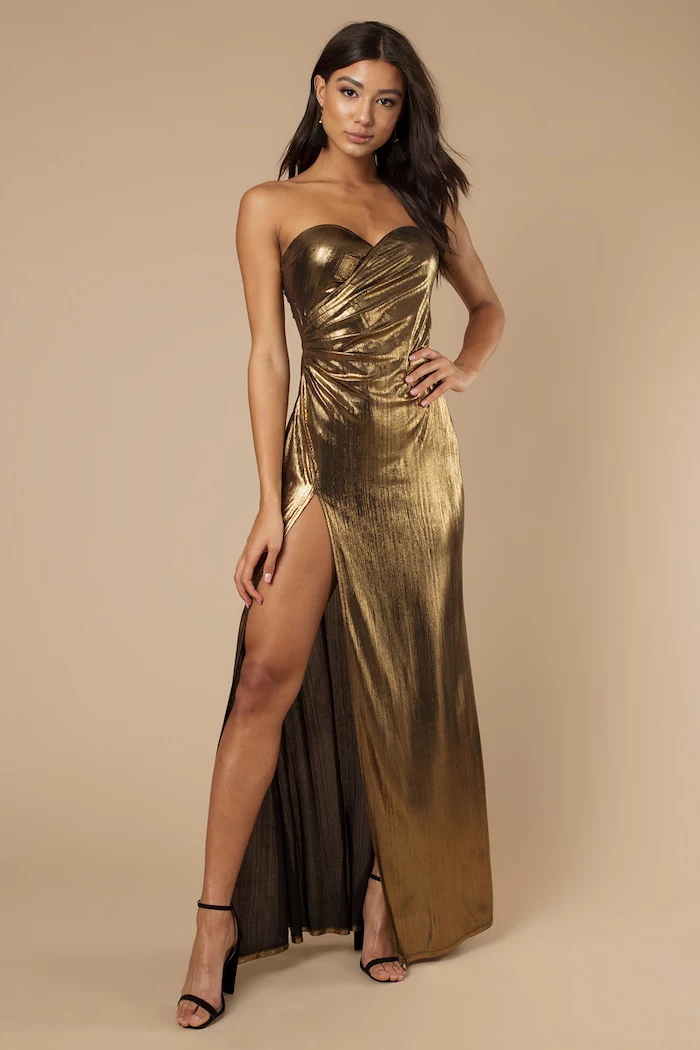
How to Get a Cohesive Look Without Making Everyone Identical
Forcing everyone into the exact same dress is a bit of an outdated concept, and for good reason! The most stunning bridal parties I’ve seen happen when the bride provides a clear vision but allows for a little individuality. Here are the three main ways to do it.
Method 1: The Unified Approach (Same Color, Different Styles)
This is probably the most popular and foolproof method. It guarantees a unified look while letting everyone pick a style that flatters their body type.
Here’s how to nail it: You choose the one designer, the one fabric, and the one color. For instance, “Antique Gold Matte Crepe from Azazie.” This is critical—different brands’ “antique gold” will NOT match. Then, you give your bridesmaids 3-5 pre-approved styles from that specific collection to choose from (a V-neck, one with sleeves, a high-neck, etc.). Everyone gets a silhouette they feel great in, and you get that perfectly coordinated look.
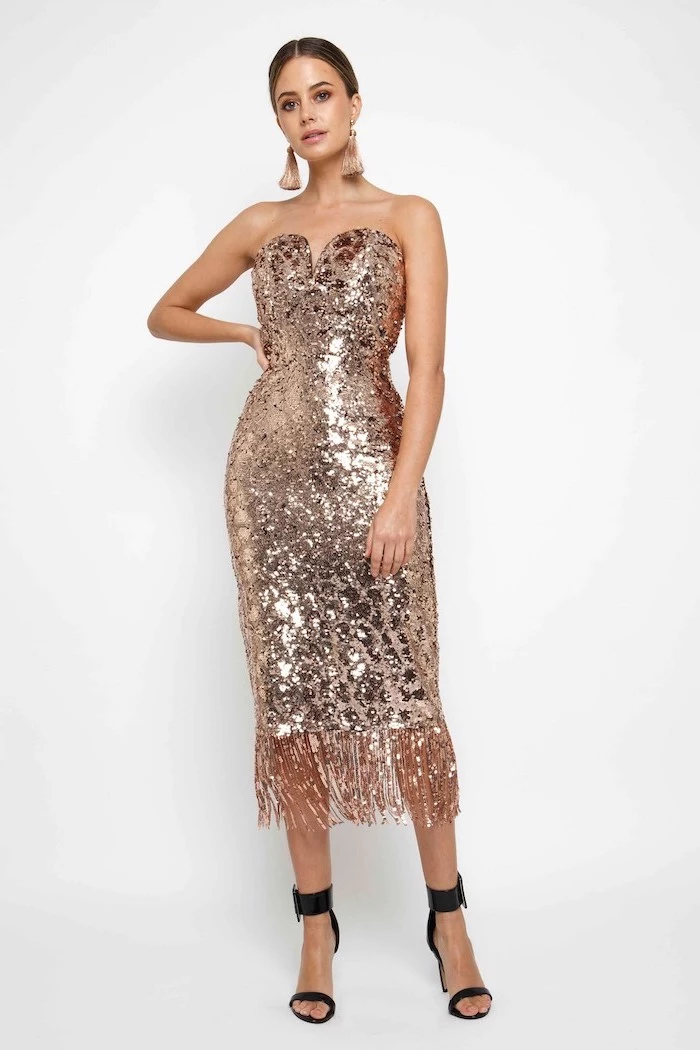
Method 2: The Tonal Approach (Same Fabric, Different Tones)
This creates a gorgeous, sophisticated ombré effect. It’s a bit more advanced, but when it works, it’s a showstopper.
Here’s how to nail it: First, pick ONE fabric for all the dresses, like chiffon or satin. The consistent texture is what holds it all together. Then, choose a palette of 2-3 coordinating gold tones, like champagne, rose gold, and pale yellow gold. You absolutely must get physical swatches of all the colors and look at them together in person. Don’t trust your computer screen! Then you can assign a color to each bridesmaid or let them choose, which is great for making sure no one gets a color that washes them out.
Method 3: The Curated Mix (Different Fabrics and Colors)
This is the trickiest to pull off, but the result can be incredibly modern and chic. I’d only suggest this if you have a super strong visual sense or are working with a stylist.
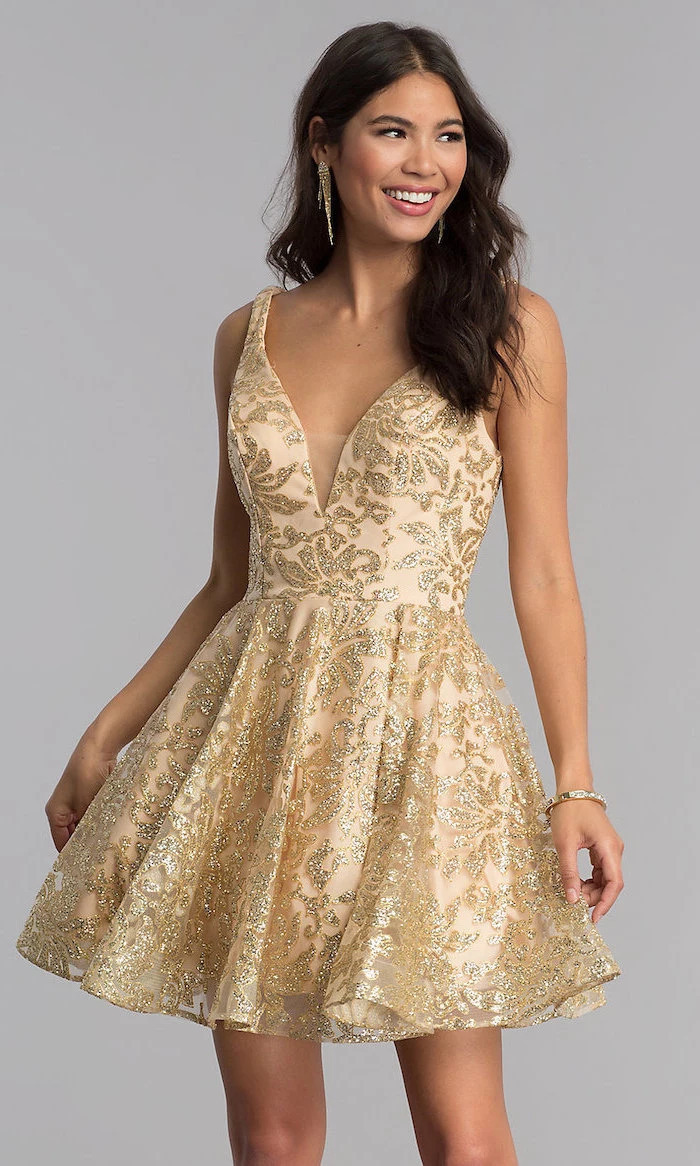
Here’s how to nail it: You need to be VERY specific. It’s not a free-for-all. Create a strict mood board and a set of rules. For example: “I’d love for you to choose a floor-length dress in one of these three options: a rose gold sequin dress from Lulus, a burgundy velvet dress from Revelry, or an antique gold satin dress from Birdy Grey.” By giving them specific fabrics, colors, and even retailers, you ensure the final look is a cool, curated collection, not a random mess.
The Practical Stuff: Budget, Comfort, and Alterations
A beautiful dress is only half the battle. Your bridesmaids need to be able to afford it, wear it for 10+ hours, and get it altered properly.
Let’s Talk Money (Without the Awkwardness)
Remember, your bridesmaids are paying for their own dresses. It’s so important to be respectful of everyone’s budget. Before you even start looking, have a private, honest chat with each person.
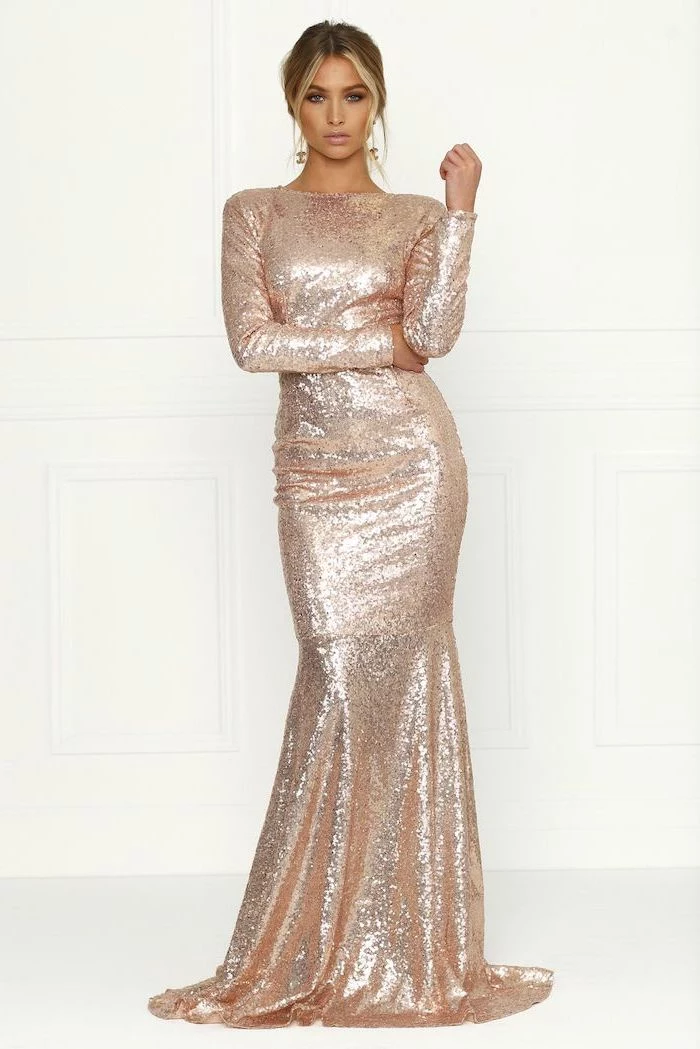
A simple way to bring it up is to text them: “Hey! I’m so excited to start looking at bridesmaid dresses, but I want to be super mindful of everyone’s budget. Would you be comfortable sharing a price range you’re okay with, totally no-pressure?”
Good to know:
- A quality bridesmaid dress from a specialty store usually runs between $200 and $400.
- You can find dresses online for under $150, but be cautious. It’s a great idea to order just one dress first to check the quality before everyone else buys.
- Hidden Costs are real! The final price includes alterations, which can range from $50 for a simple hem to over $150 for more complex work. Always aim for a dress in the middle of your budget to leave a cushion for tailoring.
Comfort Is a Must, Not a Luxury
Your bridesmaids are your support system on a very long day. Don’t make them miserable! A heavy, fully-sequined dress might be a nightmare for an outdoor wedding in July. Think about breathable fabrics like chiffon for warm weather and cozier options like velvet for the cold. Also, consider structure. If some of your bridesmaids are busty, a flimsy strapless dress will be a source of constant stress for them. Look for styles with wider straps, built-in support, or necklines that offer more coverage.
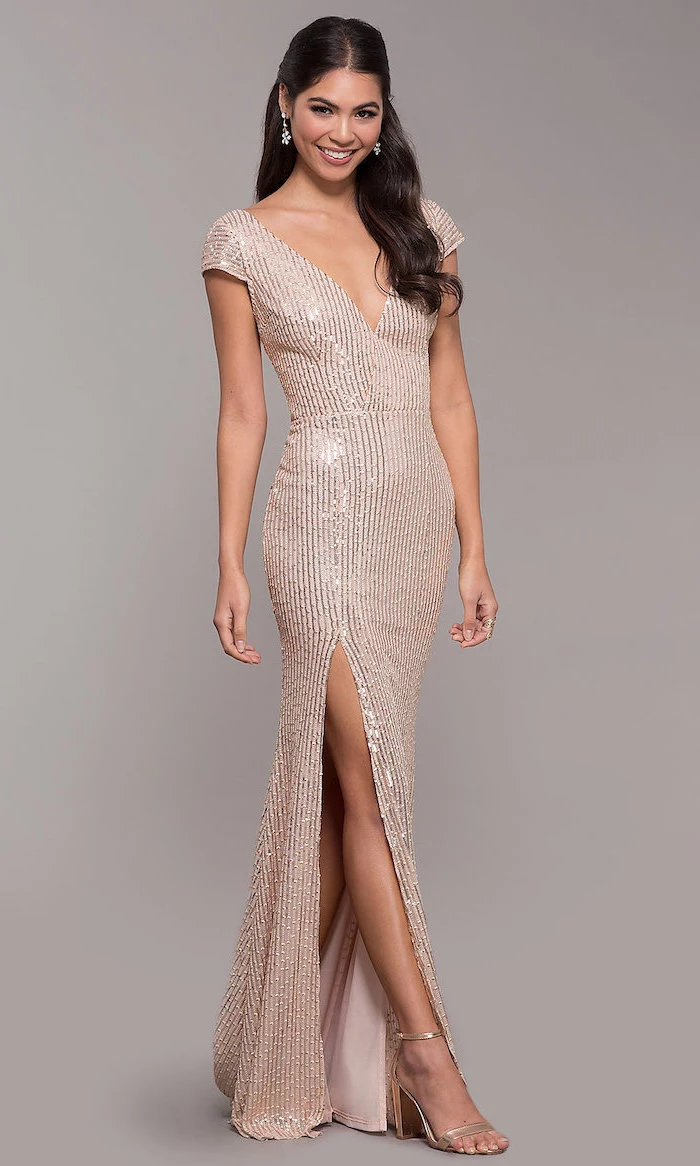
The Alteration Timeline (Don’t Skip This!)
This is the part everyone forgets. A seamstress’s schedule can be booked solid for months, especially during peak wedding season.
A timeline I swear by:
- Order the Dresses (6-9 Months Out): Seriously. Many dresses take 12-16 weeks to be made and shipped.
- Dresses Arrive (3-4 Months Out): Time to ship them out to your bridesmaids.
- First Fitting (2-3 Months Out): Each person needs to find a local seamstress. A great way to find one? Ask the bridal shop where you got your gown for recommendations, or check local wedding Facebook groups for real reviews.
- Final Fitting (3-4 Weeks Out): This is for final tweaks. Do NOT let them wait until the week before the wedding. I’ve had to perform last-minute miracles, and it’s stressful for everyone involved.
A Few More Pro Tips Before You Buy
After all my years in this business, I’ve seen a few common problems pop up again and again with gold dresses. Here’s how to get ahead of them.
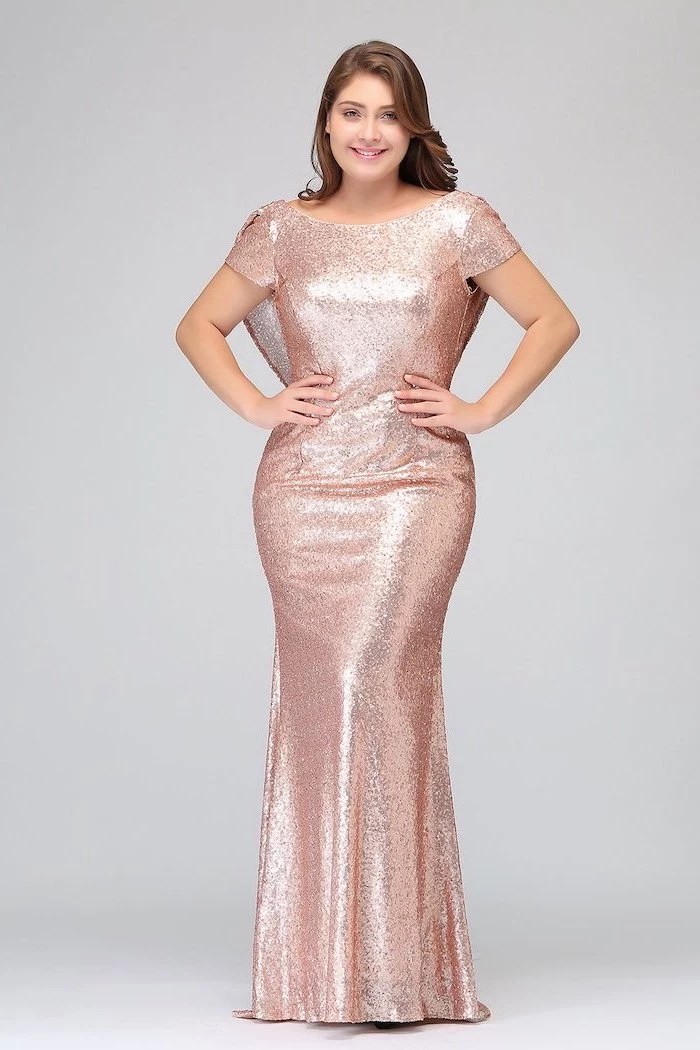
Problem: The Bridesmaids Outshine the Bride.
It happens! If your wedding dress is simple and unadorned, a party in bright yellow gold sequins can be a lot. The fix? Opt for a more subdued gold like antique, champagne, or rose gold in a matte fabric. It’ll complement you beautifully without stealing the show.
Problem: The Dresses Look “Cheap.”
The #1 culprit is thin, shiny polyester fabric that has a weird greenish tint. The solution is simple: order fabric swatches. There is no substitute for seeing and feeling the material in person. Hold it in the sun. Crumple it in your hand. Does it feel substantial? You’ll know quality when you feel it.
Problem: Photography Glare.
I always tell my clients to chat with their photographer about their dress choices. I asked a photographer friend about this, and she said, “Matte fabrics are a dream to shoot, but if you love sequins, let’s plan to take some photos during the ‘golden hour’ before sunset. The soft light creates a gorgeous shimmer instead of a harsh, detail-killing glare.”
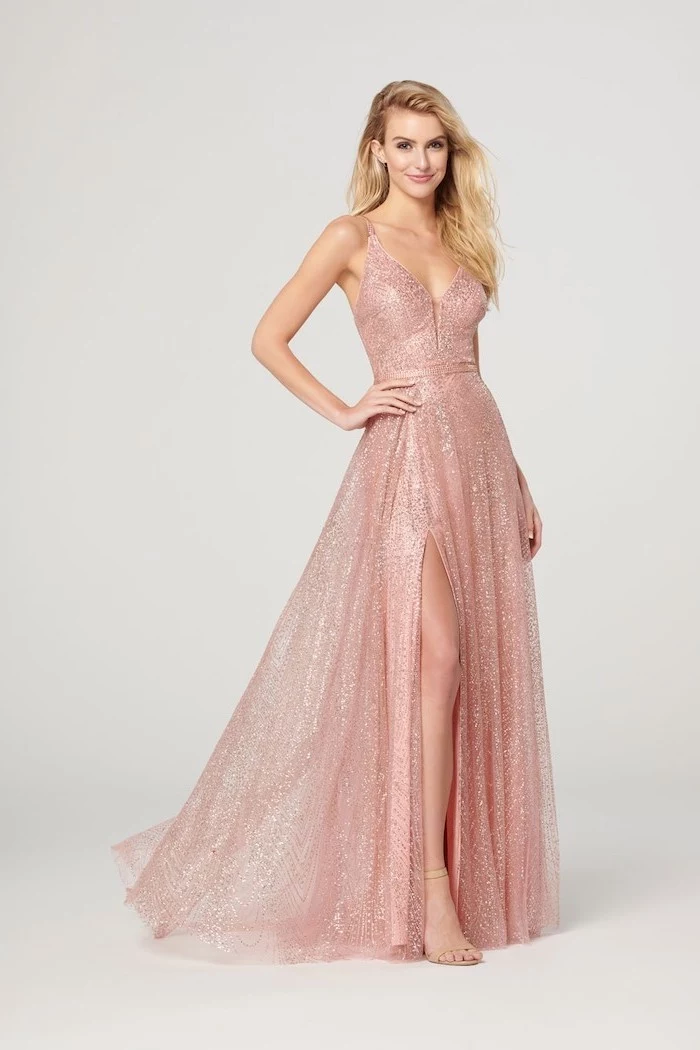
Your Final Gold Dress Checklist
Before you hit “confirm order,” run through this one last time. It’s saved so many people from major headaches.
- Order Together for Dye Lots! I once had two bridesmaids order the same “champagne” dress two months apart. One came back peachy and one was almost silver. It was a disaster. If you’re ordering the same dress, you MUST place the order for everyone at the same time to ensure they’re all cut from the same bolt of fabric.
- Bring the Right Undergarments & Shoes to Fittings. The hem is set based on shoe height, and the bust fits differently depending on the bra. No exceptions!
- Check the Hem for Safety. The front of a floor-length gown should just skim the top of the foot, not puddle on the floor. It’s a major trip hazard. For dancing, ask the seamstress to add a simple wrist loop or bustle.
Choosing gold is a fantastic way to bring warmth and glamour to your day. By being thoughtful and strategic, you can create a look that’s not just stunning, but a true reflection of the amazing people standing by your side.
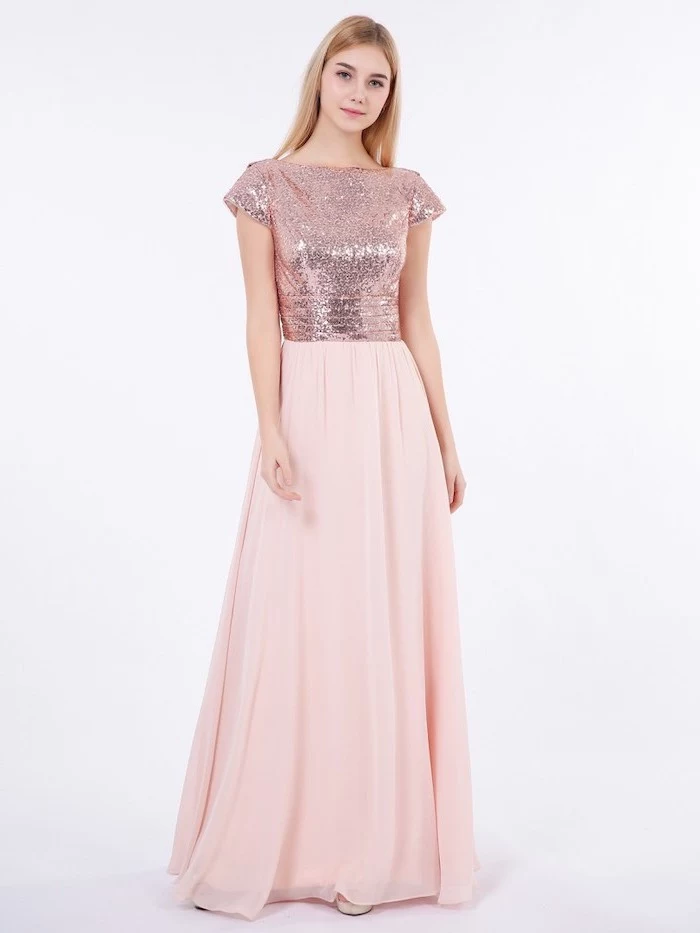
Inspiration Gallery
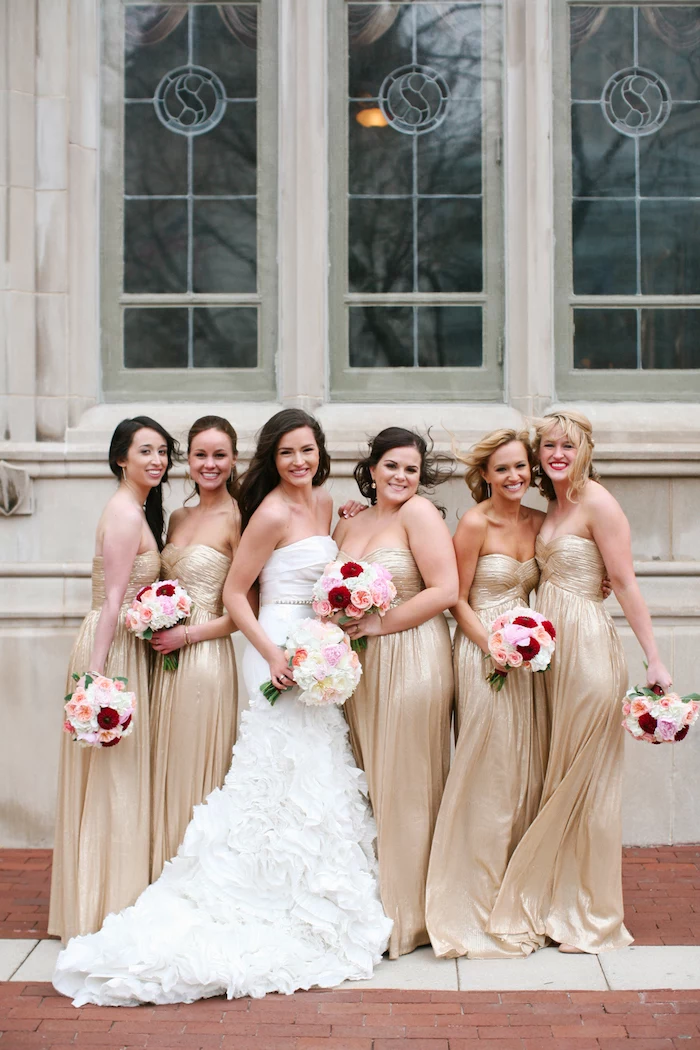
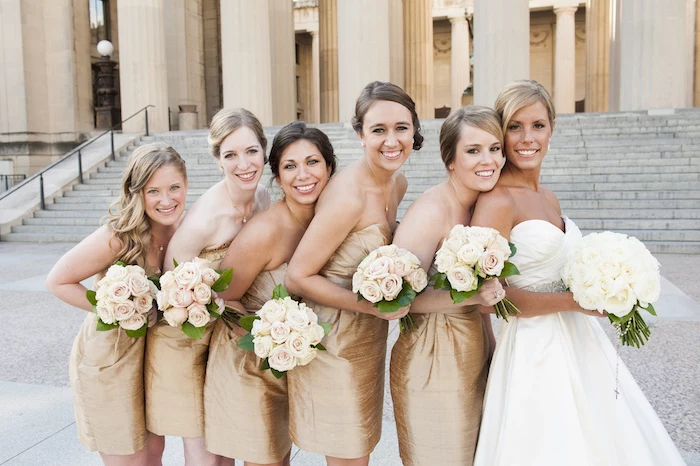
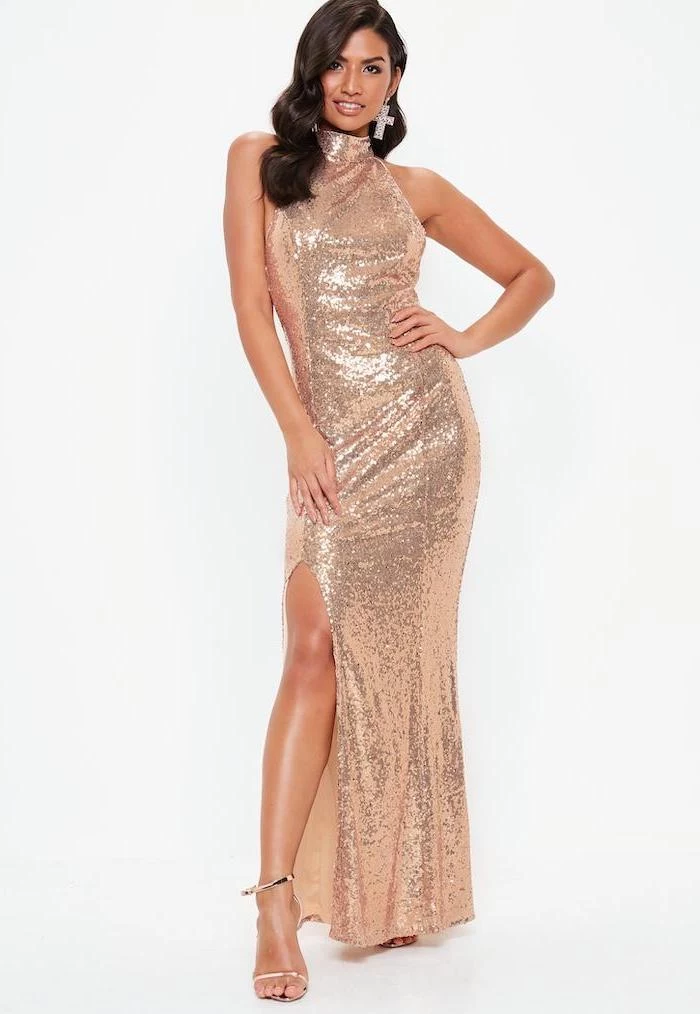
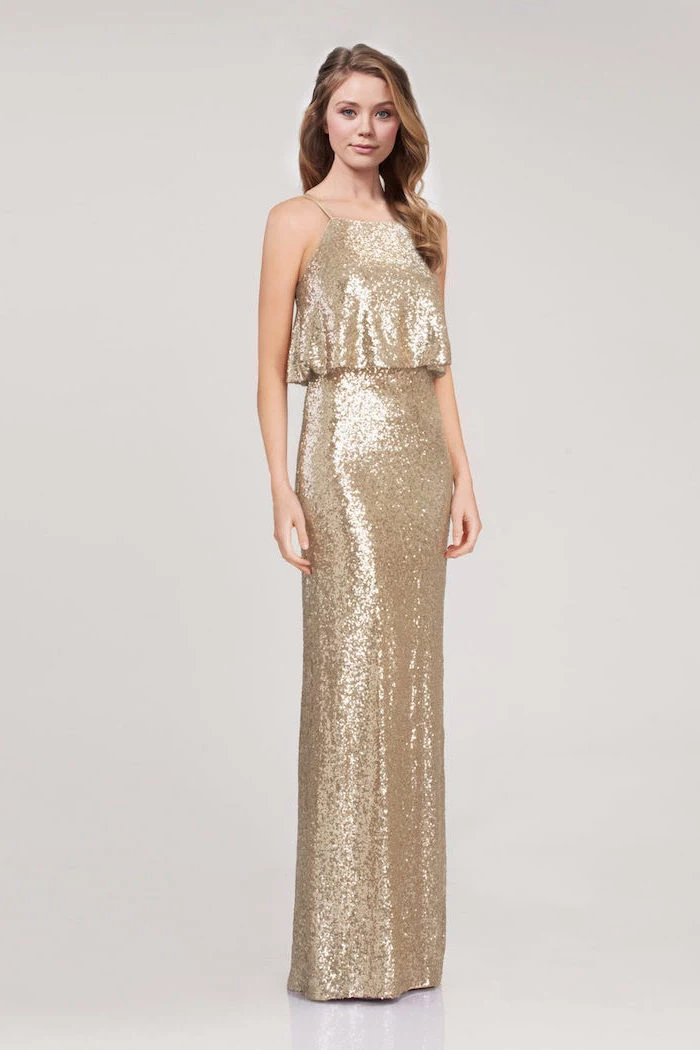
The Sequin Situation: Not all sequins are created equal, and comfort is key. Before committing, have your bridesmaids test the feel of the fabric, especially under the arms. Cheaper sequins can be incredibly scratchy. High-quality brands like BHLDN or Jenny Yoo often use a softer sequin or line the dress meticulously to prevent irritation during a long day of celebrating.
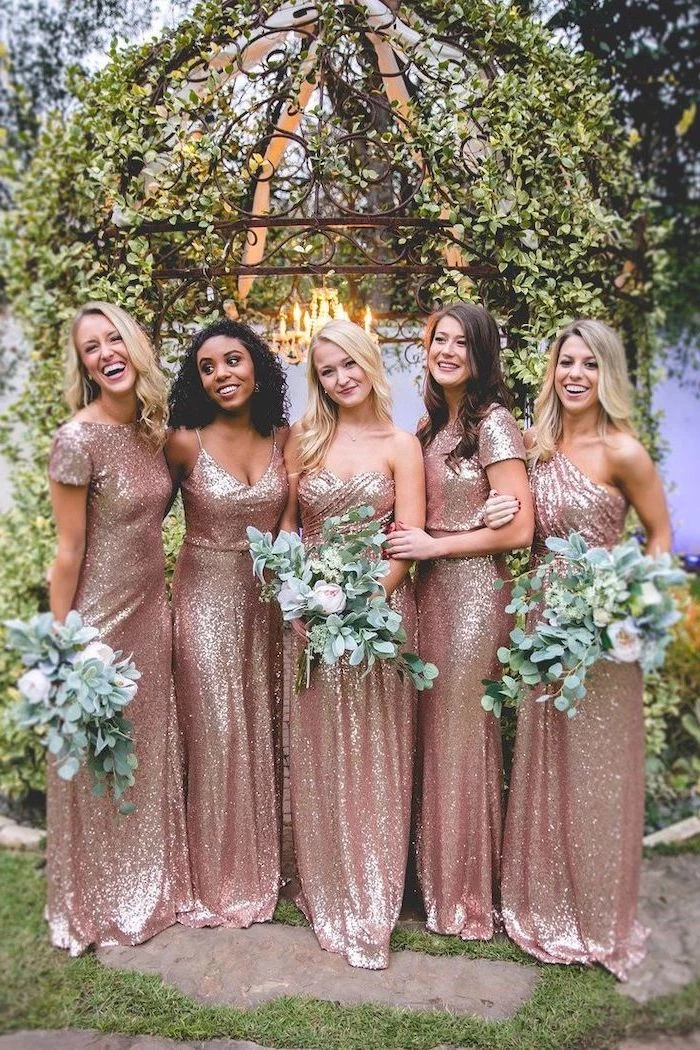
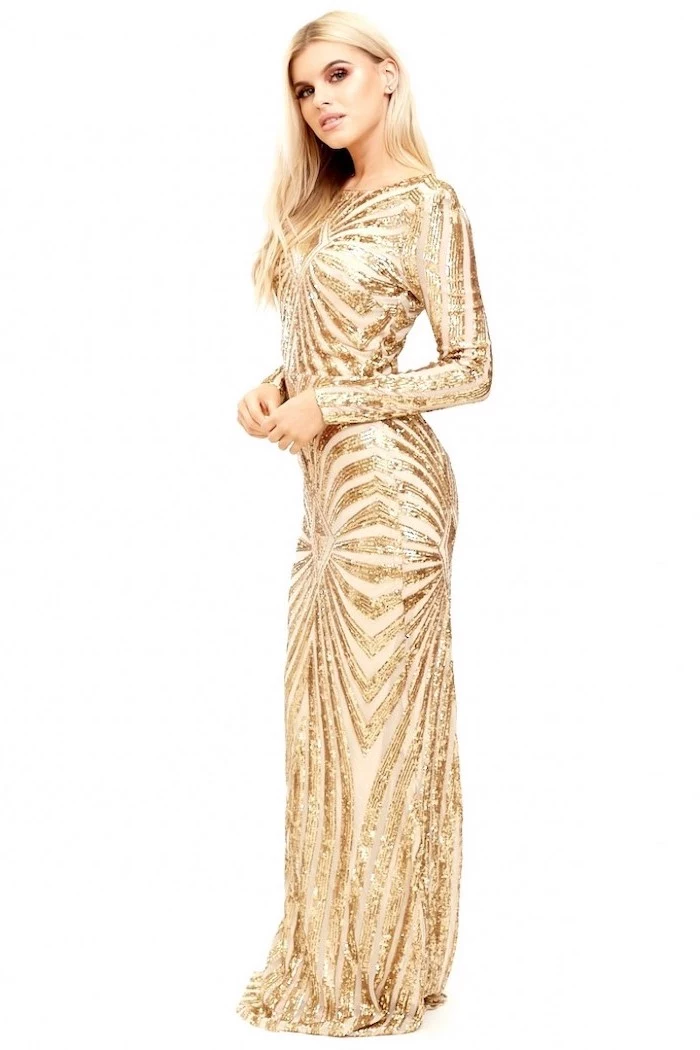
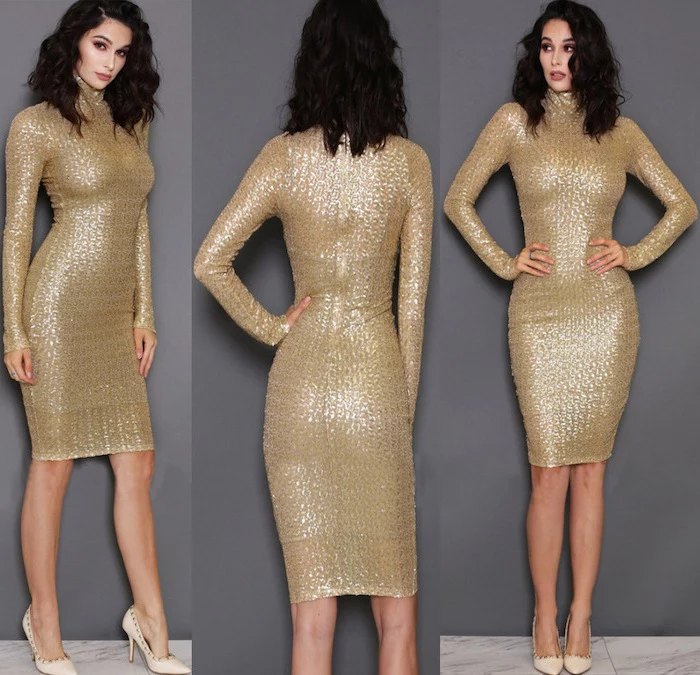
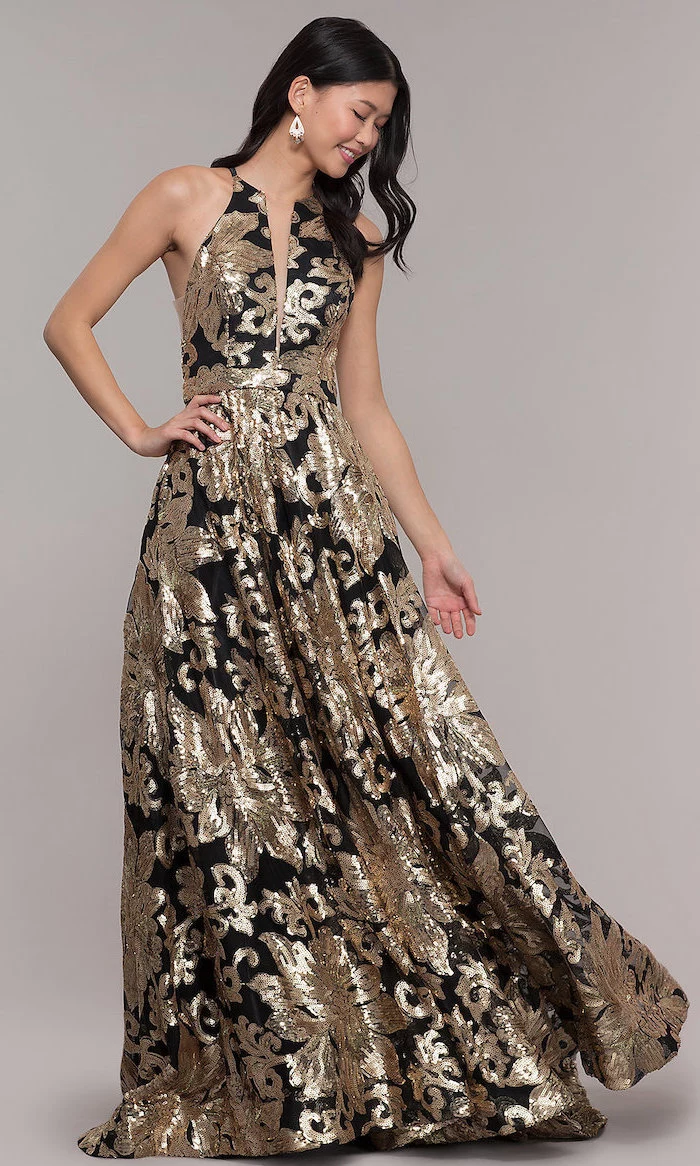
- Adds instant warmth and a festive glow to your photos.
- Creates a stunning visual contrast against a white or ivory wedding gown.
- Reflects light beautifully, especially during a sunset ceremony or candlelit reception.
The secret? Choosing a photographer experienced with metallics. They’ll know how to manage reflections and capture the richness of the fabric without unwanted glare.
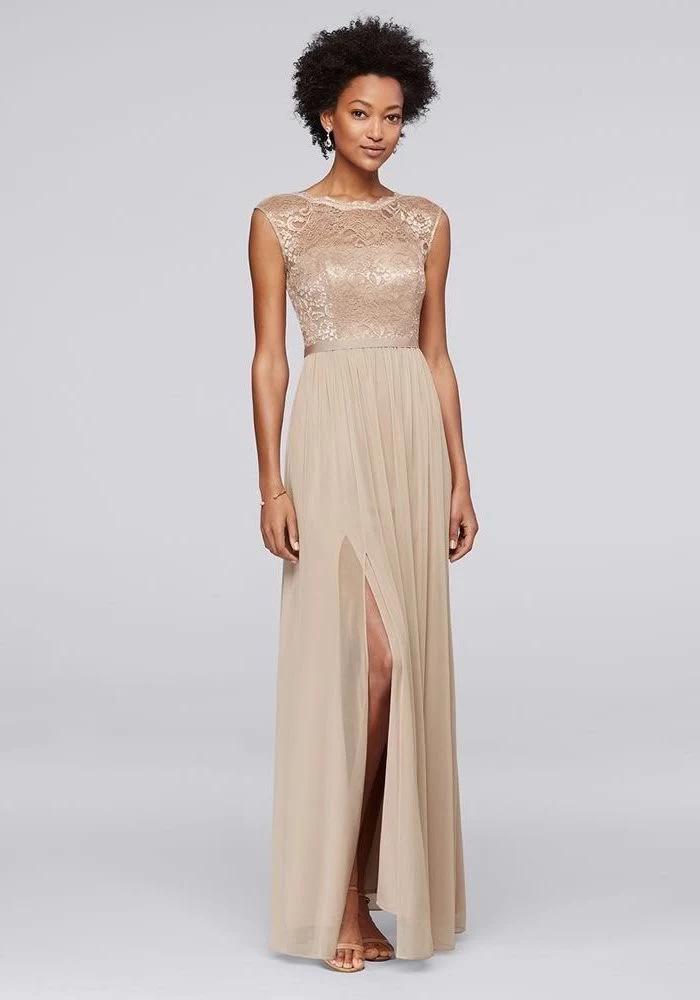
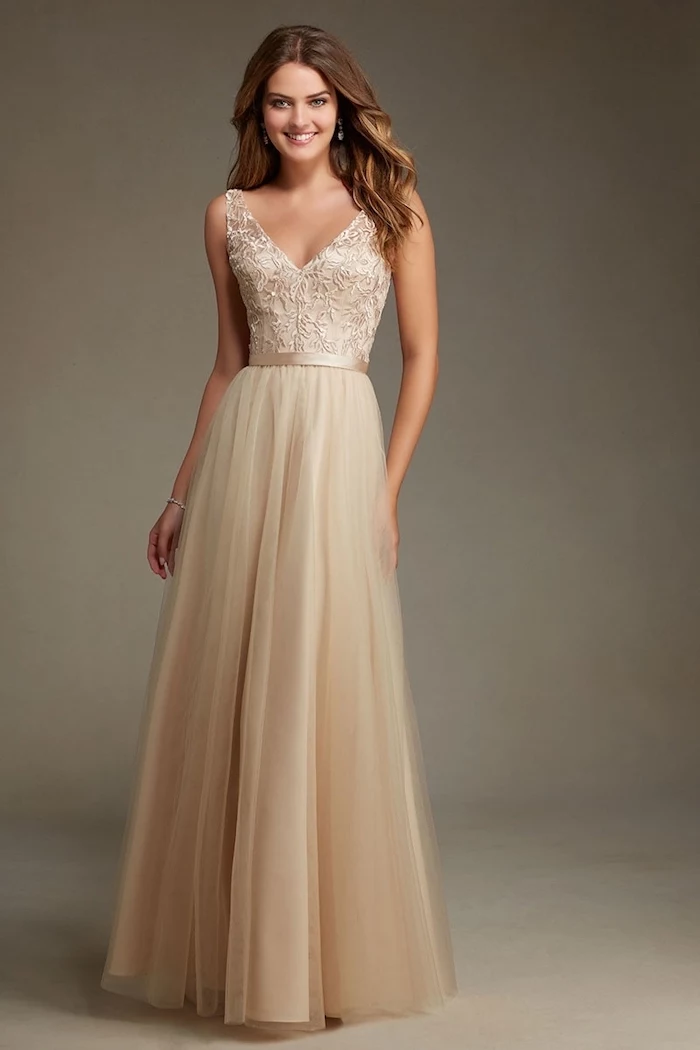
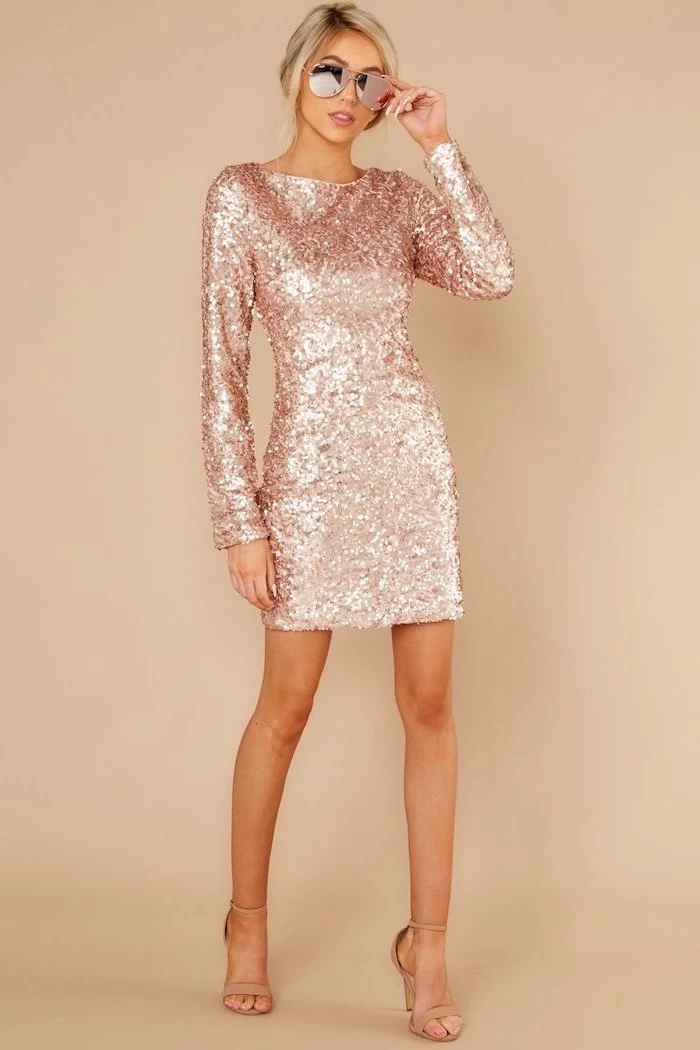
How do we handle alterations on a fully sequined dress?
It’s a valid concern! Altering sequins is a specialized skill. Find a seamstress who has explicitly worked with beaded or sequined eveningwear. They will need to remove the sequins along the seam line, stitch the seam, and then re-apply them by hand. This costs more and takes longer, so be sure to budget an extra 4-6 weeks and $100-$250 per dress for proper alterations.

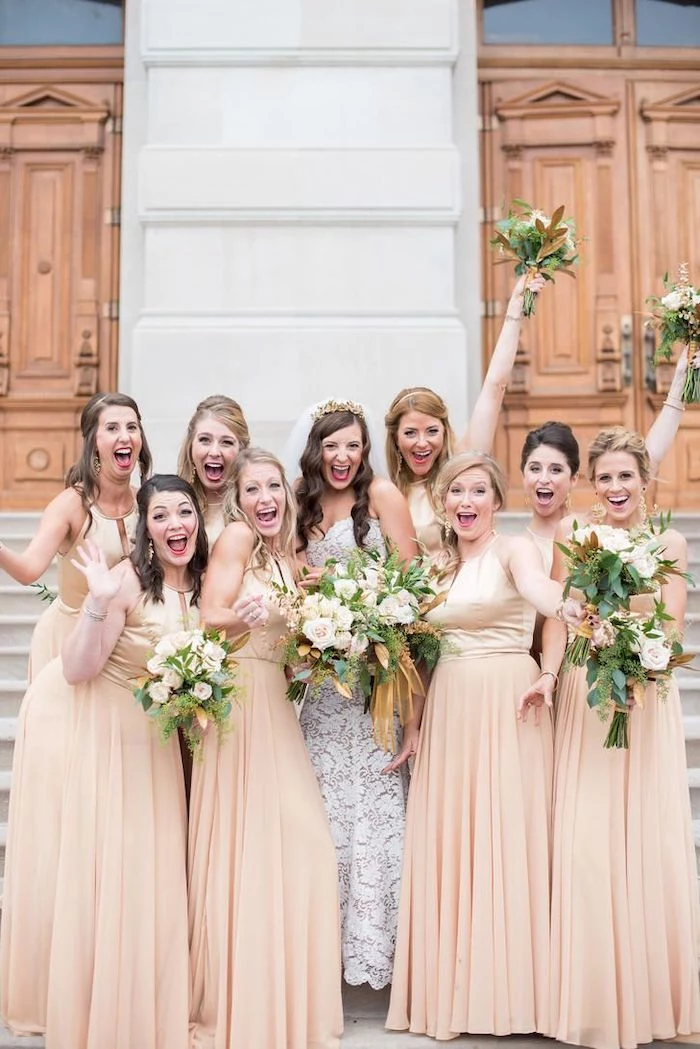
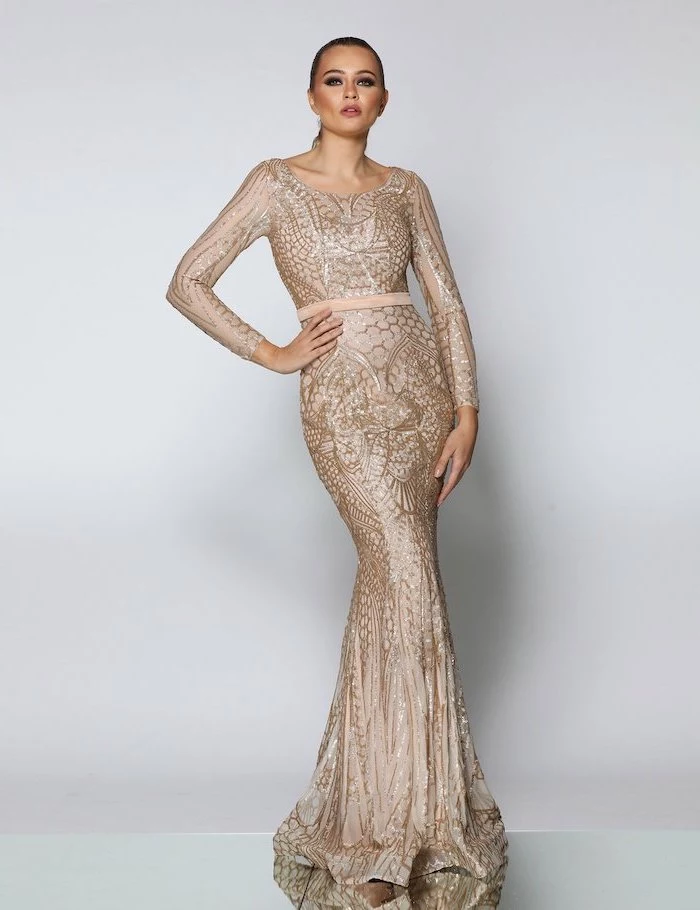
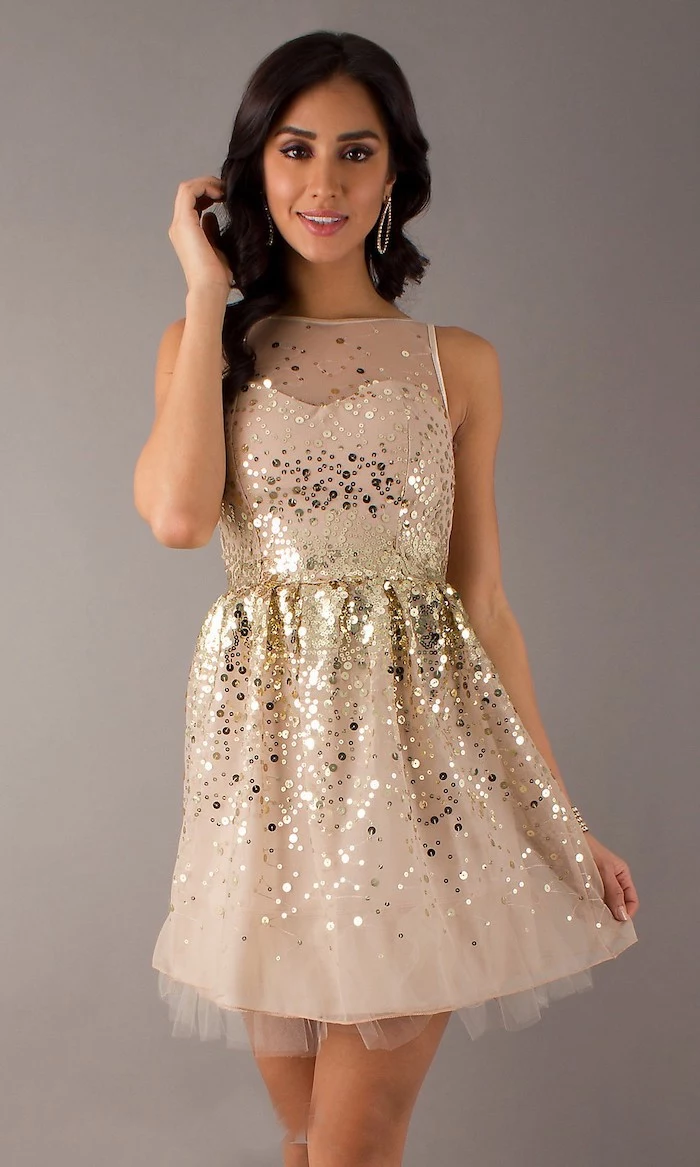
More than 70% of brides now opt for mismatched bridesmaid dresses, whether in style or color.
Gold is perfect for this trend. You can create a stunning, cohesive look by setting one rule: the color is gold, but the style, texture, or even the specific shade is up to each bridesmaid. A mix of satin, crepe, and sequin dresses in a similar gold tone looks incredibly chic and allows everyone to choose a silhouette that flatters them.
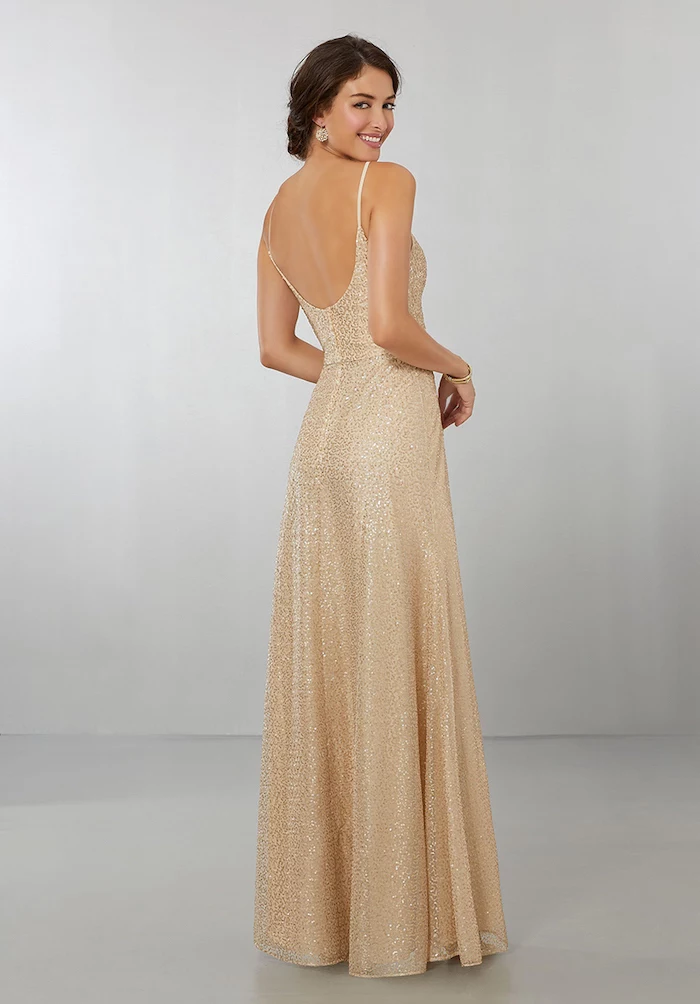
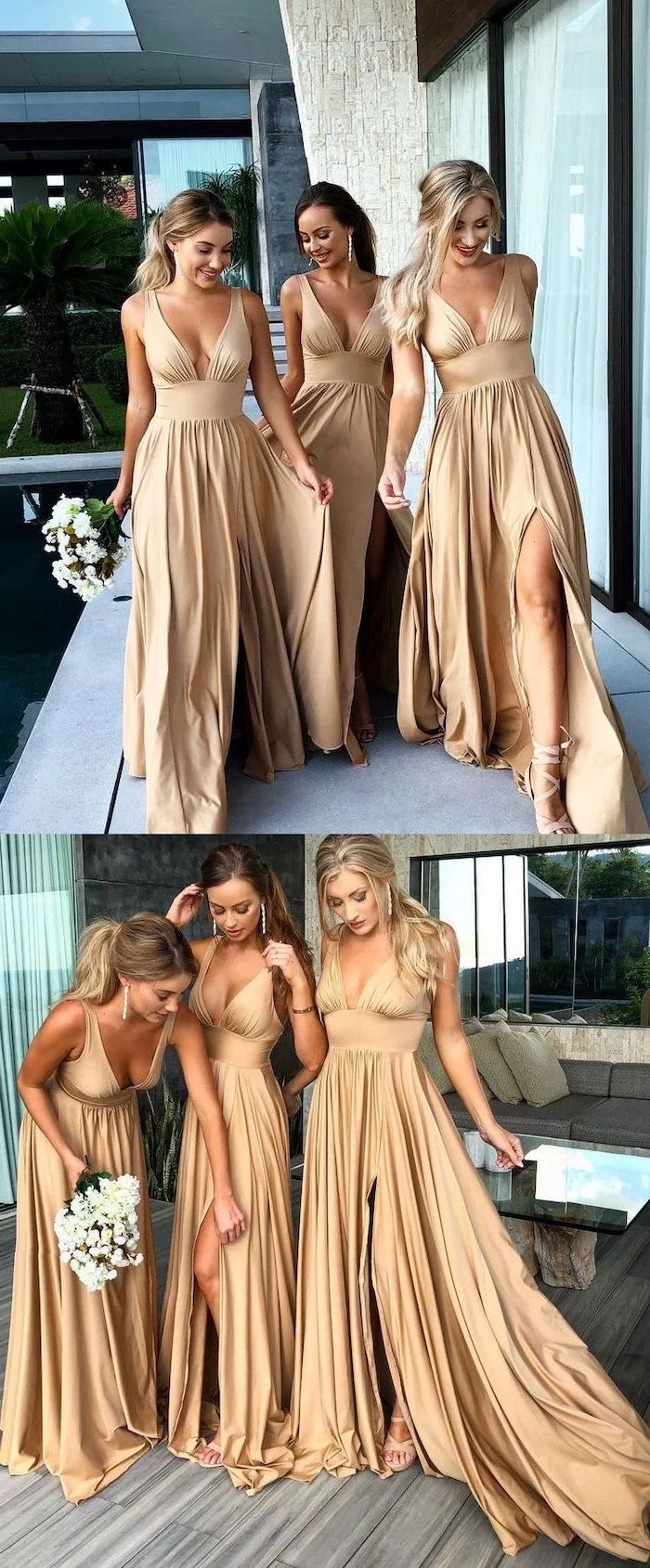

Don’t forget the shoes! The right footwear grounds the entire look. Nude or metallic strappy sandals are a can’t-miss option. For a modern twist, consider a clear perspex heel. Advise your bridesmaids to avoid silver or pewter shoes, as mixing cool and warm metallics can clash. A unified shoe choice, like a simple gold block heel from a brand like Loeffler Randall, can tie even mismatched dresses together perfectly.
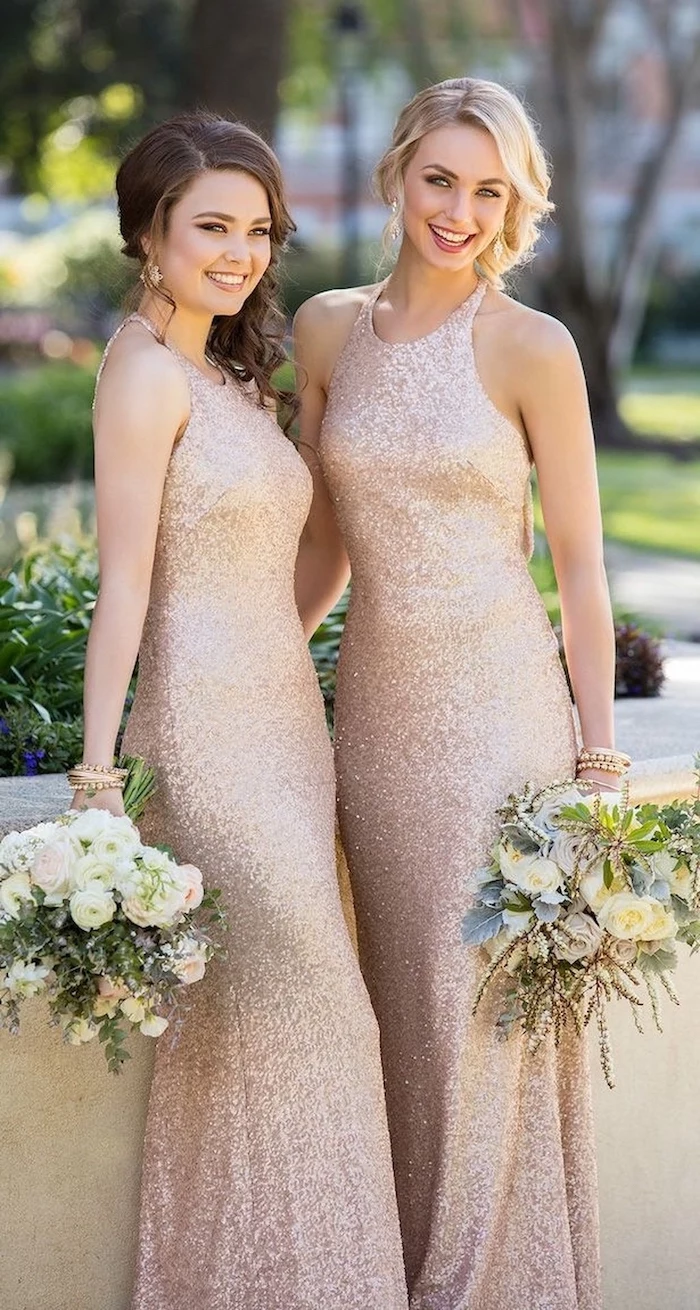
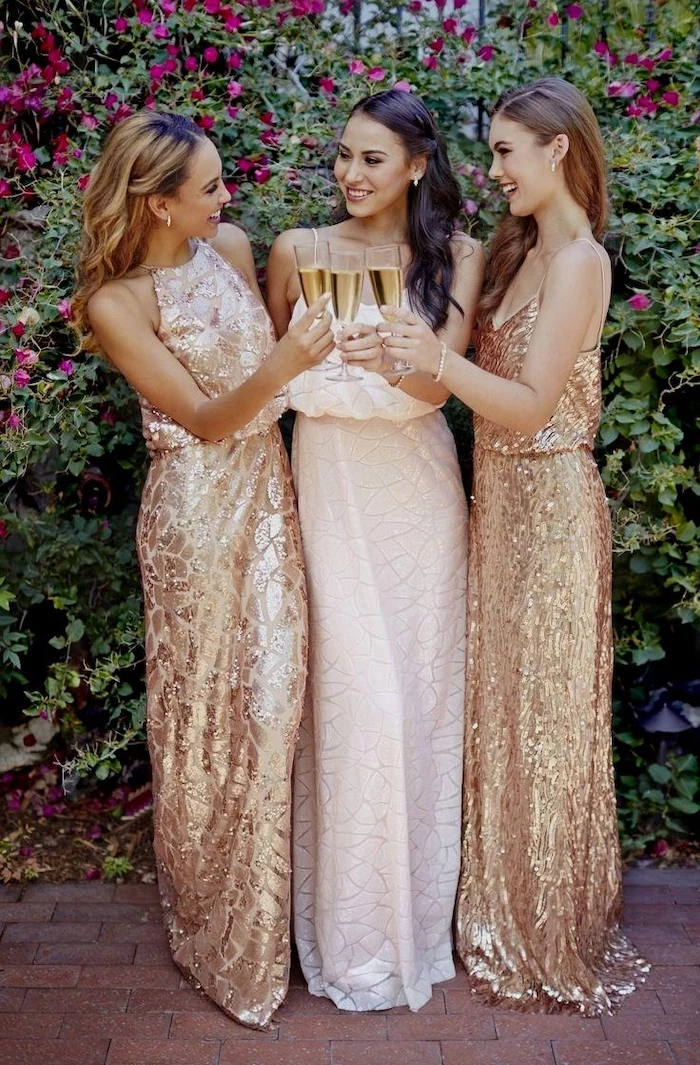
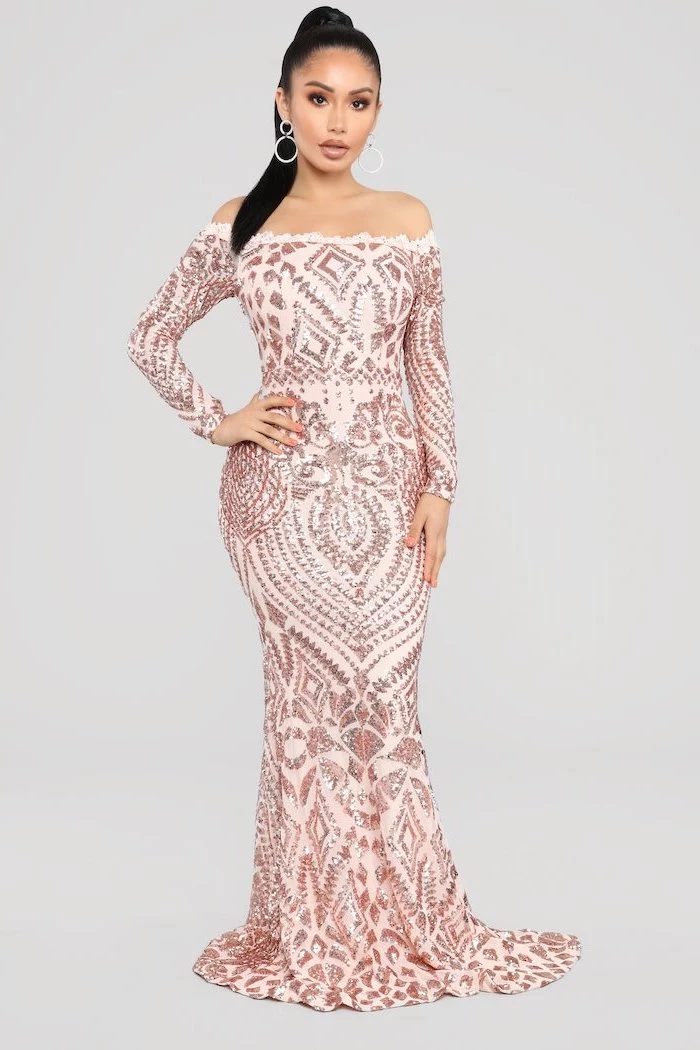
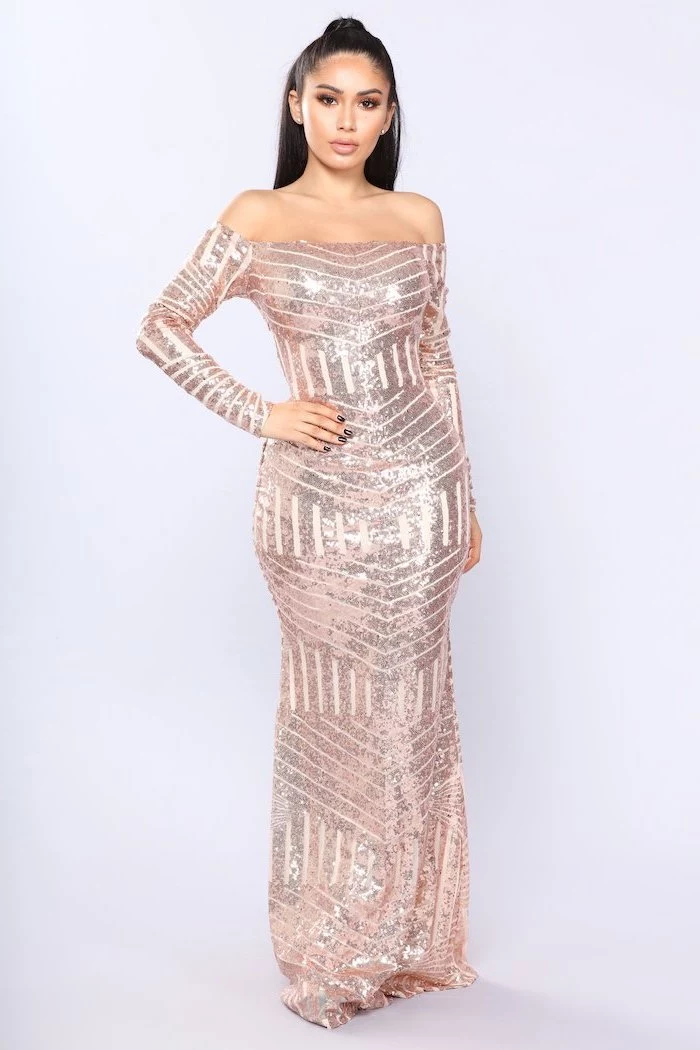
Matte Sequins: A sophisticated alternative to high-shine glitter. They offer a soft, elegant shimmer rather than a disco-ball reflection. Perfect for daytime or rustic-chic weddings where you want glamour without overwhelming the setting.
Classic High-Shine Sequins: Unapologetically glamorous. Ideal for formal, black-tie, or New Year’s Eve weddings. They make a bold statement and come alive under evening lights.
The choice depends entirely on your wedding’s overall vibe.
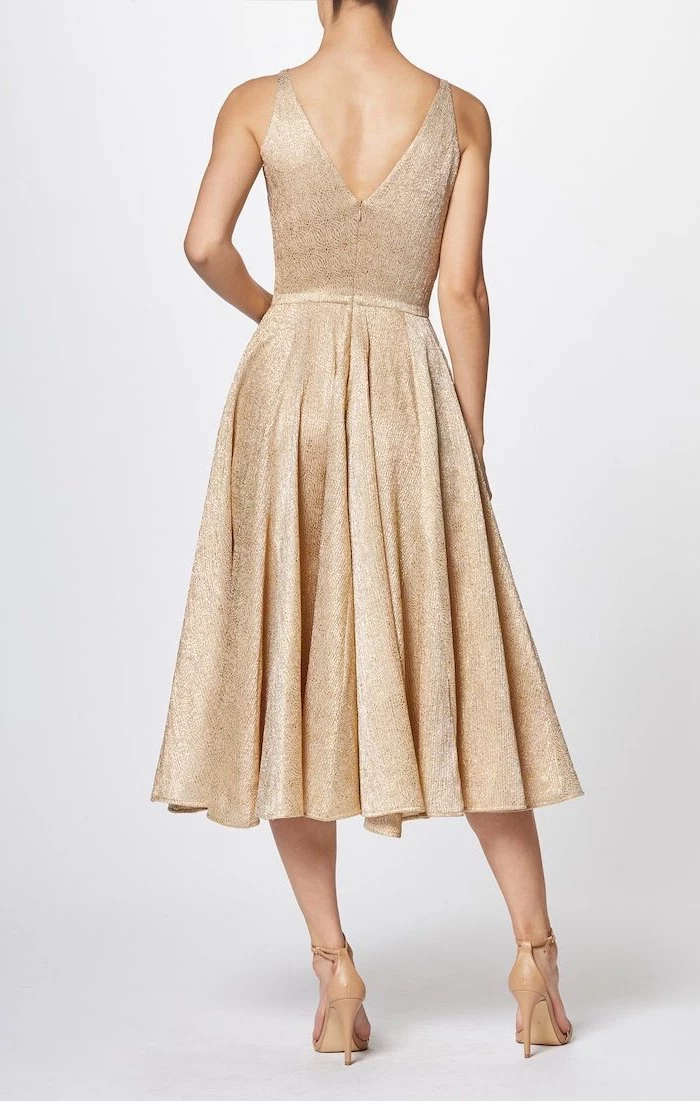
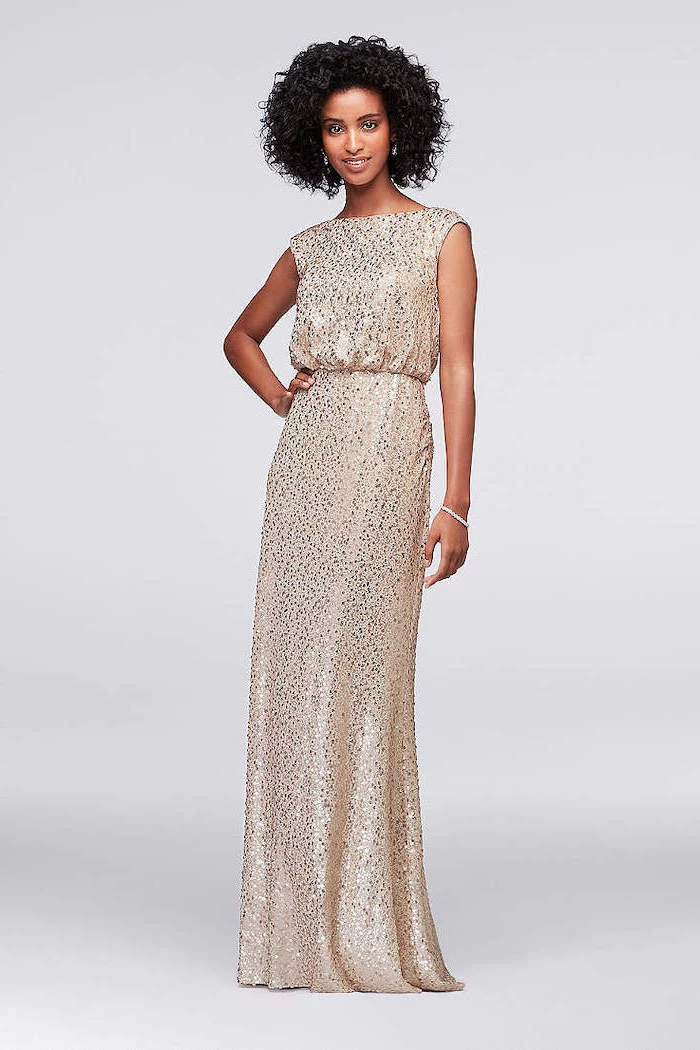
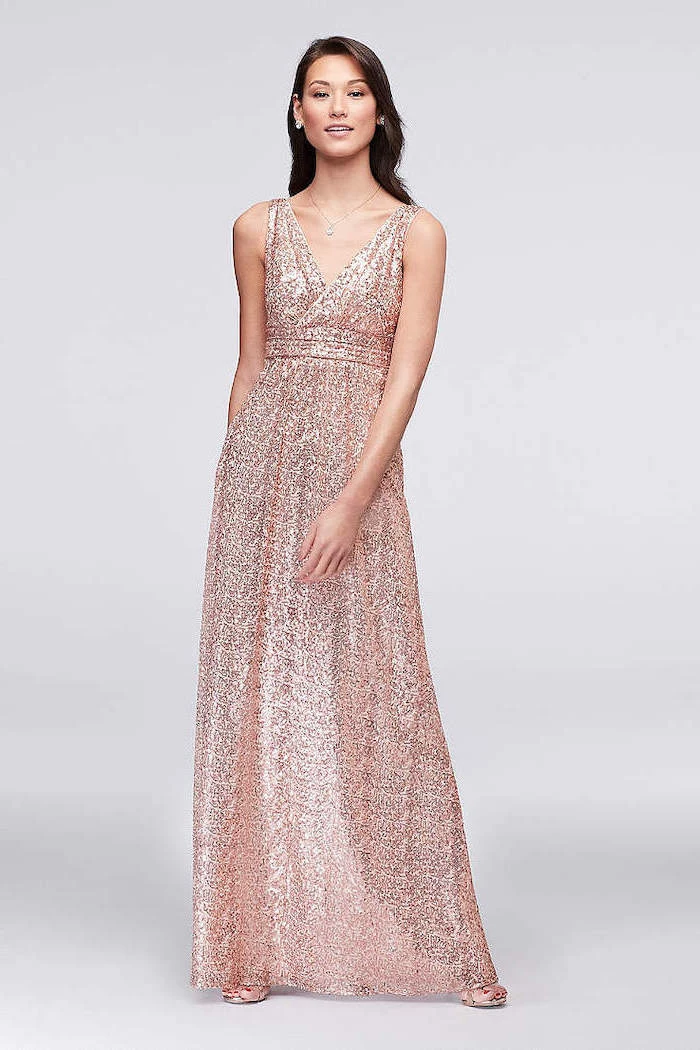
Let’s talk flowers. The bouquets are your primary color accent against the gold backdrop. For a rich, autumnal feel, pair gold dresses with deep burgundies, burnt oranges, and emerald greens. For a fresh, classic look, you can never go wrong with lush bouquets of all-white peonies and hydrangeas. The green stems provide a beautiful, natural contrast.
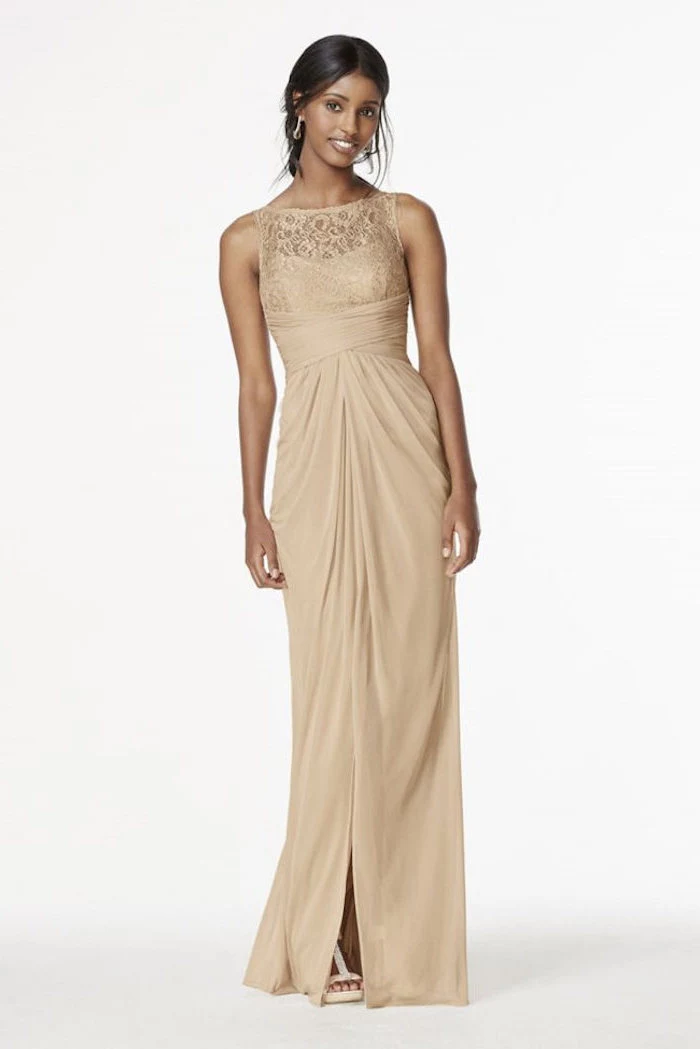
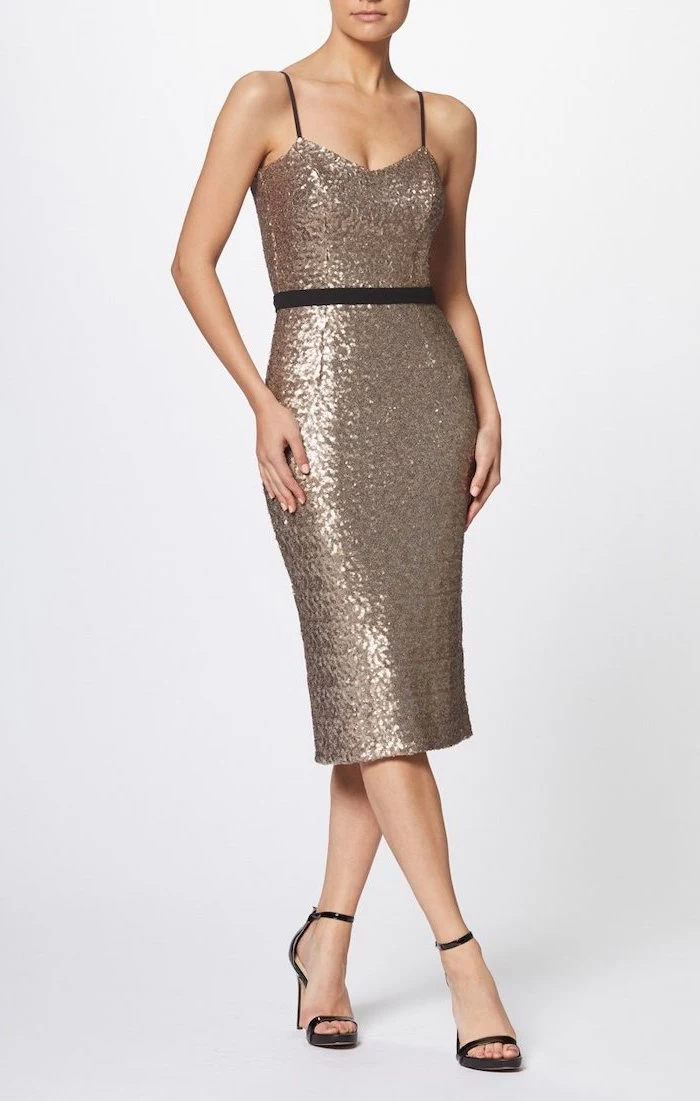
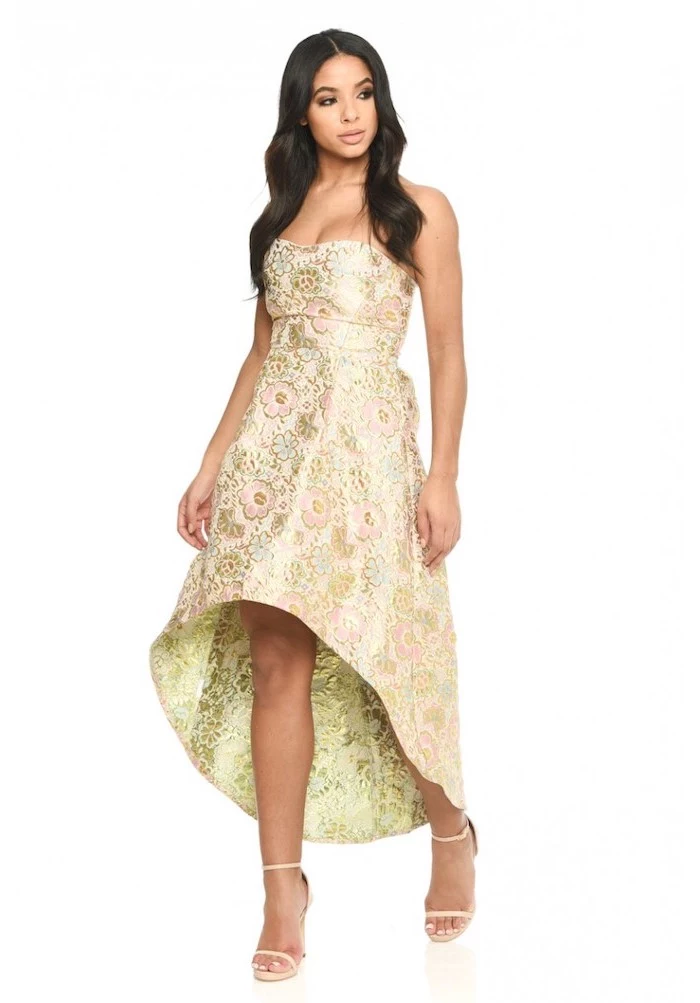
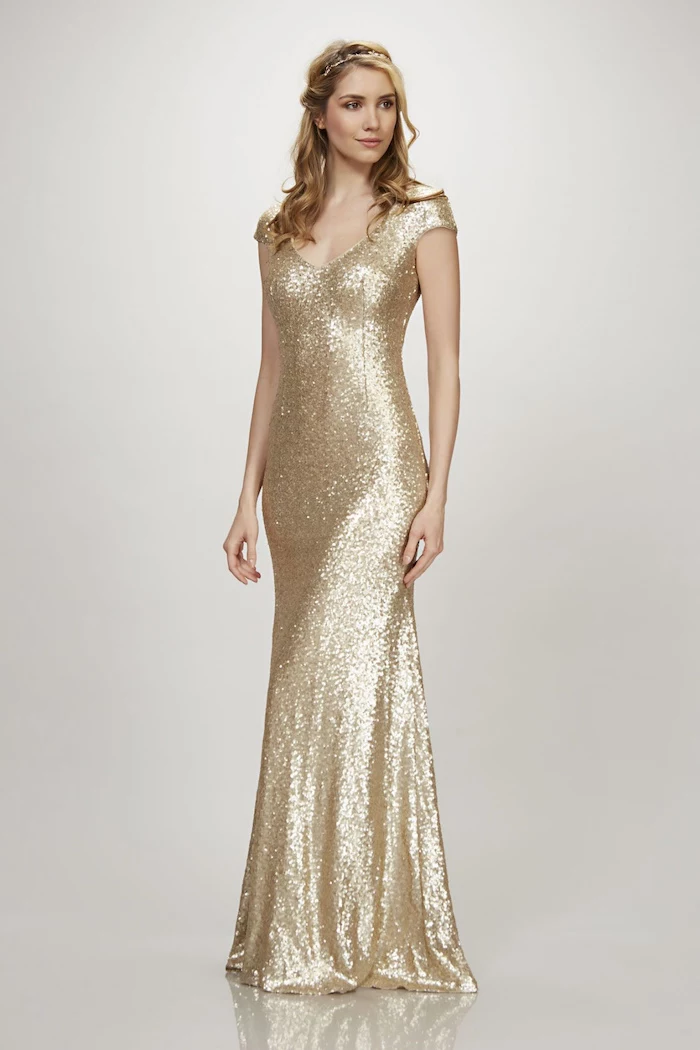
Gold leaf, known as ‘aurum foliatum’, has been used to adorn garments since the ancient Egyptians, symbolizing divinity and royalty.
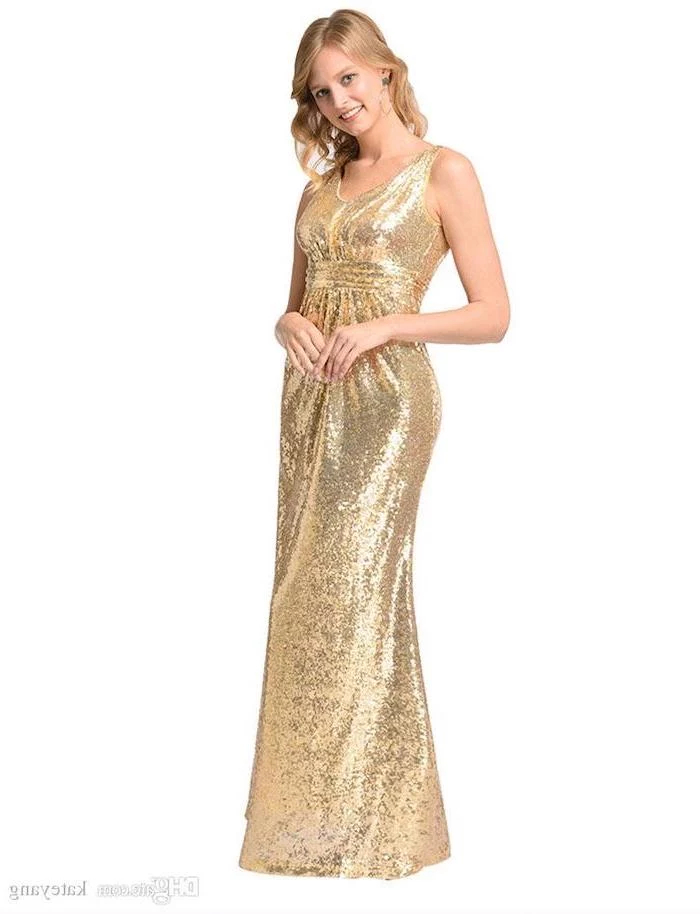
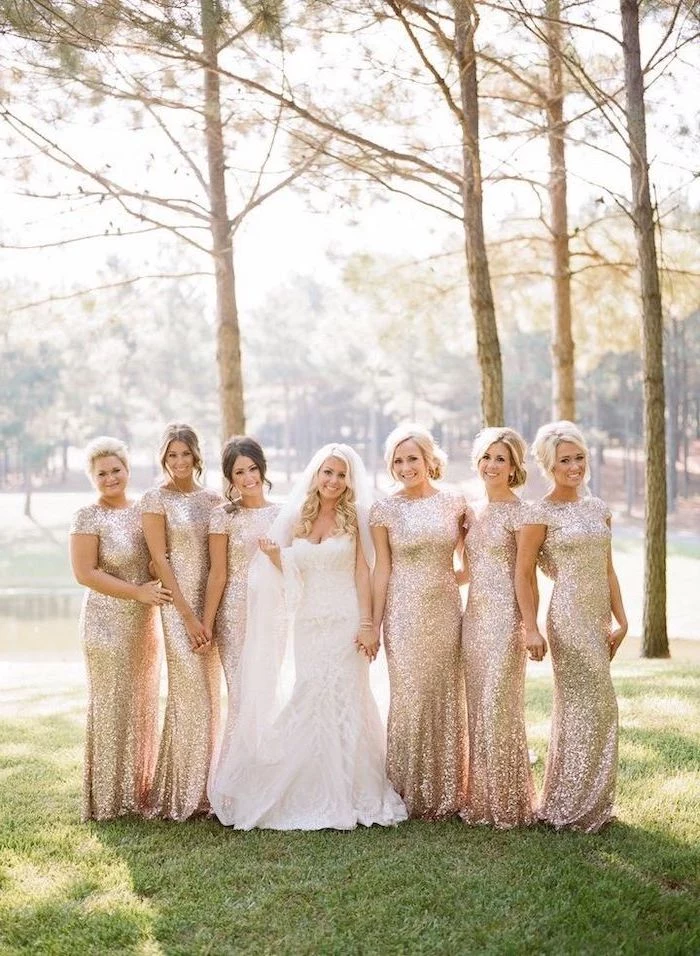
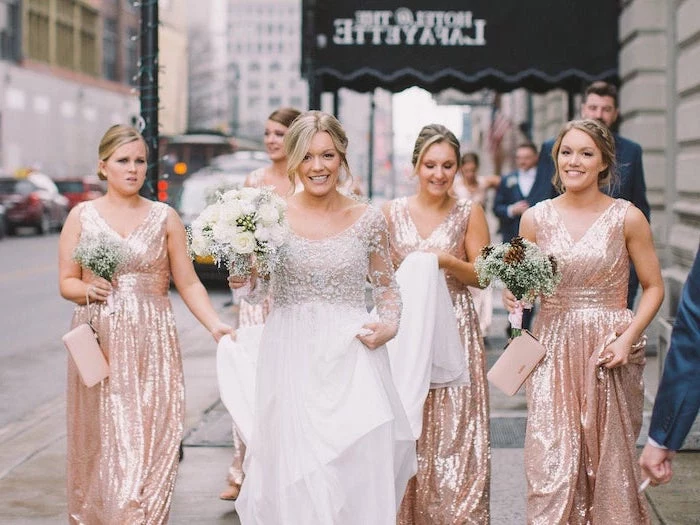
The right undergarments are non-negotiable, especially with slinky gold fabrics.
- For Satin or Crepe: Seamless, laser-cut underwear in a nude shade is essential to avoid VPL (visible panty lines). A brand like Commando is a go-to for this.
- For Sequins: While the texture is more forgiving of lines, comfort is paramount. A seamless short or thong will prevent any potential chafing from the dress’s inner seams.
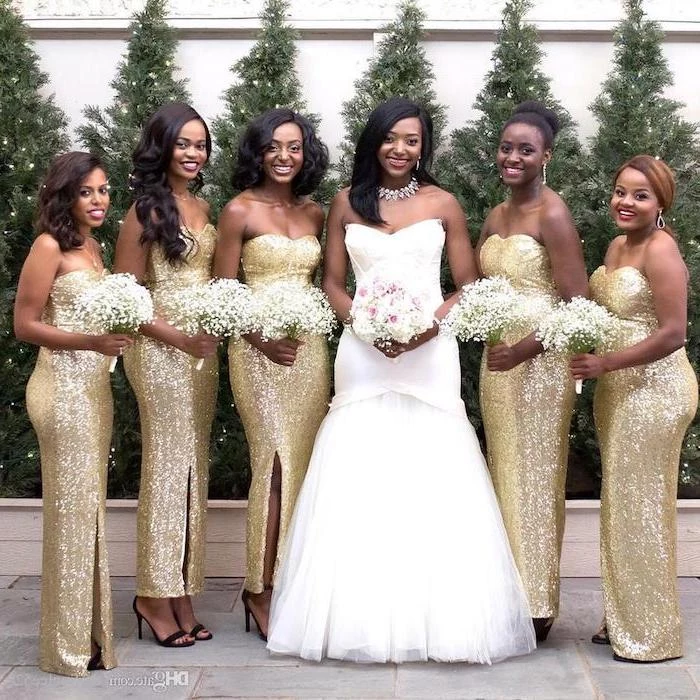
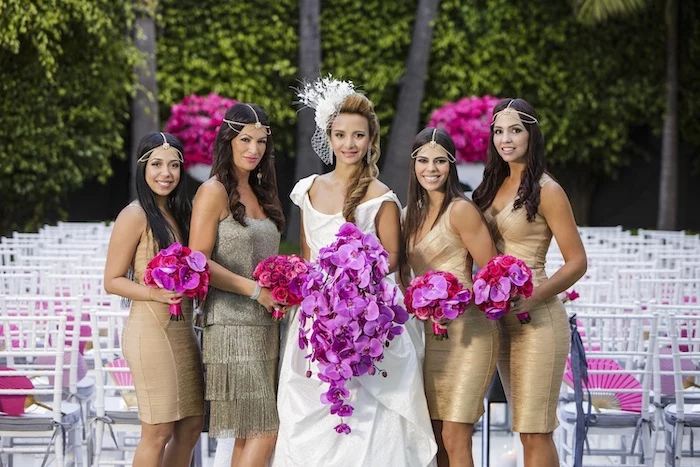
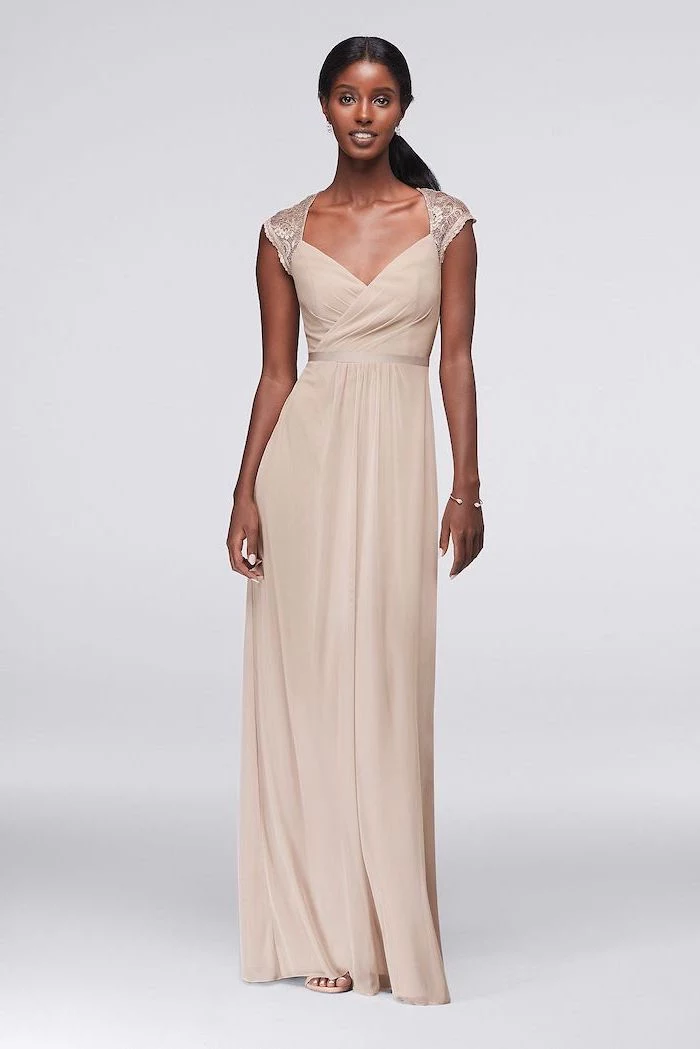
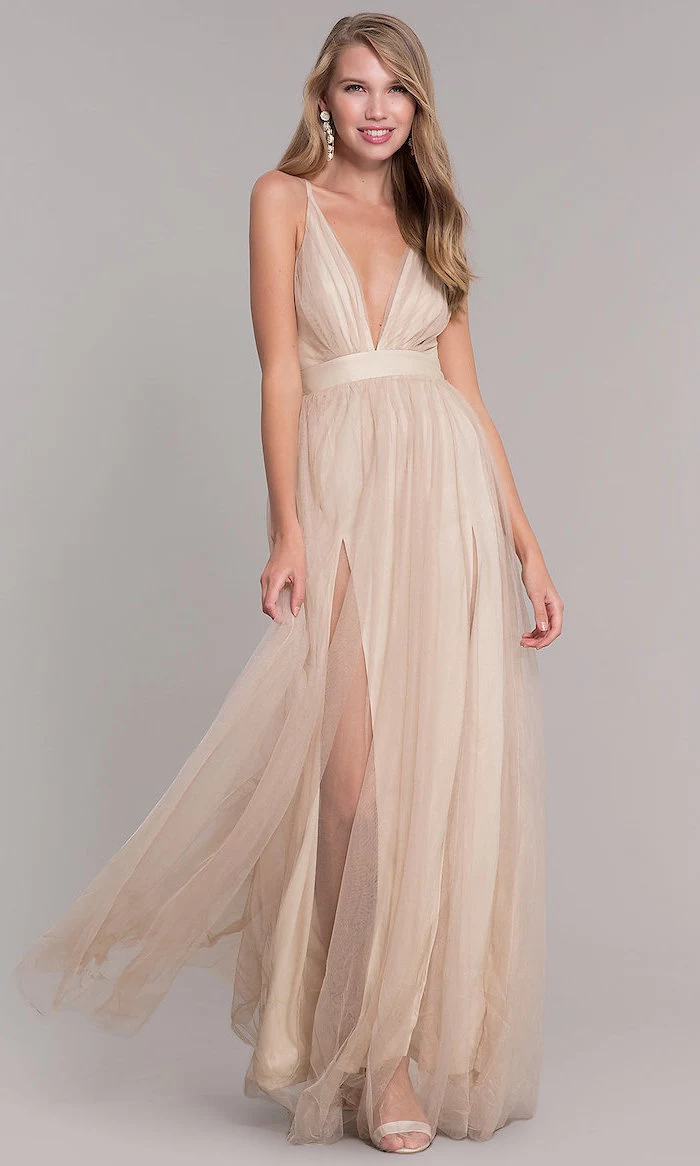
Thinking about hair and makeup?
Gold dresses have a ‘main character’ energy, so balance is key. A classic red lip looks stunning with yellow gold, while soft pinks and mauves complement rose gold beautifully. For hair, an elegant updo—be it a sleek chignon or a romantic messy bun—showcases the neckline of the dress and prevents hair from snagging on sequins or beading.
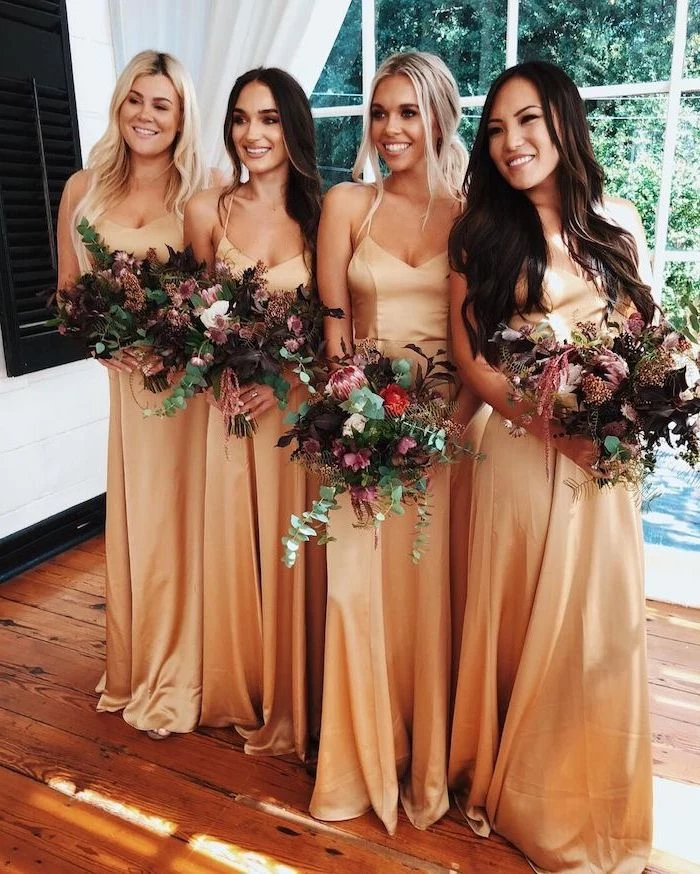
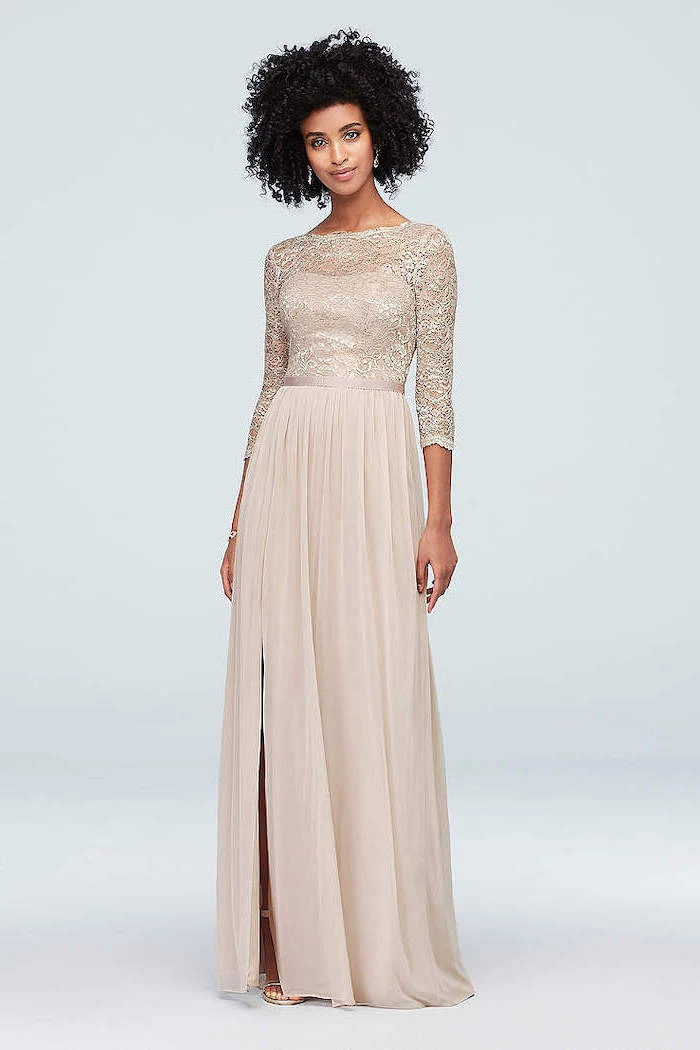
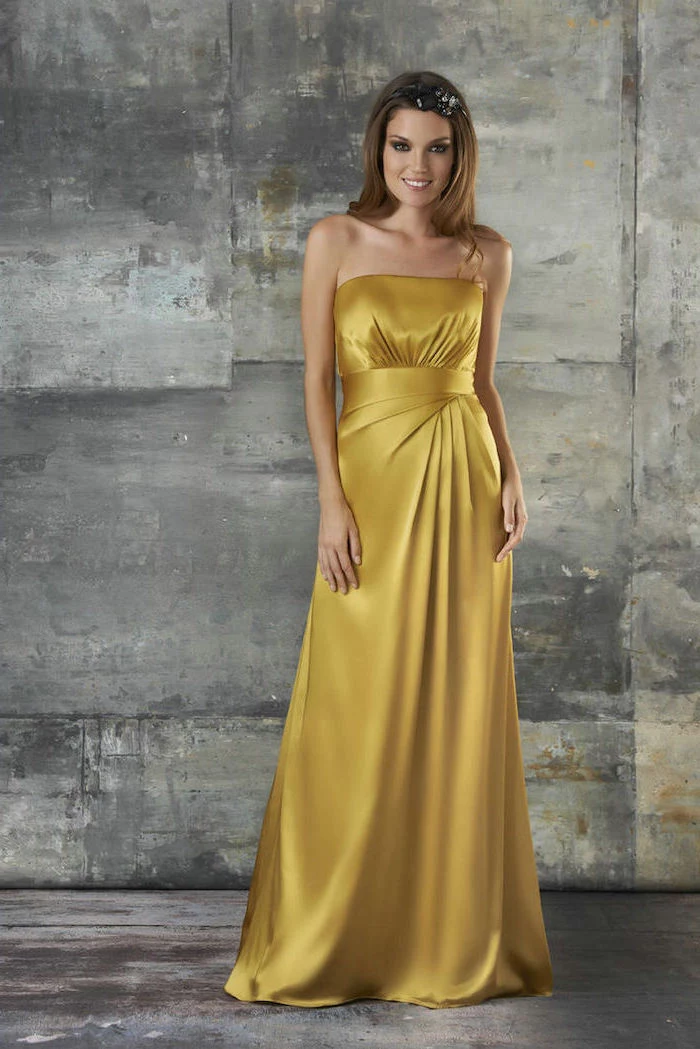
The Fabric Test: Satin vs. Lurex
Gold Satin: Offers a liquid, molten-metal effect. It drapes beautifully and feels luxurious against the skin. It’s incredibly elegant but can show every line and wrinkle, so proper steaming before the ceremony is a must.
Gold Lurex: This is a knit fabric with a metallic thread woven in. It provides a more subtle, all-over shimmer, is often stretchier and more comfortable, and is less prone to wrinkling. A great option for a more relaxed or boho wedding style.
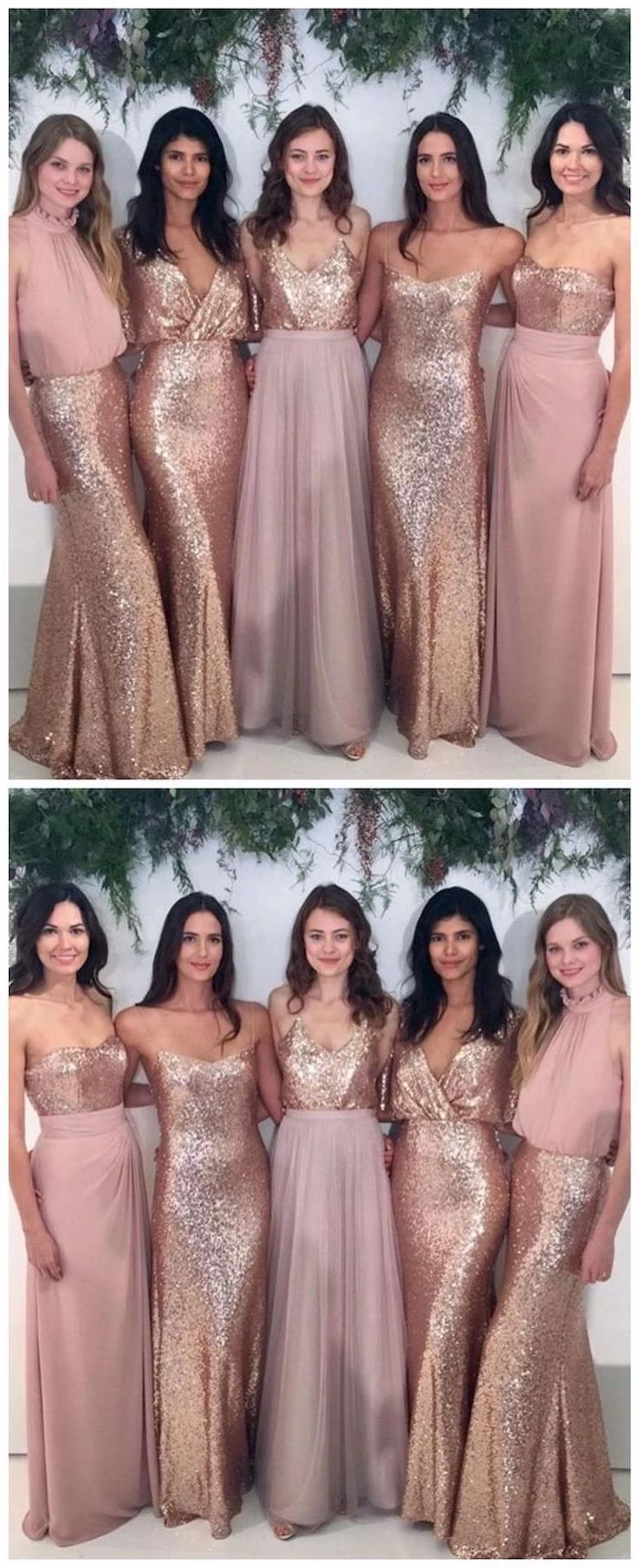
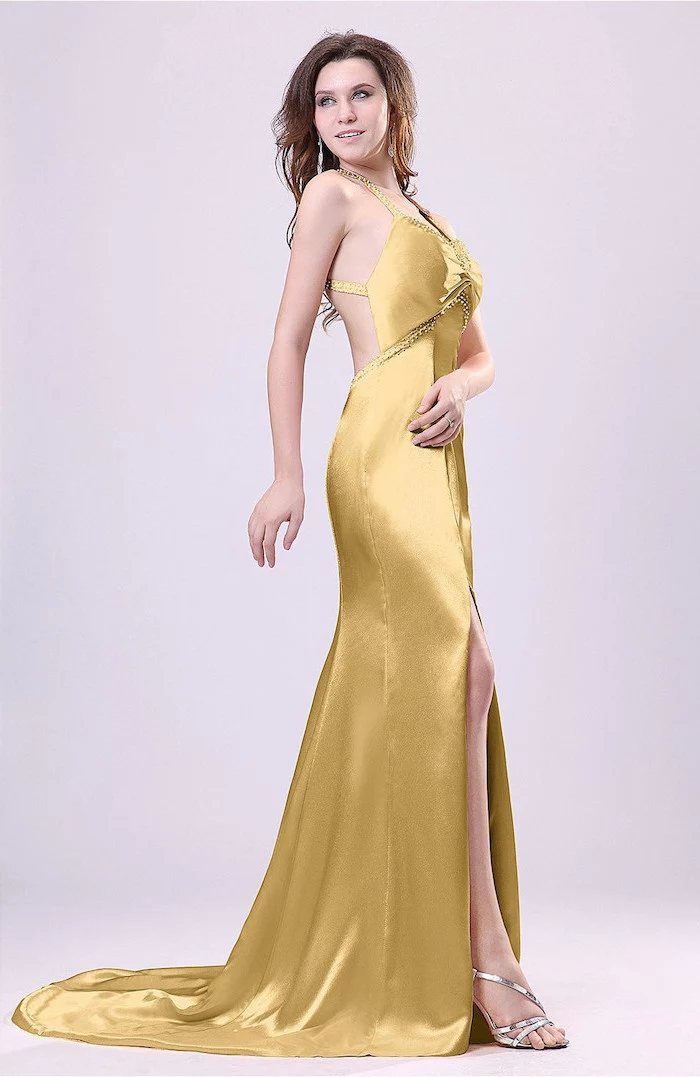
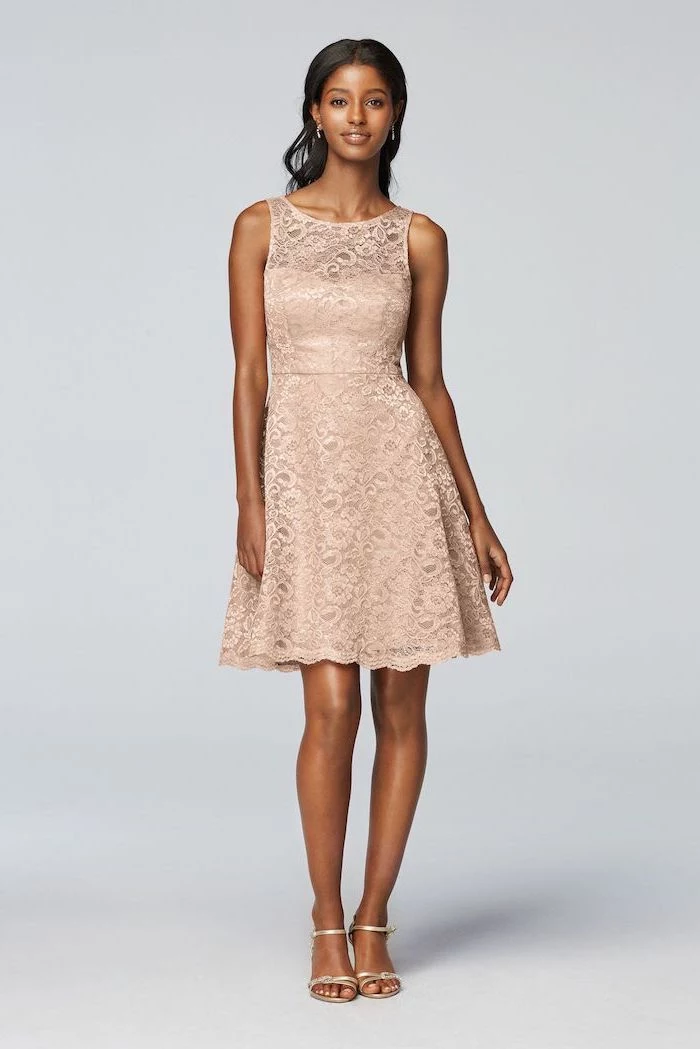
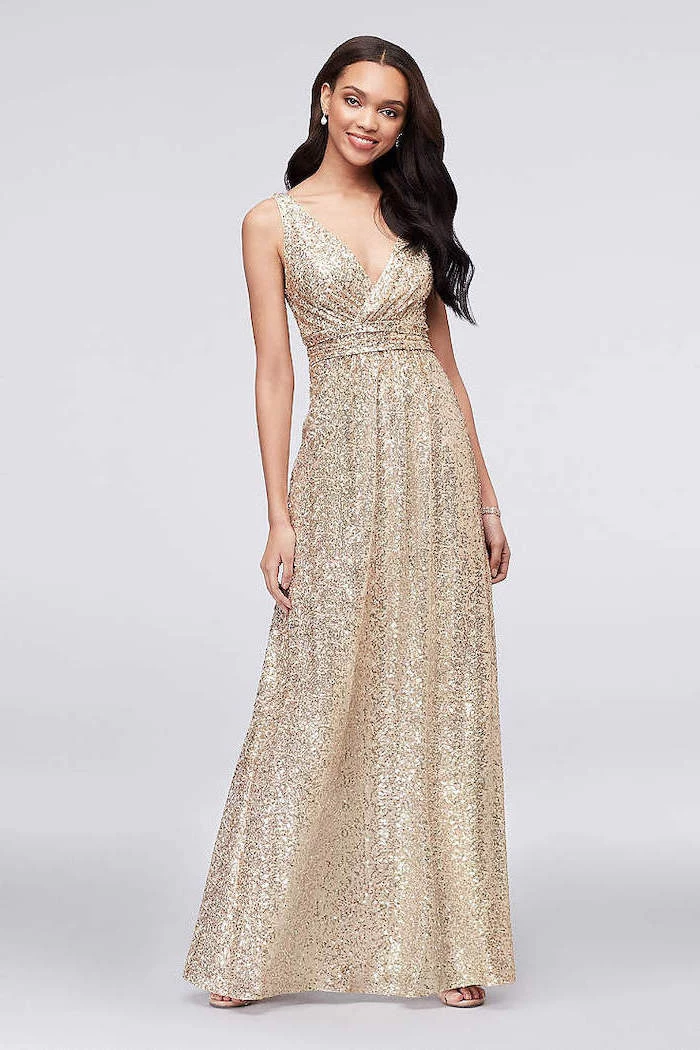
Important point: A gold dress doesn’t live in a vacuum. Consider the groom and groomsmen’s attire. A classic black tuxedo is a foolproof pairing for ultimate formality. For a softer look, a navy or deep charcoal grey suit complements gold tones without competing. A small detail, like a gold tie or pocket square, can tie the whole wedding party’s look together.
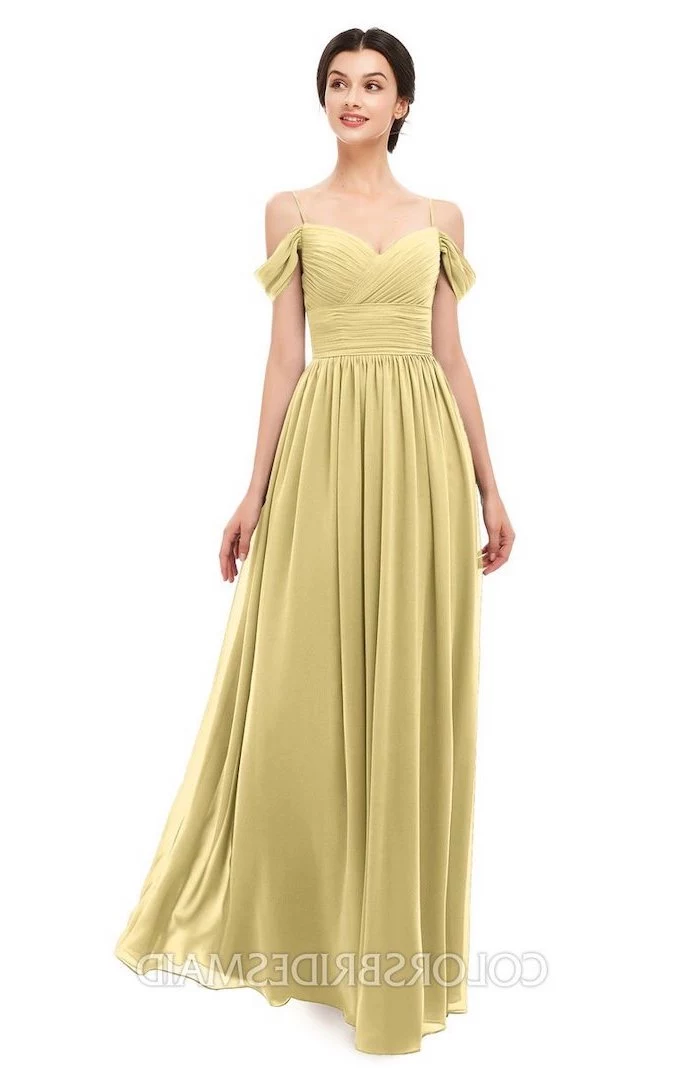
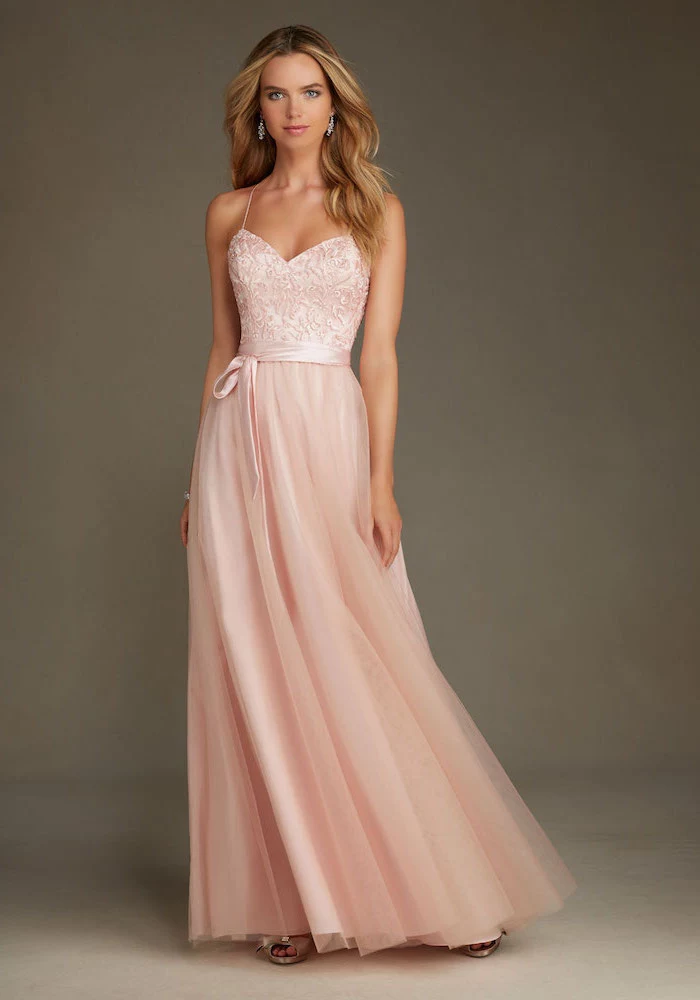
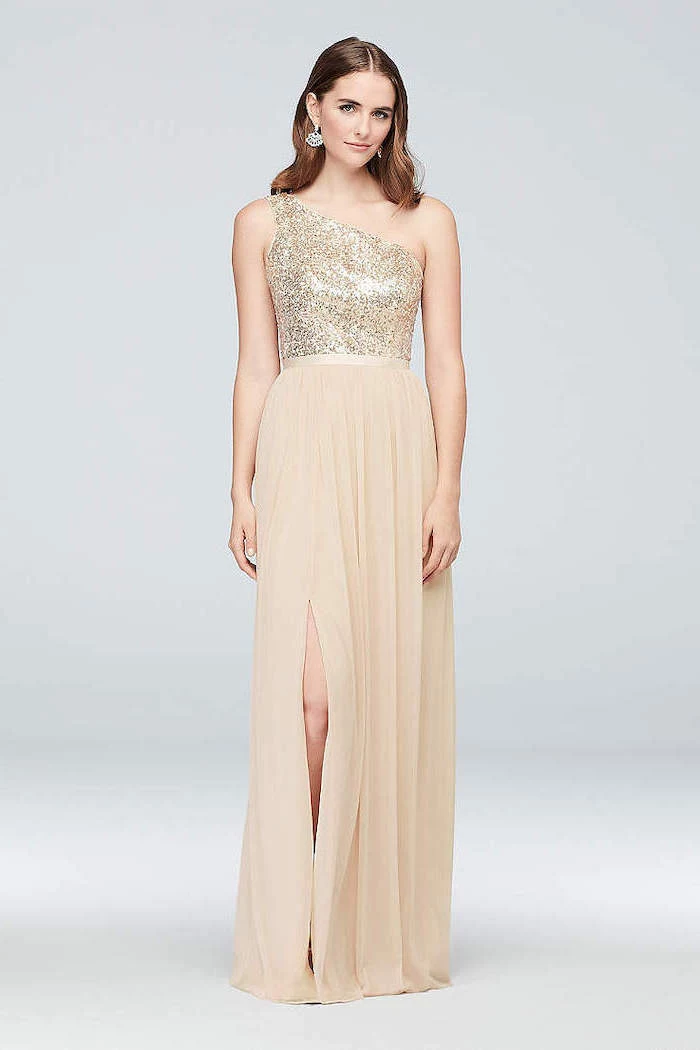
- For Autumn/Winter Weddings: Lean into deeper, richer tones like antique gold, bronze, or copper. These shades harmonize with the season’s natural palette and look incredible with velvet accents or faux-fur stoles.
- For Spring/Summer Weddings: Opt for brighter, lighter golds. Pale yellow gold, champagne, and rose gold feel fresh and airy, perfectly suiting a garden party or beachfront ceremony.
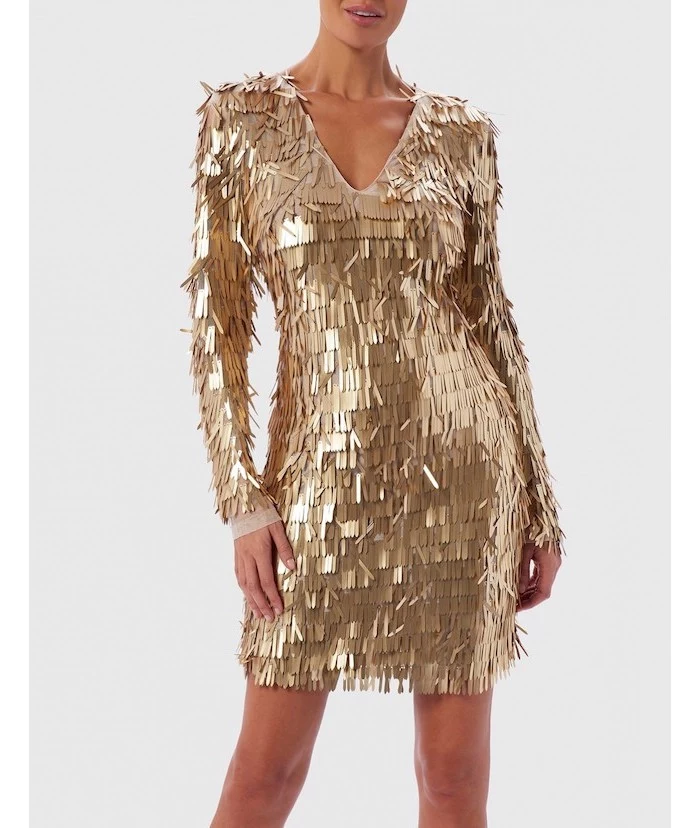
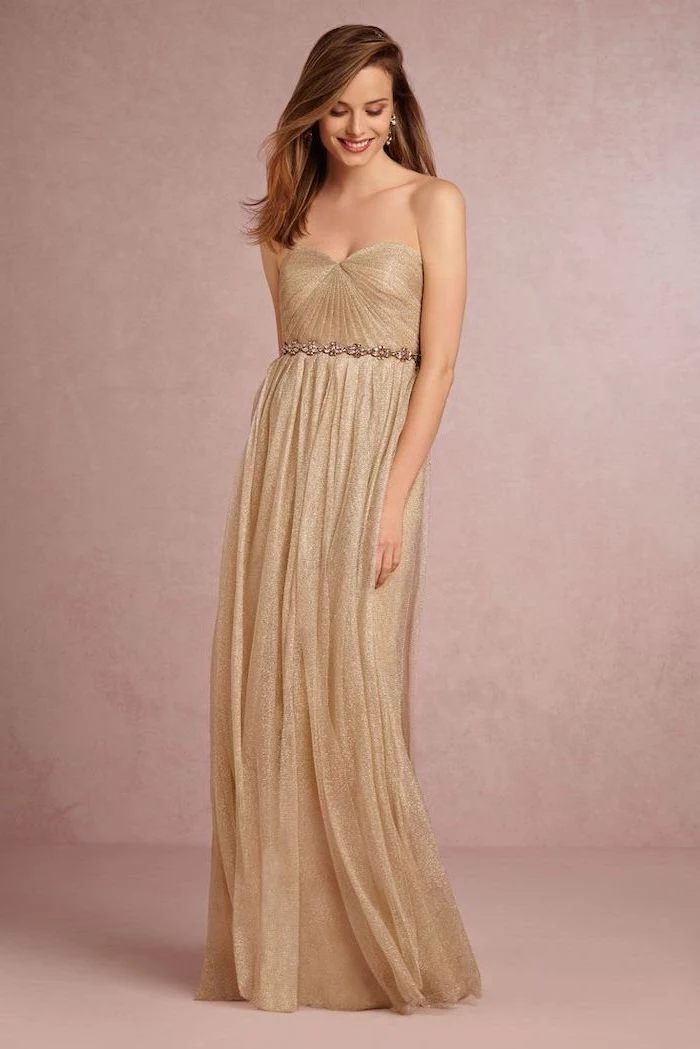
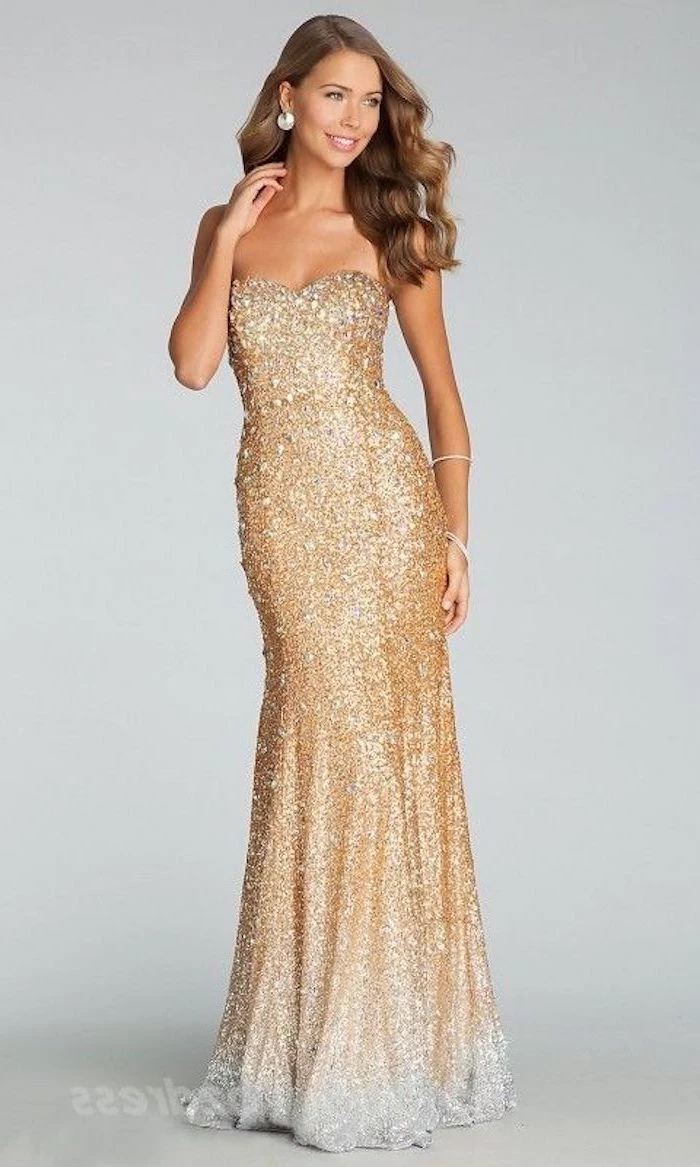
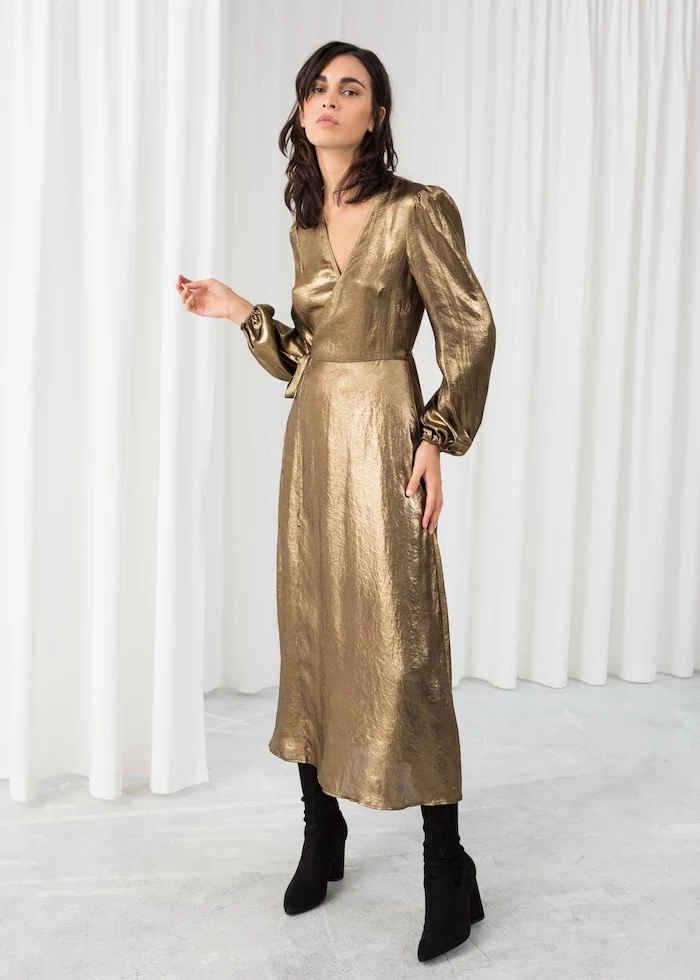
The magic of a gold dress truly ignites under specific lighting. Imagine an outdoor ceremony as the sun sets—the ‘golden hour’ light will make the dresses glow. At an indoor, candlelit reception, the fabric will catch the flickering light, creating a warm, romantic, and incredibly dynamic atmosphere that looks stunning both in person and on video.
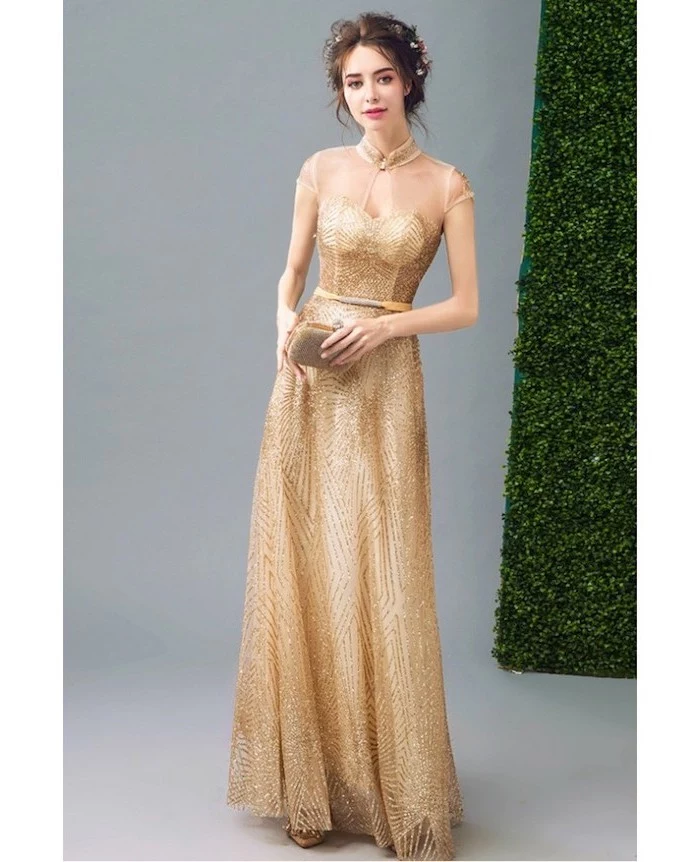
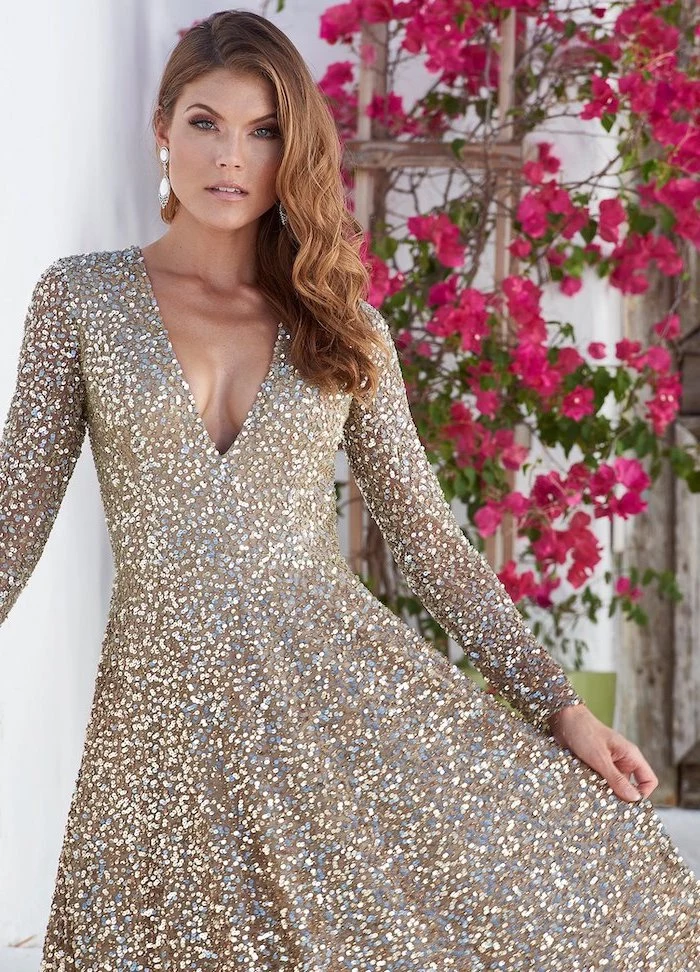
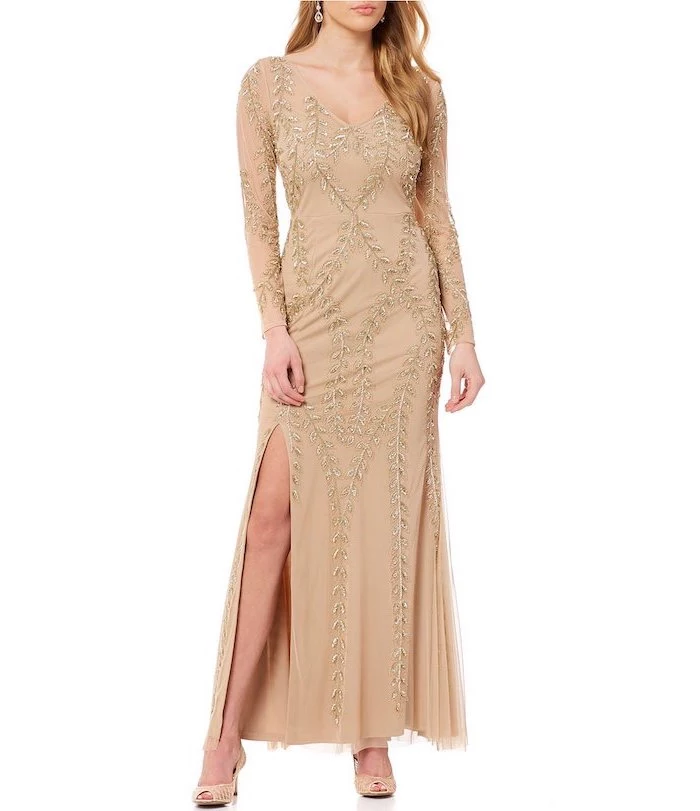
Renting: Services like Rent the Runway or Nuuly offer designer bridesmaid dresses for a fraction of the retail cost. It’s a sustainable and budget-friendly option, especially if your bridesmaids are unlikely to wear the dress again.
Buying: A great choice if you want custom alterations or if the dress is a classic style that can be worn again. Brands like Revelry offer a wide range of sizes and affordable, made-to-order options.
The best path depends on your budget and desire for a perfectly tailored fit.
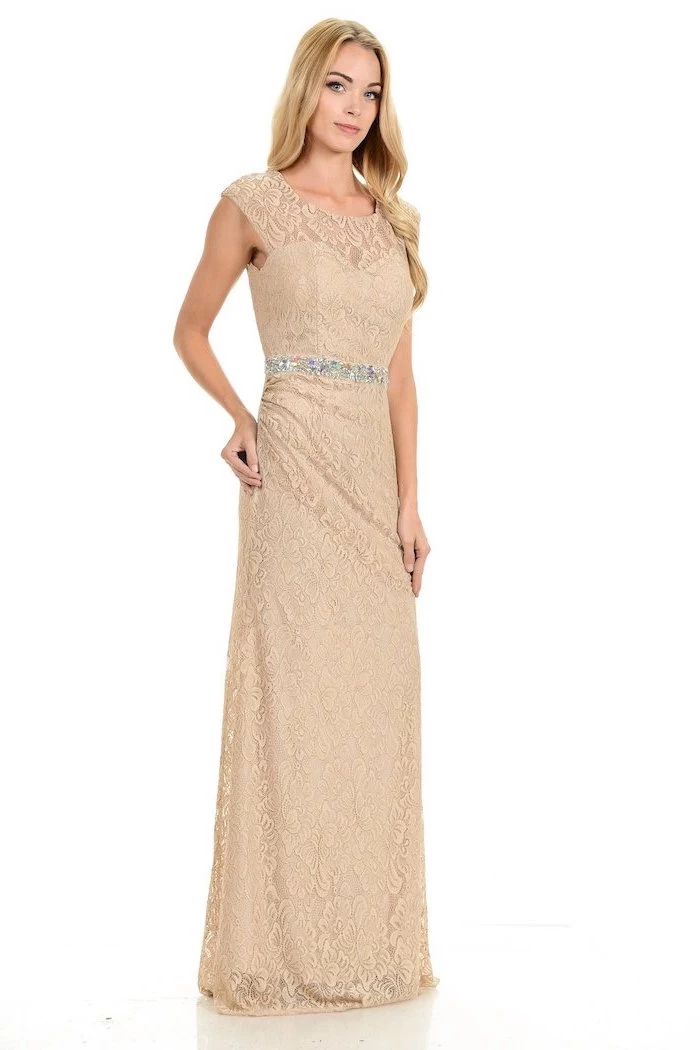
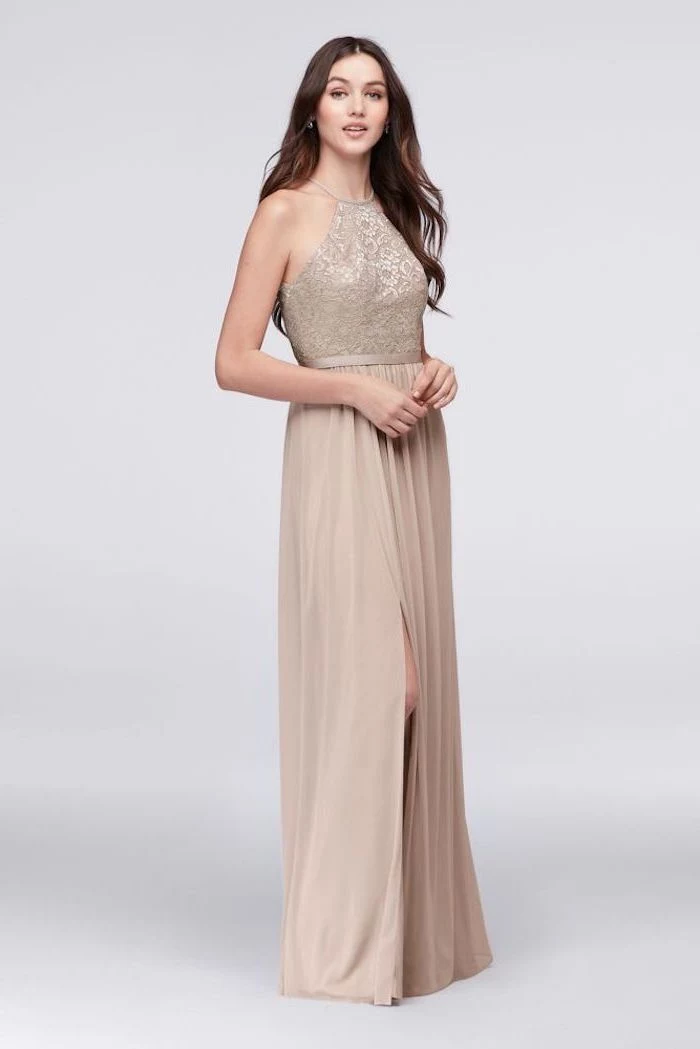
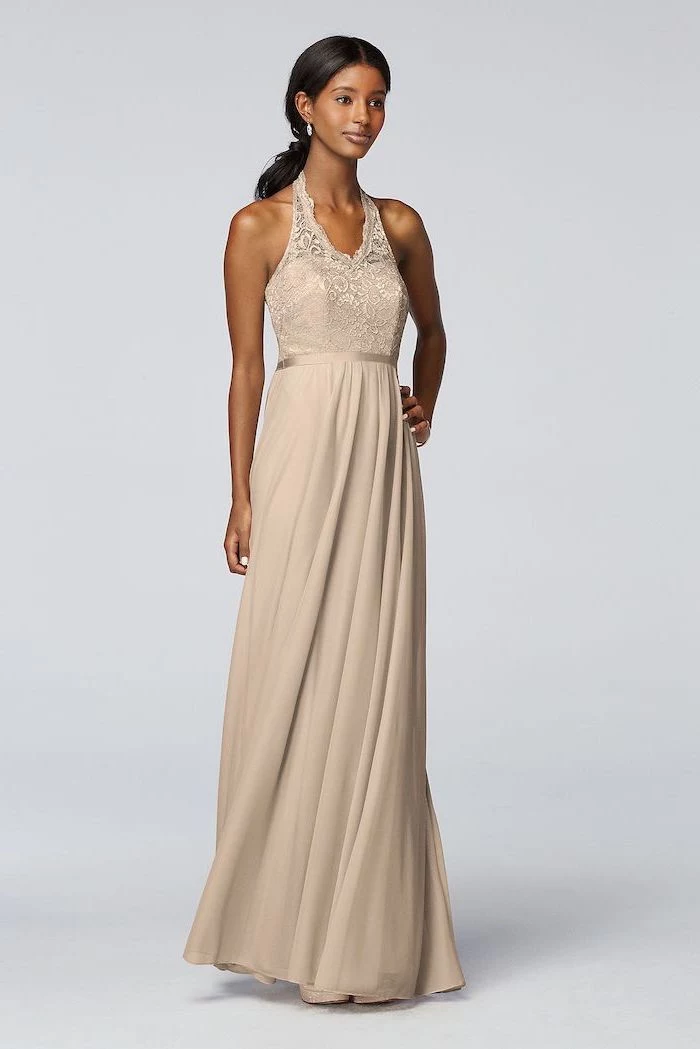
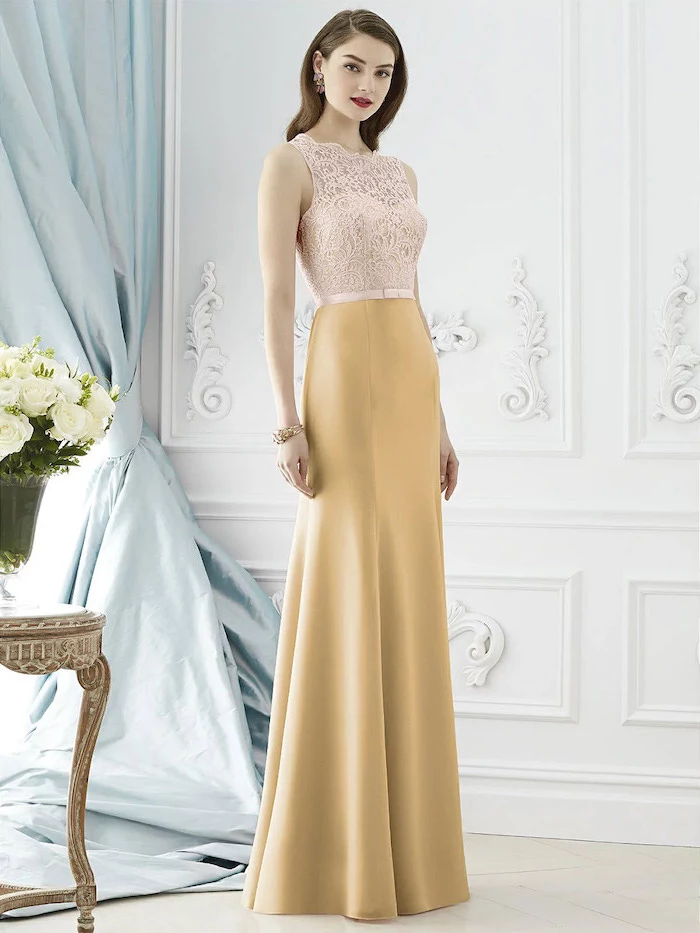
A full-length, fully sequined dress can weigh between 3 to 5 pounds (1.4 to 2.3 kg).
This might not sound like much, but after several hours of photos, dancing, and mingling, the weight can become noticeable. If your wedding is in a hot climate or involves a lot of activity, consider lighter options like chiffon with gold accents, a shorter sequin dress, or a two-piece set.
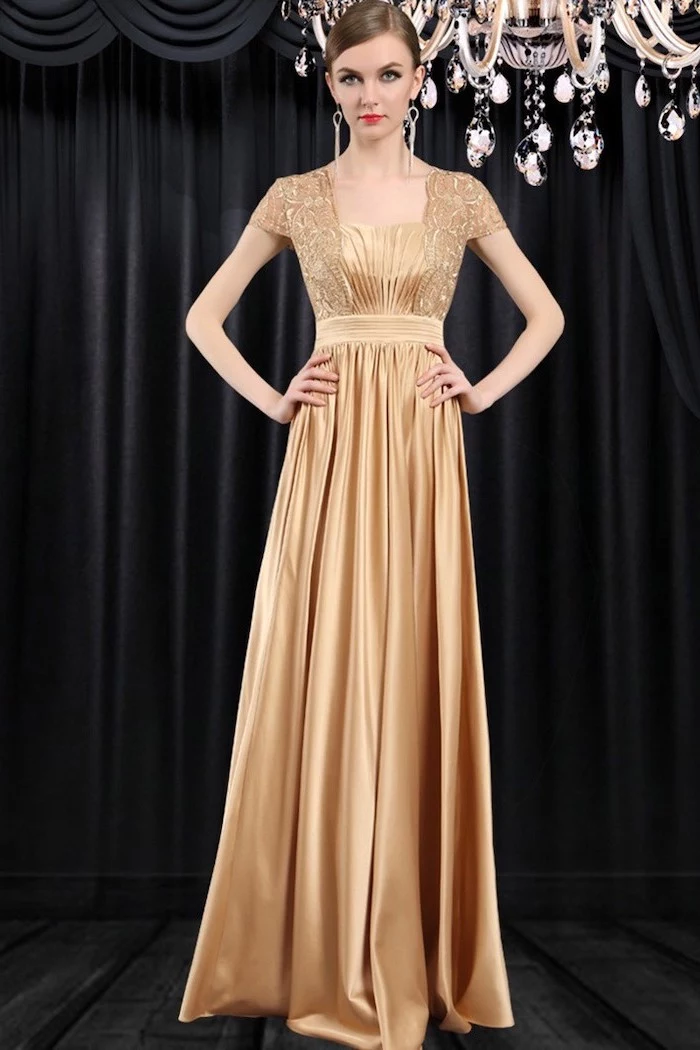
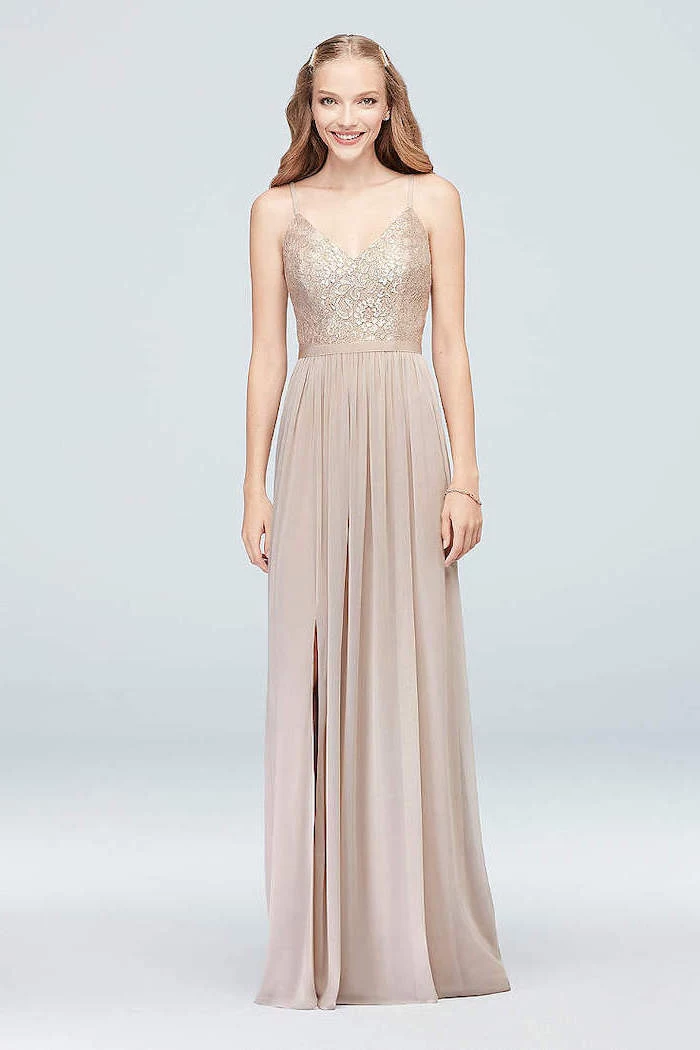
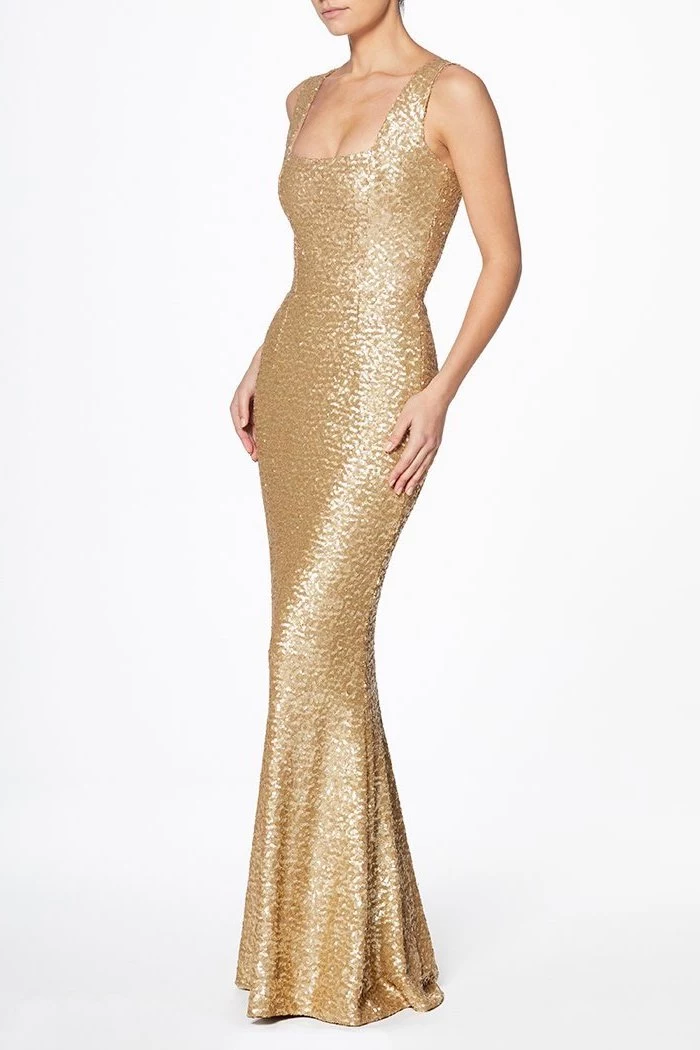
Let’s not forget the Art Deco influence. The glamour of the 1920s is a huge inspiration for modern gold bridesmaid dresses. Think geometric beading, dropped waists, and fluid, column-like silhouettes. Pairing a ‘Great Gatsby’ inspired gold dress with a feather accessory or a deep berry lip is a sophisticated nod to a timelessly chic era.
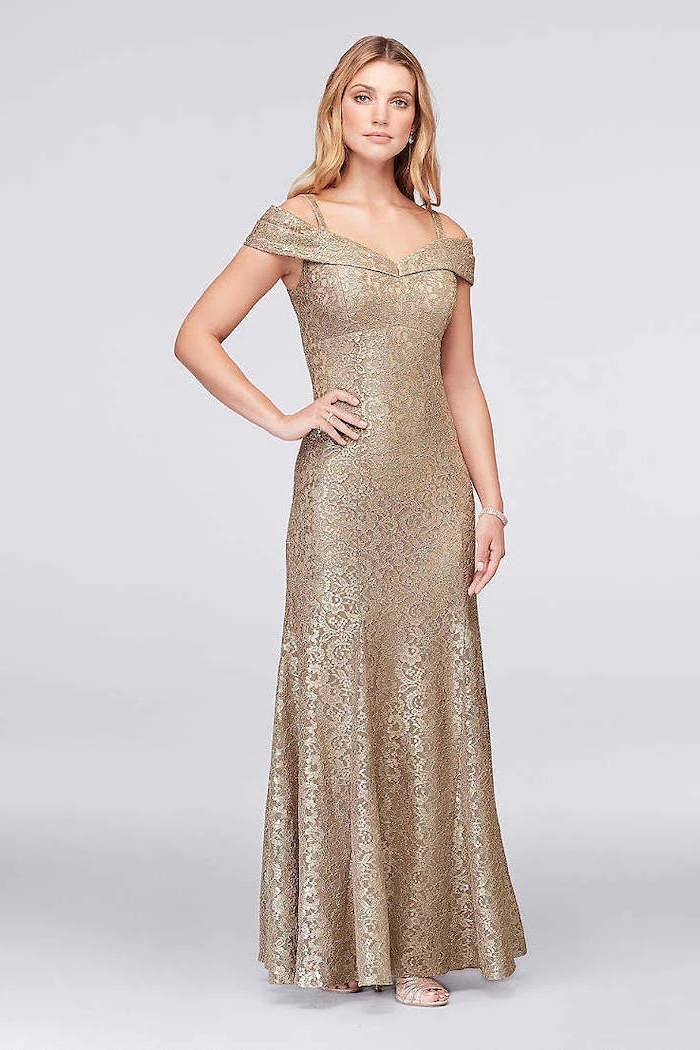
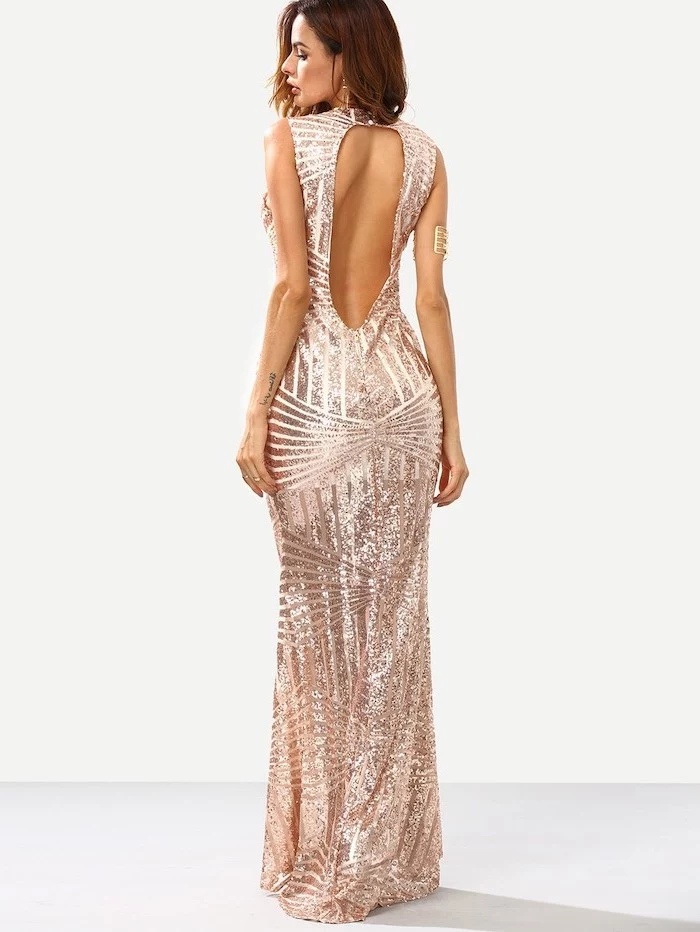
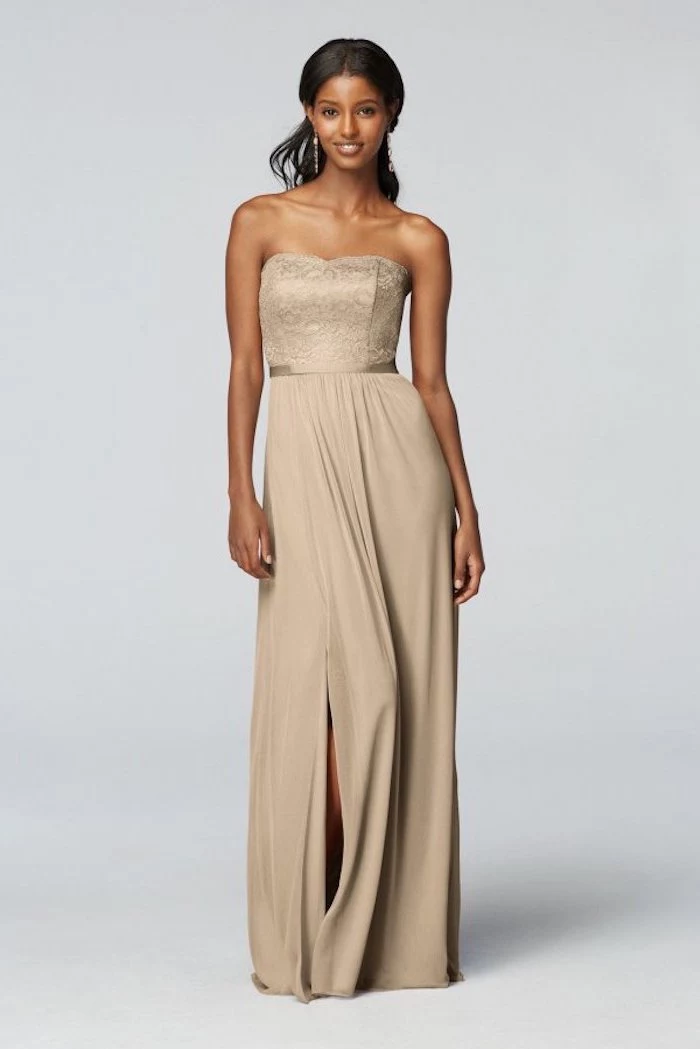
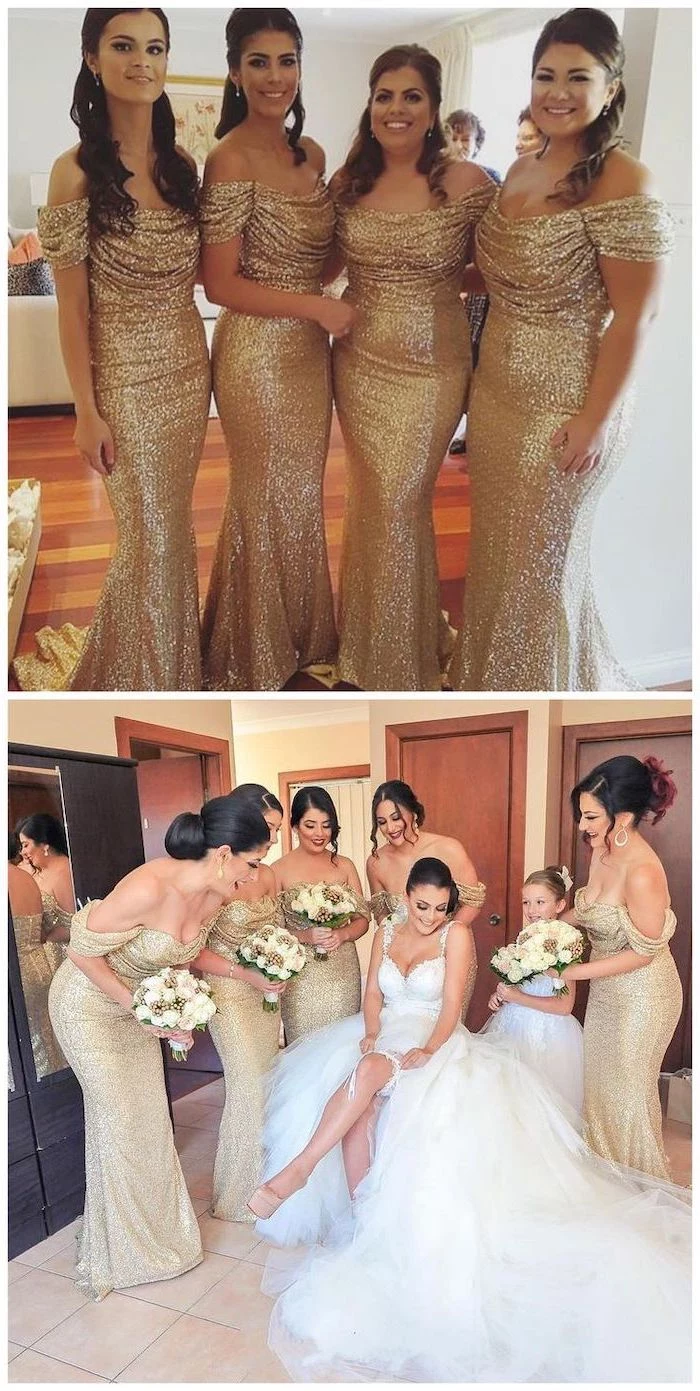
- Jewelry: Keep it simple. The dress is the statement. Delicate gold earrings or a simple bracelet is enough. Avoid necklaces unless the neckline is very simple and strapless.
- Clutch: Opt for a neutral clutch in nude, black, or even a texture like velvet in a complementary jewel tone (like emerald or ruby).
- Wrap: For cooler evenings, a simple pashmina in ivory, black, or burgundy works better than adding another metallic element.
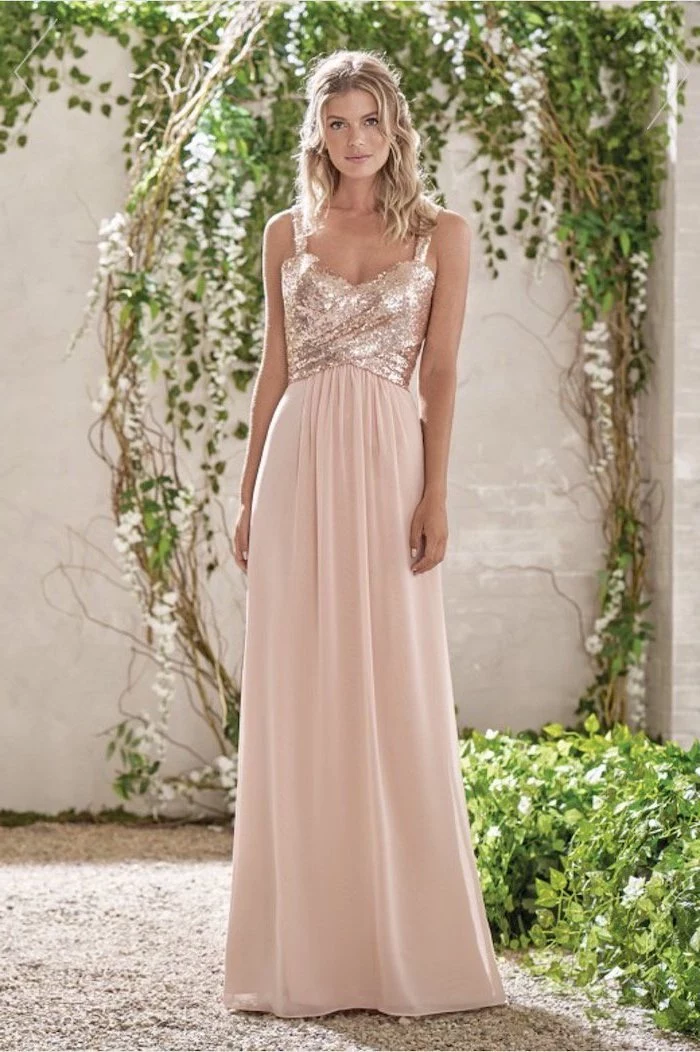
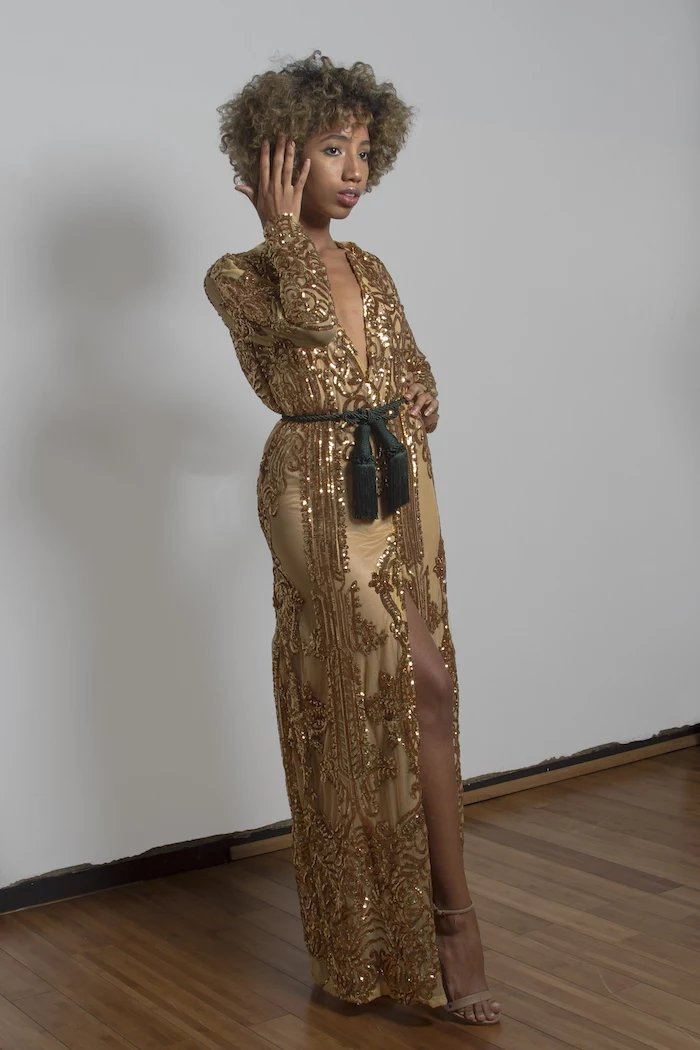
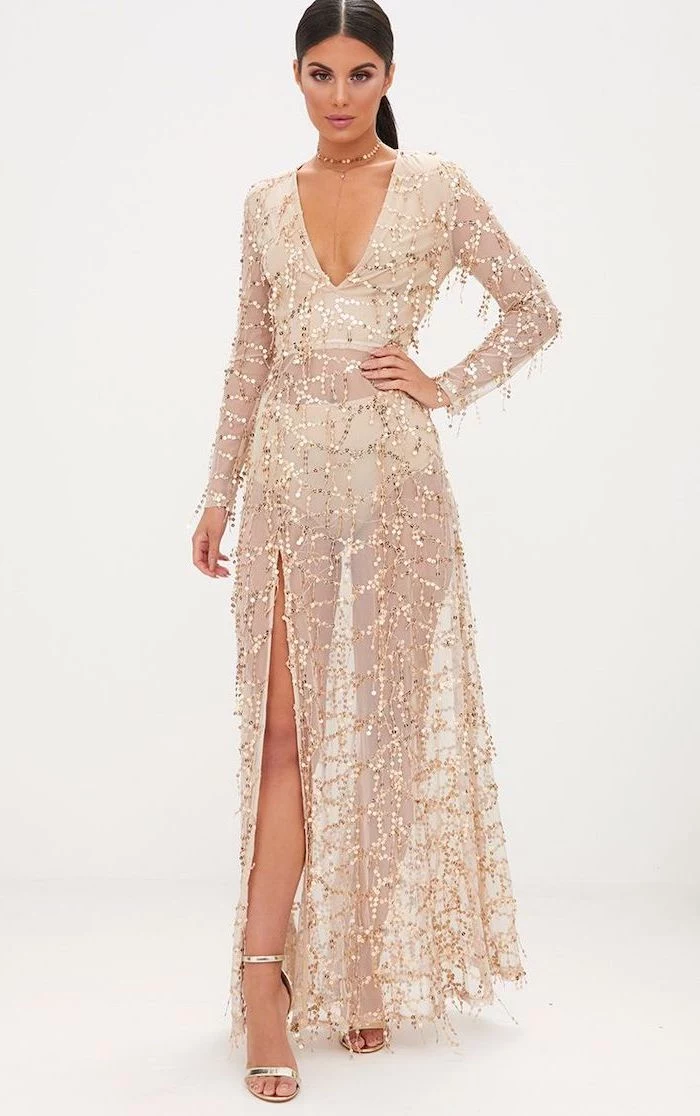
Can you mix gold with other metallics?
Tread carefully here. While a pro stylist can pull it off, it’s a risky move for a bridal party. The safest and most elegant approach is to stick to one metallic family. If the dresses are gold, all visible accessories—from jewelry to shoe buckles to hairpins—should be in the gold, brass, or bronze family to create a harmonious and intentionally designed look.
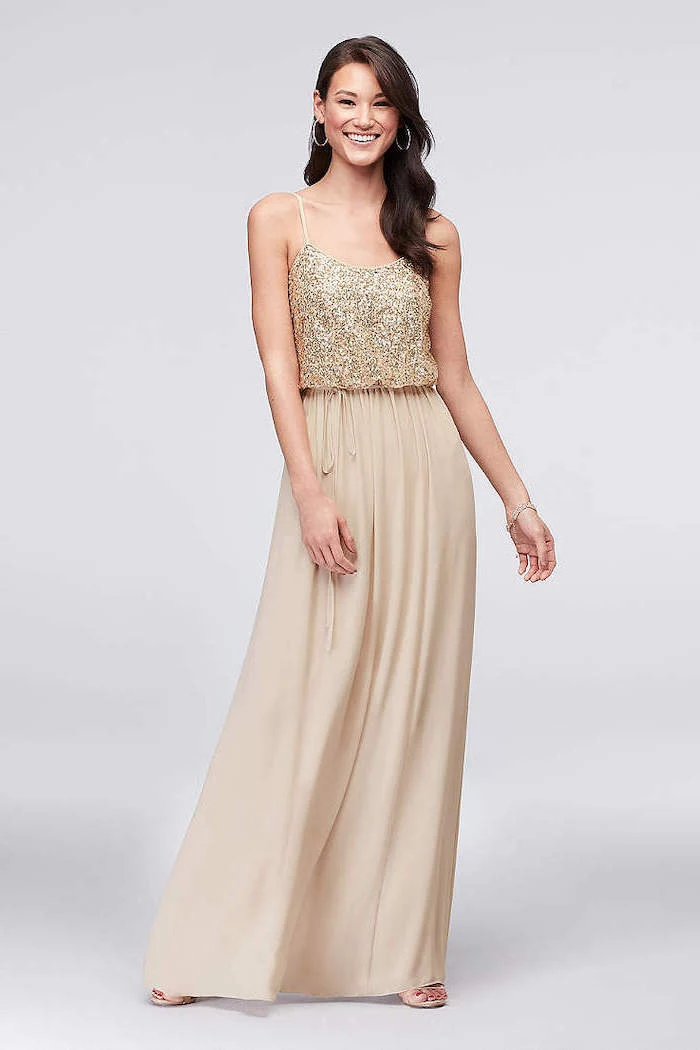
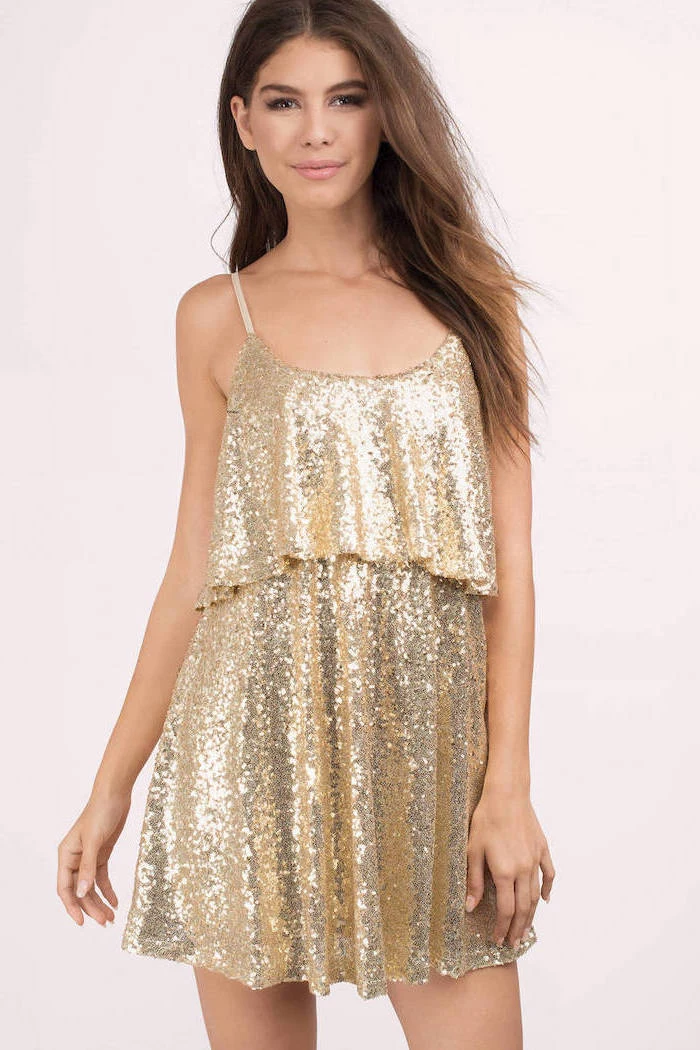
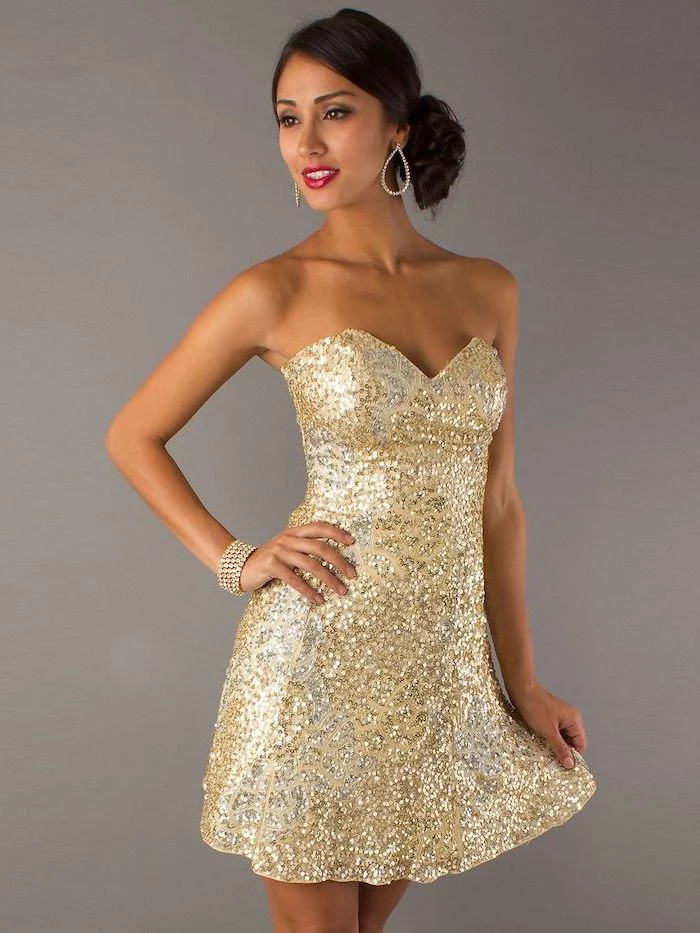
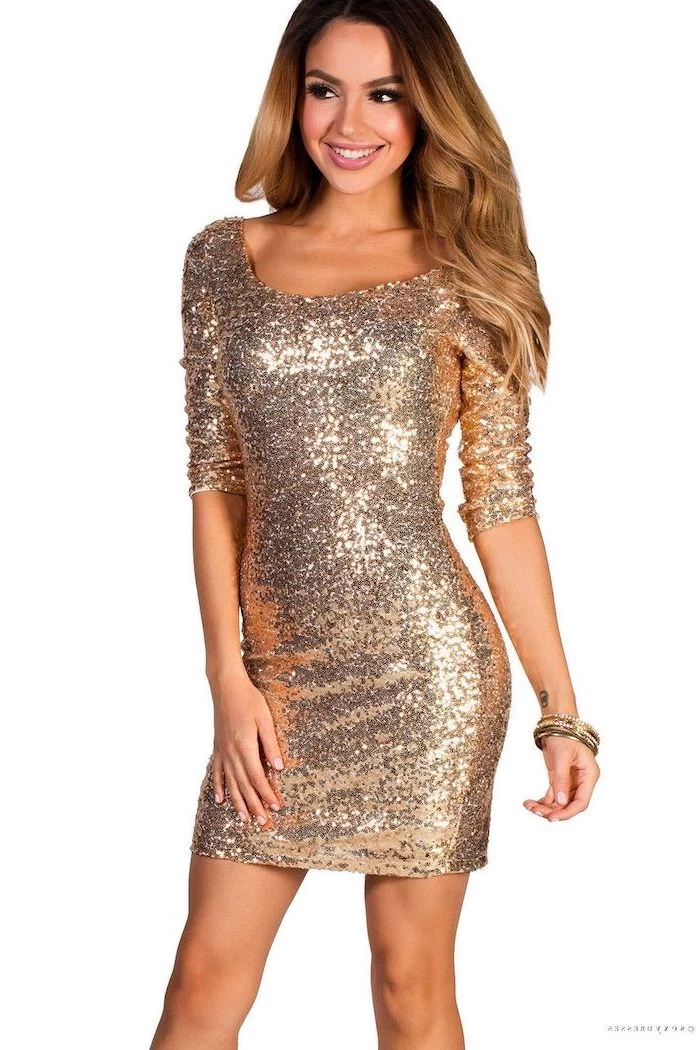
Budget-friendly doesn’t have to mean cheap-looking. When shopping for more affordable gold dresses, prioritize fabric. Look for matte sequins or a heavy crepe-back satin. Avoid thin, overly shiny materials that can look plastic-like in photos. Brands like Lulus and ASOS Design often have excellent, well-reviewed options if you read the descriptions and customer photos carefully.

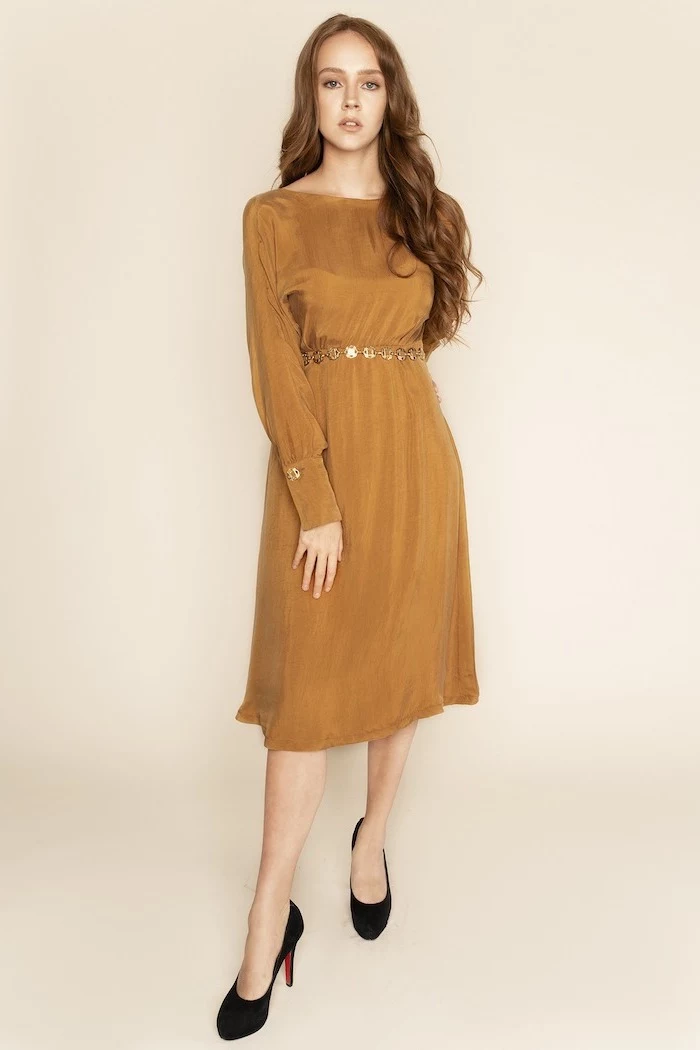
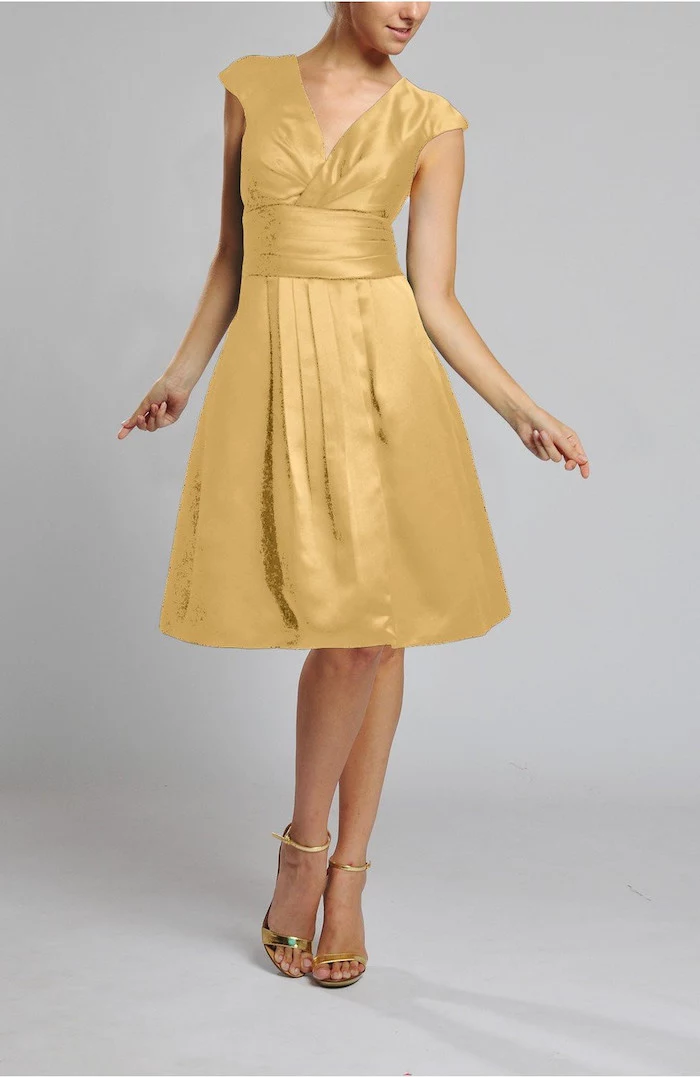
- All zippers and clasps work smoothly.
- The hemline is even and hits at the right length with the actual wedding shoes on.
- There are no gaps at the bust or armholes.
- She can sit, walk, and raise her arms comfortably.
This is the final check-in! Do it 2-3 weeks before the wedding to leave a small buffer for any last-minute tweaks.
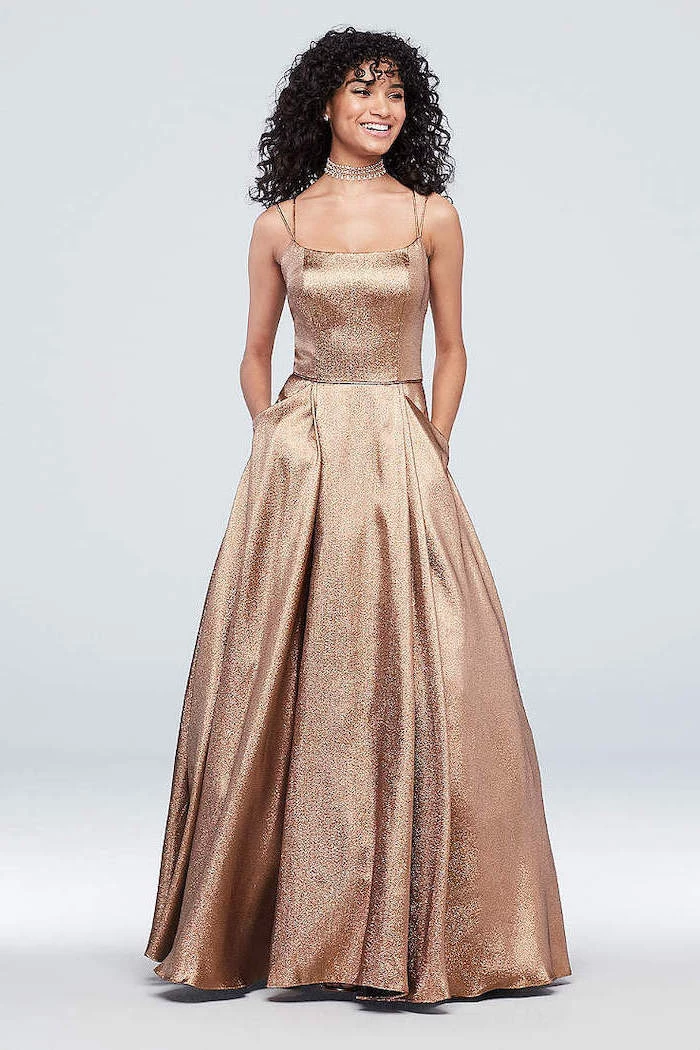
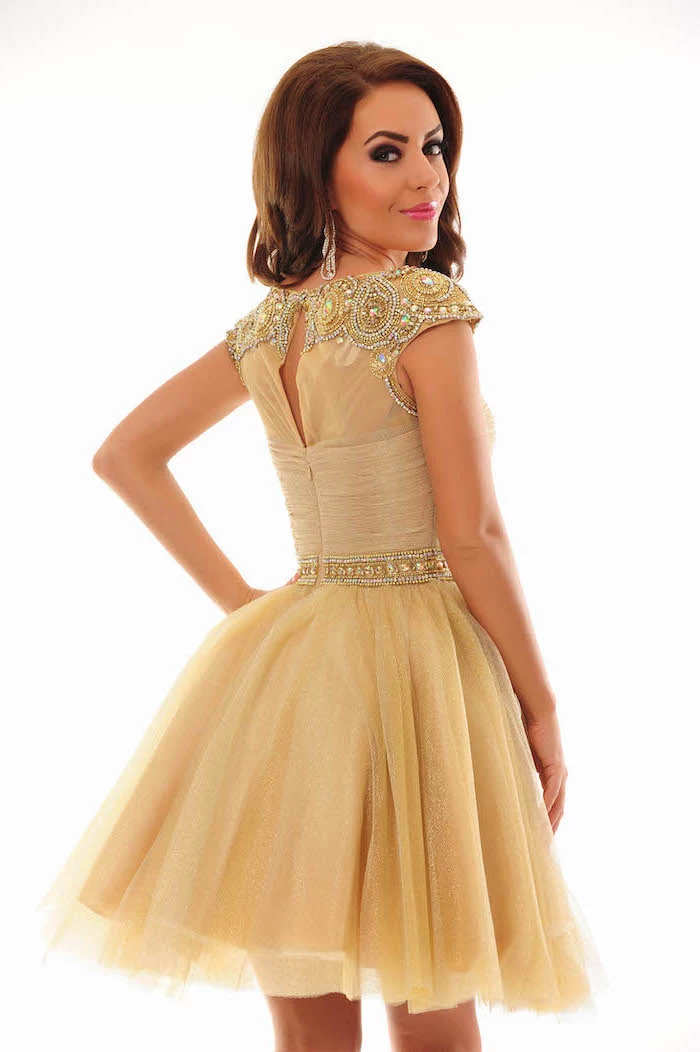
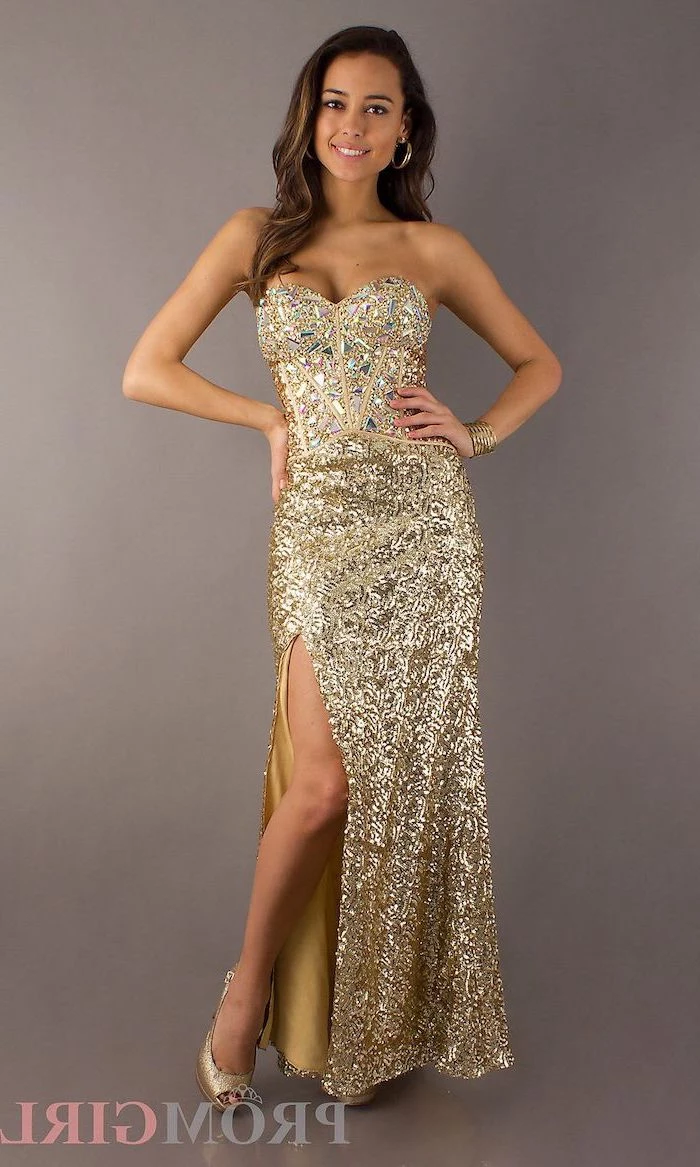
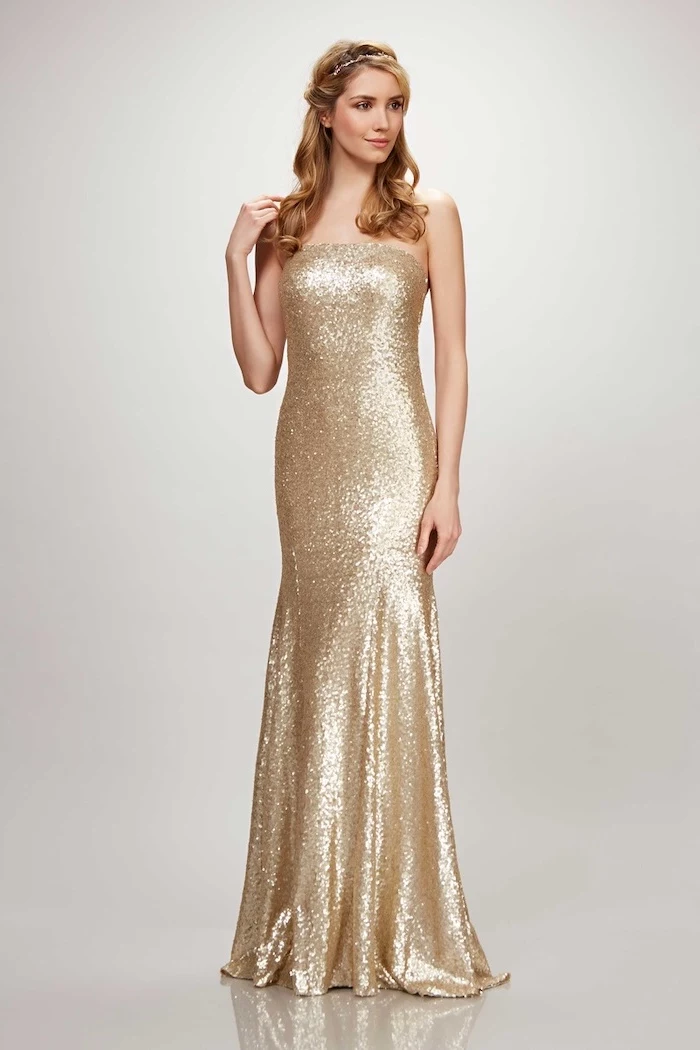
If your bridesmaids are scattered across the country, coordinating can be a challenge. Use a ‘try-at-home’ program, offered by brands like Azazie or Revelry. This allows each person to order sample dresses to check the fit, feel, and exact color in their own home before committing to a final purchase, ensuring everyone feels confident in the choice.
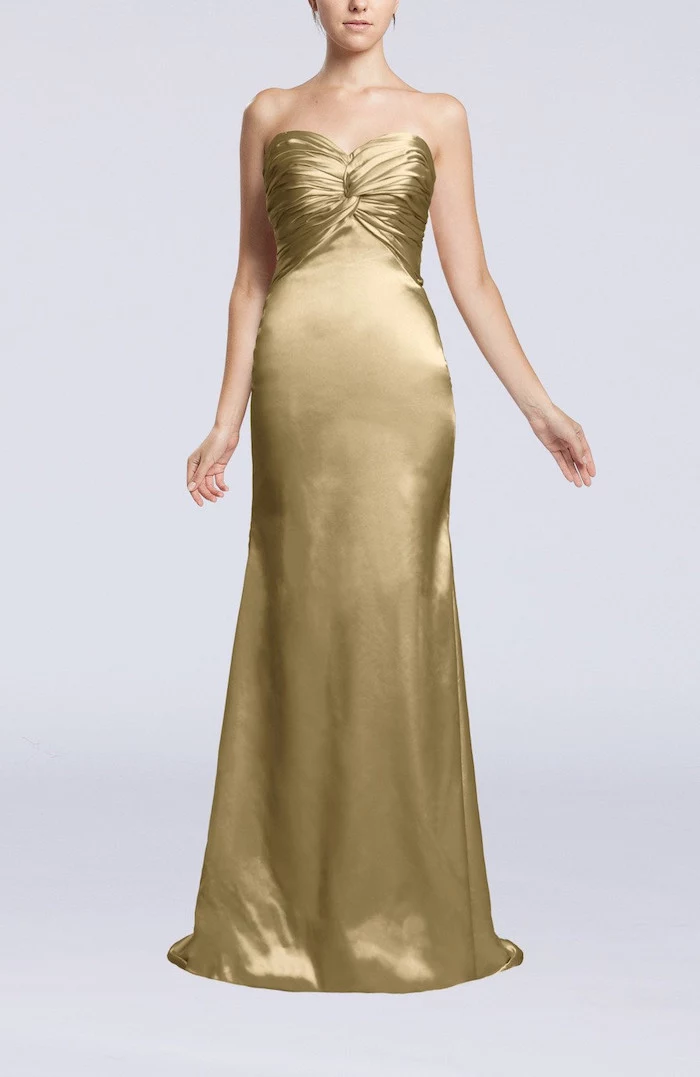
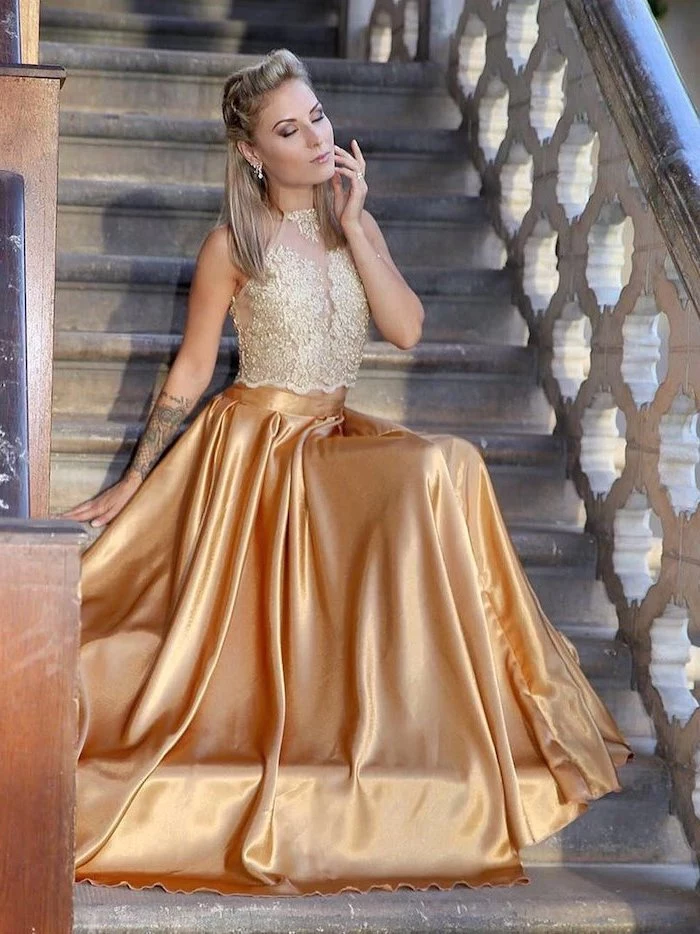
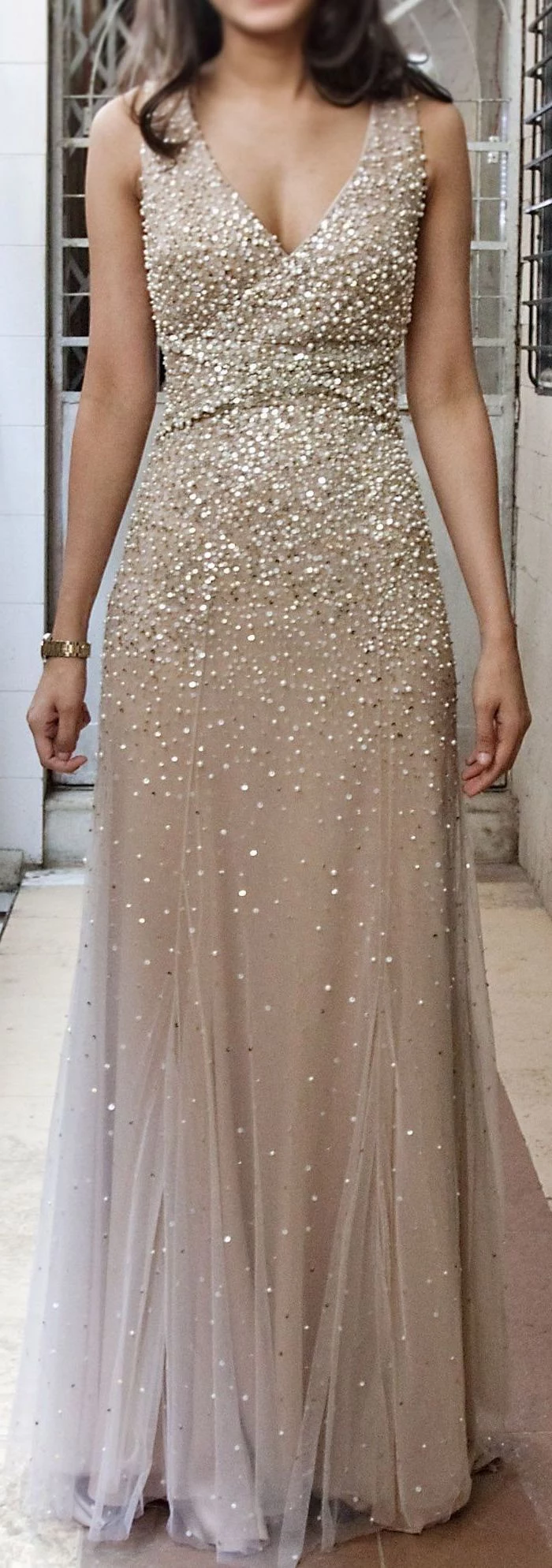
After the wedding, don’t just store the dress away. A professional dry cleaner that specializes in delicate fabrics is a must, especially for sequins or satin. Ask them specifically about treating metallic fabrics to prevent discoloration. Store it in a breathable garment bag, not plastic.
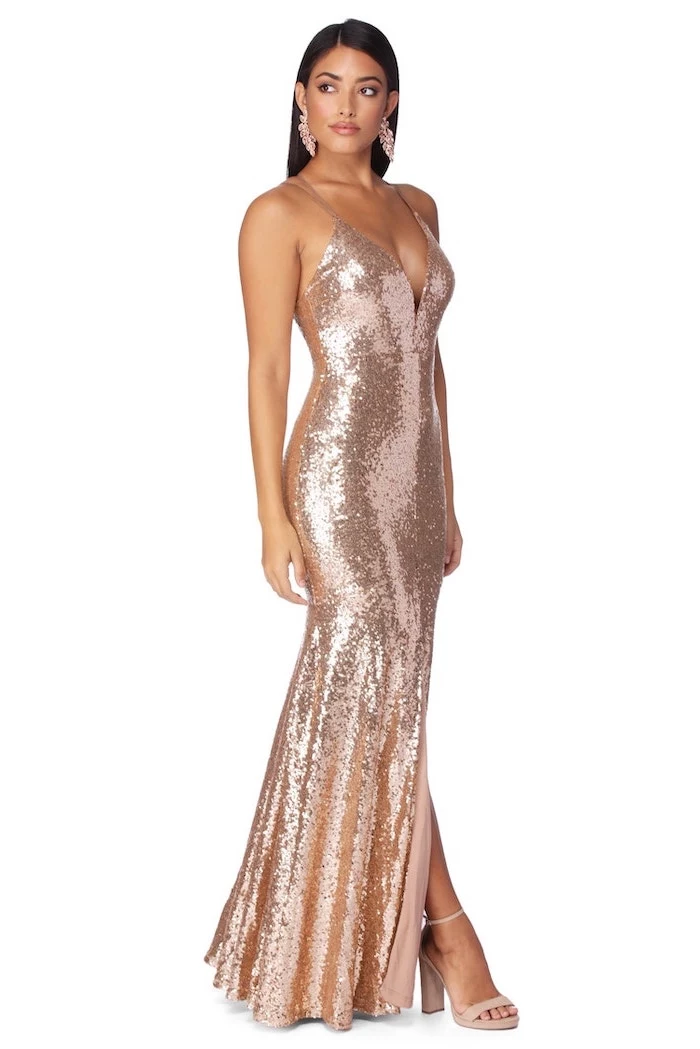
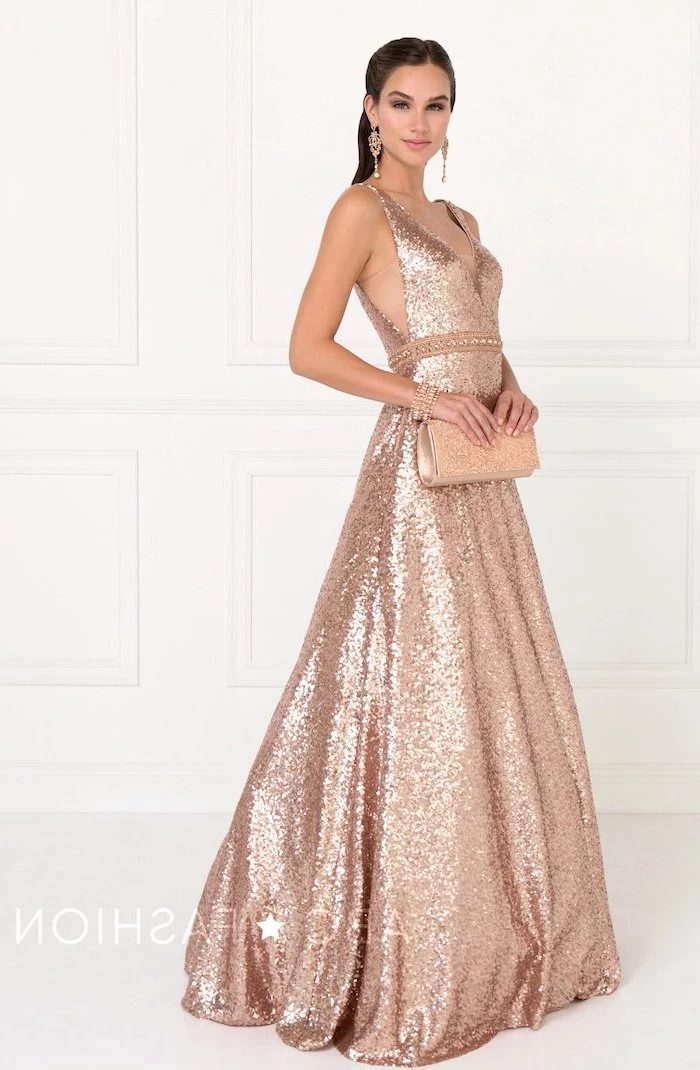
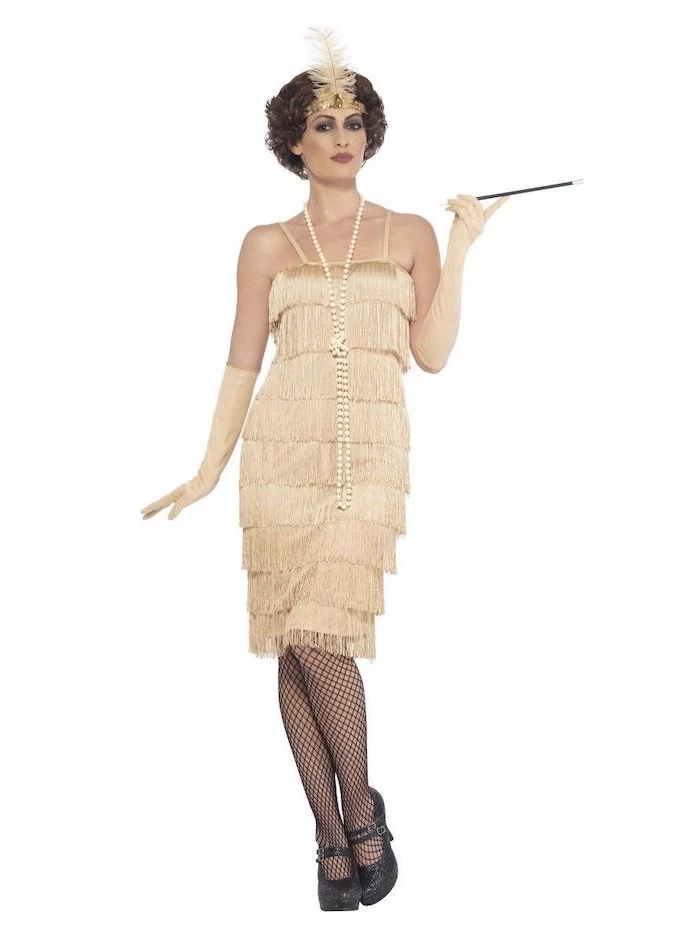
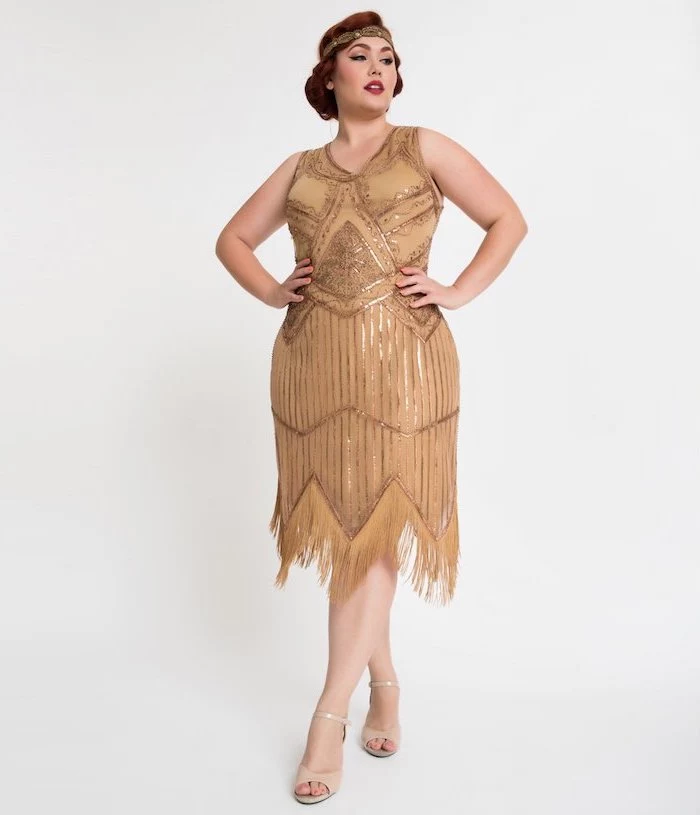
Important tip for travel: If bridesmaids are flying in for the wedding, advise them to pack their gold dress in their carry-on luggage. Never check a bridesmaid dress. It’s too risky. To minimize wrinkles in satin or crepe, roll the dress carefully with a layer of tissue paper instead of folding it.
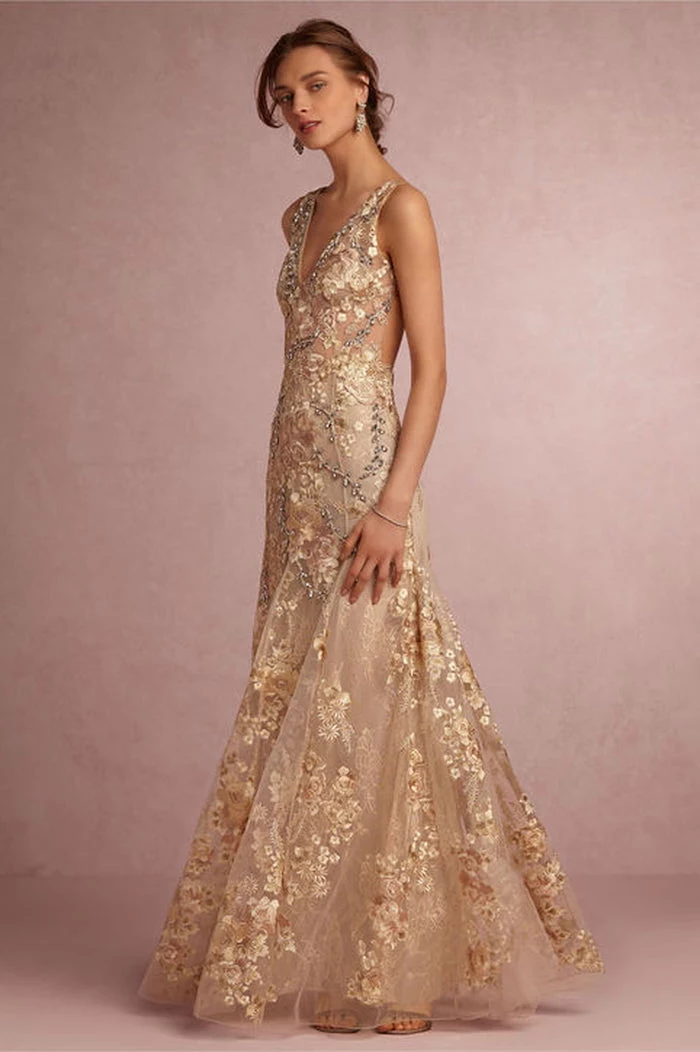
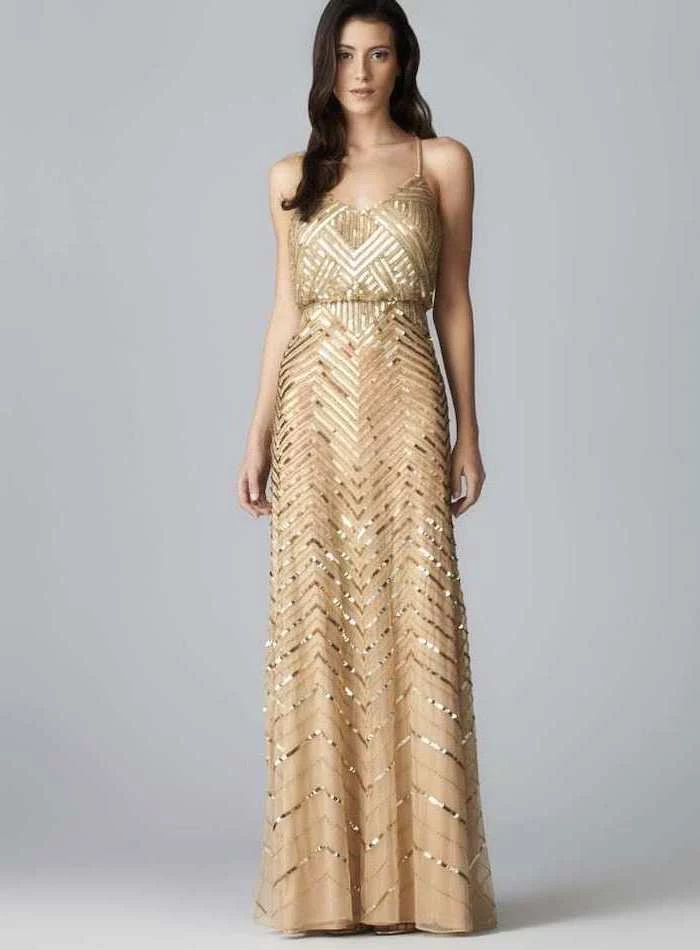
Create a stunning ombré or mixed-metal effect by assigning different shades of gold.
- For a subtle look: Use shades in the same family, from light champagne to soft rose gold to a medium antique gold.
- For a bold look: Mix warm yellow golds with coppers and bronzes.
The key to making this work is to keep the fabric consistent. If everyone is in satin, or everyone is in sequins, the look will feel intentional and chic, not chaotic.

